Braces Vs. Clear Aligners: Which Technology Is Right For You?

Choosing the right orthodontic treatment can be overwhelming, especially when deciding between traditional braces and clear aligners. Both options effectively straighten teeth and correct misalignments, but they cater to different needs and lifestyles. Understanding the differences can help you make an informed decision about which option best suits your oral health goals.
Traditional Braces: A Reliable Orthodontic Solution
Braces have long been the standard for correcting misaligned teeth and bite issues. Made of metal or ceramic brackets affixed to the teeth and connected by wires, they work their magic by gradually shifting teeth into place over time.
Benefits of Braces:
- Effective for All Cases: Braces can tackle even the most complex alignment issues, including severe crowding, overbites and underbites.
- Fixed in Place: Unlike removable aligners, braces stay on throughout treatment, making them a set-and-forget solution.
- Multiple Material Options: Patients can choose between traditional metal braces, ceramic braces or lingual braces (placed behind the teeth) for more aesthetic discretion.
Considerations for Braces:
- More Noticeable: Metal brackets and wires are visible, so some patients may find themselves feeling self-conscious.
- Dietary Adjustments: Sticky and hard foods should be avoided to prevent damaging the brackets.
- Extra Oral Hygiene Effort: Brushing and flossing require special techniques to clean around the brackets and wires.
Clear Aligners: A Modern Approach to Orthodontics
Clear aligners, such as Invisalign®, offer a nearly invisible and removable alternative to traditional braces. These custom-made plastic trays gradually move teeth into alignment through a series of adjustments.
Benefits of Clear Aligners:
- Discreet Treatment: The transparent design makes them nearly unnoticeable, making them ideal for those seeking a subtle solution.
- Removability: Being able to take them out when eating or brushing makes maintaining oral hygiene a breeze.
- Comfortable Fit: With no brackets or wires, aligners generally cause less irritation to the gums and cheeks.
Considerations for Clear Aligners:
- Requires Consistency: Aligners must be worn at least 20 to 22 hours a day to stay on track for optimal results.
- Not Ideal for Severe Cases: While they work well for mild to moderate misalignments, complex cases may require braces.
- Easy to Misplace: Since they are removable, there is a risk of losing or damaging them if not stored properly. You will want to adhere to your orthodontist’s storage recommendations.
Making the Best Choice for Your Needs
As you can see, deciding between braces and clear aligners depends on multiple factors, including the severity of your dental issues, your lifestyle and your ability to follow treatment guidelines set by your orthodontic provider. Here are some key points to help guide your decision:
- If you need comprehensive correction, braces might be the most effective choice due to their ability to address complex issues.
- If you prefer a low-profile, removable option, clear aligners hands down offer both convenience and discretion.
- If compliance is a concern, braces ensure treatment remains on track since they cannot be removed by the patient. This is a good option if you prefer to let the appliance guide your compliance without having to think about it.
- If maintaining oral hygiene smoothly is a priority, clear aligners allow for easier brushing and flossing, helping you keep your teeth and gums in optimal condition.
Final Thoughts
Because both braces and clear aligners each have their unique advantages, the right choice will ultimately depend on your unique needs and lifestyle. Consulting with our orthodontic team is the best way to determine which option aligns with your goals. No matter which path you ultimately choose to take, investing in orthodontic treatment can result in a healthier, more confident smile that lasts a lifetime.
How Early Targeted Orthodontic Screenings Better Protect Your Child’s Smile

February is National Children’s Dental Health Month, making it the perfect time to shine a spotlight on the importance of early orthodontic screenings. While many parents associate braces and orthodontic treatment with teenagers, the foundation for a healthy, well-aligned smile begins much earlier. The American Association of Orthodontists (AAO) recommends that children have their first orthodontic screening by the age of seven, even if their teeth appear straight. Here is why this early evaluation is so vital for your child’s developing oral health and overall well-being.
Identifying Issues Early
By the age of seven, children typically have a mix of baby teeth and permanent teeth, allowing an orthodontist to identify potential problems with the alignment of the teeth, jaw growth and bite. Common issues like crowding, crossbites, underbites and overbites can often be detected early, even before they become visible or cause discomfort.
Early detection is important because many orthodontic problems are easier and less invasive to treat while a child is still growing. For example, correcting jaw alignment during a child’s developmental years is far simpler than trying to address the issue later in adolescence or adulthood when growth has stopped.
Preventing More Serious Problems
One of the main benefits of early orthodontic screenings is the ability to prevent more severe dental problems from developing. If left untreated, minor misalignments in childhood can evolve into complex issues that require longer, more intensive treatment in the future. Early intervention can save time, money and potential discomfort for your child.
For instance, a child with severe crowding might benefit from early-phase treatment, such as expanders, to create space for permanent teeth as they come in. Similarly, interceptive treatment can guide the growth of the jaw, reducing the need for surgical intervention later on.
Creating a Customized Treatment Plan
Not all children who receive early orthodontic screenings will require immediate treatment. For many, the initial evaluation serves as a monitoring tool. Orthodontists can track the child’s growth and dental development, ensuring that any potential problems are addressed at the right time. If treatment is needed, our orthodontist can create a personalized plan tailored to your child’s specific needs.
This proactive approach helps parents stay informed about their child’s dental health and ensures that any necessary orthodontic treatment can be scheduled at the optimal time for the best results.
Boosting Confidence and Oral Health
As you can see, orthodontic issues are not just cosmetic; they can affect a child’s ability to speak, chew and clean their teeth effectively. Misaligned teeth can make it challenging to keep their smile clean, which may raise the incidence of tooth decay and gum disease. Addressing these issues early sets the stage for a lifetime of healthier teeth and gums overall.
Additionally, early orthodontic intervention can have a positive impact on a child’s growing self-esteem. As is the case with adults, a confident smile can help children feel more comfortable in social situations and contribute to their general emotional well-being.
Schedule Your Child’s First Orthodontic Screening
If your child is approaching (or has passed) their seventh birthday and has not yet had an orthodontic screening, now is the time to act. An early evaluation is a simple step that can significantly influence your child’s long-term oral health and quality of life. By catching potential problems early, you are giving your child the gift of a healthier, happier smile for many years to come. What better way to help their smile and oral health thrive?
New Year, New Smile: How Starting Orthodontic Treatment in 2025 Supports Your Overall Wellness

The start of a new year is a time for fresh beginnings, goal setting and prioritizing what truly matters. If a straighter, healthier smile has been on your wishlist, there is no better time to consider embarking on your orthodontic journey than now. Beyond the obvious aesthetics, orthodontic treatment can offer profound benefits for your overall health and well-being. Join us as we explore why 2025 could be the perfect time to transform your smile—and your life.
A New Smile, a New You
Orthodontic treatment is not just about perfecting your teeth; it is about unlocking the confidence that comes with a smile you love. Whether you have been considering some type of braces or discreet clear aligners, beginning treatment in the new year sets the tone for a transformative year. Starting early in the year gives you plenty of time to see progress by key milestones, whether it is a family wedding, graduation or simply next New Year’s Eve.
The Whole-Body Benefits of Orthodontics
Your smile is more than just a pretty or handsome feature—it plays a crucial role in your overall health. Look at how aligning your teeth and jaw can support your wellness goals for 2025:
- Improved Digestion
Misaligned teeth can make it difficult to chew food properly, leading to digestive issues over time. Straight teeth allow for more effective chewing, which supports better digestion and nutrient absorption. - Better Sleep
Did you know that some orthodontic treatments can address sleep-related issues? Conditions like obstructive sleep apnea or snoring may be caused by improper jaw alignment. Orthodontic solutions, such as palate expanders or jaw realignment can improve airway health and promote restful sleep. - Reduced Risk of Gum Disease and Cavities
Crowded or overlapping teeth create tight spaces where plaque and food particles can accumulate. Straightening your teeth makes it easier to clean every surface, reducing the risk of gum disease, cavities and bad breath. - Enhanced Confidence and Stress Reduction
The psychological benefits of a confident smile should not be overlooked. Studies have shown that smiling can reduce stress levels and even boost your immune system. Investing in your smile is an investment in your overall mental and emotional well-being.
Why the New Year Is the Ideal Time to Start
There is something empowering about beginning a new journey in the new year. Starting orthodontic treatment aligns perfectly with your New Year’s resolutions, setting a positive tone for months to come. By this time next year, you could be well on your way to a smile you are proud to share with the world.
Additionally, many insurance plans reset in January, which means you may have access to fresh benefits to help cover the cost of treatment. Early planning ensures you maximize these benefits while kickstarting your orthodontic progress without delay. Starting now also allows you to take advantage of our orthodontic provider’s availability before schedules get busier in the months ahead.
Ready to Begin Your Smile Transformation?
Consider letting 2025 be the year you prioritize yourself and your health. Whether you are interested in traditional braces or clear aligner treatment, a consultation about sleep-related concerns, a healthier, straighter smile—and the confidence and wellness that come with it—are waiting. Our experienced orthodontic team invites you to reach out to schedule your consultation today and take the first step toward your best self. The sooner you begin, the sooner you will see the amazing benefits of a smile transformation unfold!
Innovative Orthodontics: A Surprising Focus On TMJ Awareness Month

The holiday season is a time for gathering with loved ones, enjoying festive foods and for some, embarking on long-awaited trips. If you are wearing braces or clear aligners, maintaining a healthy smile while traveling does not need to be stressful. With a little planning and some smart strategies, you can keep your orthodontic treatment on track and ensure your smile remains happy.
Pack a Travel-Ready Oral Care Kit
Before you hit the road, prepare a travel-friendly oral care kit. Include essentials such as a travel-sized toothbrush, fluoride toothpaste, dental floss of choice and an interdental brush. If you wear clear aligners, do not forget your aligner case and cleaning solution. For braces, orthodontic wax for any potential irritation is a must. Keeping these items easily accessible can help you stay consistent with your oral hygiene routine on the go.
Stick to a Consistent Cleaning Schedule
No matter where your holiday adventures take you, maintaining your regular oral care routine is crucial. Brush your teeth after every meal, ensuring you clean around brackets and wires if you have braces. For clear aligners, brush your teeth before putting your aligners back in to avoid trapping stray food particles. If brushing is not immediately possible, rinsing your mouth with water is a helpful temporary solution.
Be Mindful of Festive Holiday Treats
The holidays bring an array of tempting treats, but some can pose challenges for those in orthodontic treatment. If you wear braces, avoid sticky or hard candies, popcorn and crunchy nuts that can damage vital brackets and wires. Opt for softer choices like mashed potatoes, cooked vegetables or small pieces of turkey. For aligner wearers, remember to remove your aligners before eating and thoroughly clean your teeth before reinserting them.
Stay Hydrated
Did you know that traveling, especially during holiday celebrations can lead to dehydration, which can impact your oral health? Not to mention that drinking water throughout the day helps rinse away lingering food particles and bacteria, keeping your teeth and gums clean and healthy. Staying hydrated is especially important for aligner wearers, as it can prevent aligners from feeling dry or uncomfortable in your mouth.
Keep Emergency Supplies on Hand
Even with the best preparation, orthodontic issues can arise while traveling. If you wear braces, pack a small amount of orthodontic wax to address any irritation caused by loose brackets or wires. Clear aligner users should bring their previous and next sets of aligners in case of loss or damage. Having these extra items on hand can minimize stress and help you manage minor problems until you can see our orthodontist.
Maintain Your Wear Time
For those wearing clear aligners, maintaining the recommended wear time—typically 20 to 22 hours a day—is essential. Holiday activities can make it tempting to leave your aligners out for extended periods, but this can also delay your treatment. Set reminders if needed, and prioritize wearing your aligners as directed for optimal progress.
Schedule a Post-Holiday Check-Up
Once your holiday travels are over, schedule a check-up with our orthodontist to ensure your treatment is progressing as planned. We can address any concerns and make adjustments if necessary.
Happy Holidays!
With a bit of preparation and diligence, you can enjoy anticipated holiday travels while keeping your smile healthy and your orthodontic treatment on track. By sticking to your routine and making mindful choices, you are one step closer to achieving the smile of your dreams and making your orthodontic treatment a success. From our orthodontic family to yours, we wish you happy travels throughout this festive season!
Innovative Orthodontics: A Surprising Focus On TMJ Awareness Month
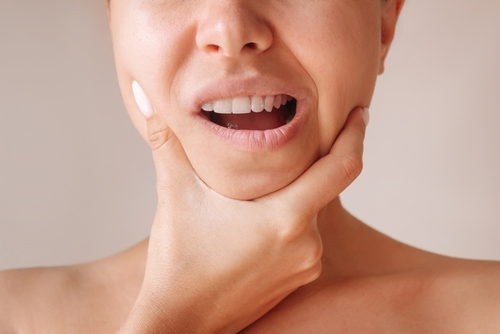
Orthodontic care goes beyond creating a beautiful smile; it plays a crucial role in maintaining your overall health, including the health of your temporomandibular joints (TMJs). With November marking TMJ Awareness Month, it is a great time to explore how orthodontic treatments can alleviate TMJ-related issues, improve jaw function and support a healthier life.
Understanding the Temporomandibular Joint (TMJ) and Its Role
The temporomandibular joint connects your jawbone to your skull, allowing for essential movements like chewing, speaking and yawning. This joint is complex and can be sensitive to misalignment or strain, leading to disorders commonly referred to as TMJ disorders or TMD (temporomandibular joint disorders). TMD symptoms range from mild to severe, including jaw pain, headaches, facial discomfort and even difficulty chewing. Unfortunately, millions of people experience TMJ pain, yet many remain unaware of how orthodontic treatment can alleviate or prevent these issues.
How Orthodontic Treatment Helps with TMJ Health
Orthodontic treatment focuses on aligning teeth and adjusting the bite, which has a direct impact on jaw function. A misaligned bite places uneven pressure on the TMJ, increasing the likelihood of discomfort and strain. By realigning your teeth and bite, orthodontic care can reduce the stress placed on the jaw joint, often easing or even preventing TMJ symptoms.
Reducing Jaw Strain and Preventing Pain
A common cause of TMJ pain is the additional strain placed on the jaw when the bite is not properly aligned. Misaligned teeth and bite issues, such as overbite, underbite or crossbite can force the jaw to work harder, which leads to muscle tension and joint stress. Orthodontic treatment, including braces or clear aligners, can correct these alignment issues, promoting a more natural and relaxed jaw position. For many patients, this results in reduced jaw pain, fewer headaches and an overall improvement in comfort.
Improving Facial Symmetry and Function
Orthodontic treatment also supports the development of balanced facial features and overall function. When teeth are straight and well-aligned, the jaw can rest in a more neutral position, contributing to a balanced facial structure and minimizing strain on facial muscles. Improved facial symmetry can enhance not only your appearance but also your speech, breathing and chewing functions. This holistic approach to jaw health is particularly beneficial for patients prone to TMD symptoms or those looking to prevent these issues as they age.
Long-Term Health Benefits of Orthodontic Care
Aside from TMJ health, proper teeth alignment offers several other long-term health benefits, including improved oral hygiene, reduced risk of tooth decay and better gum health. Straight, properly aligned teeth are easier to clean and less likely to trap food particles and plaque, which means a lower risk of cavities and gum disease. A healthier mouth contributes to overall well-being and decreases the likelihood of systemic issues related to poor oral health, such as cardiovascular disease.
A Proactive Step Toward Wellness
Orthodontic treatment is a proactive investment in your health. For those with TMD, or those at risk of developing it, early intervention with orthodontic care can prevent or significantly reduce symptoms. And if you are currently experiencing TMJ pain, consulting with our orthodontist may reveal that bite correction could be a viable solution to alleviate discomfort and restore normal function.
This TMJ Awareness Month, consider how orthodontic care can benefit not only your smile but also your overall health. If you are experiencing TMJ pain or want to take preventive steps, reaching out to our orthodontic team can help guide you toward a treatment plan that aligns with your needs and long-term wellness goals. You deserve a healthier, straight and pain-free smile!
Best October Surprise: How To Celebrate National Orthodontic Health Month

For our dedicated orthodontic team, October brings with it an important observance: National Orthodontic Health Month. This autumnal month serves as a relevant reminder about the critical role that orthodontics plays in achieving a healthy, aligned smile. Orthodontic treatment not only enhances the aesthetics of your smile but also significantly contributes to your overall oral health.
The Connection Between Oral Hygiene and Orthodontics
When you think of orthodontics, you might envision braces and aligners. However, the journey to a perfect smile is not just about the physical changes in your teeth; it is also about maintaining optimal oral hygiene throughout the treatment process.
When teeth are misaligned or crowded, they can be challenging to clean effectively. This makes patients more susceptible to plaque buildup, tooth decay and gum disease. For this reason, orthodontic treatment is essential for those who have dental irregularities. By correcting these issues, orthodontics helps create an environment where maintaining optimal oral hygiene is much easier.
Why Oral Hygiene Matters During Orthodontic Treatment
For those undergoing orthodontic treatment, practicing good oral hygiene is crucial. Braces and other oral appliances can trap food particles and plaque, which can lead to cavities and gum disease if not properly managed. Here are a few key practices to ensure optimal oral health during your orthodontic journey:
- Regular Brushing and Flossing: It is essential to brush your teeth at least twice a day and floss daily. Use a soft-bristled toothbrush and fluoride toothpaste to effectively clean around brackets and wires. Orthodontic flossers and interdental brushes can be excellent tools to help clean those tricky areas between your teeth and appliances.
- Routine Dental Checkups: Regular visits to your orthodontist and dentist are crucial during your treatment. They will monitor your progress, make necessary adjustments and help identify any developing oral health issues early before they cause damage to your pearly whites.
- Limit Sugary Foods and Drinks: While you may be celebrating the festive fall season, be aware that sugary snacks and beverages can contribute to plaque buildup and cavities. Opt for healthier alternatives, such as chocolate that melts easily and be mindful of sticky foods that can get caught in your braces.
- Use Mouth Guards for Sports: If you or your child plays sports, wearing a mouth guard is vital to protect your braces and teeth from potential injury.
The Benefits of Combining Orthodontics and Good Oral Hygiene
The synergy between orthodontic treatment and proper oral hygiene leads to numerous benefits:
- Improved Aesthetics: Aligning your teeth not only enhances your smile but also boosts your confidence, encouraging you to engage socially and professionally.
- Better Functionality: Properly aligned teeth improve bite function, making it easier to chew and speak. This contributes to better digestion and health overall.
- Long-Term Health: By prioritizing oral hygiene during orthodontic treatment, patients can proactively reduce the risk of cavities, gum disease and other dental issues, ultimately laying the foundation for a lifetime of better oral health.
The Perfect Recipe for a Healthier Smile
As we celebrate National Orthodontic Health Month this October, we encourage focusing on the importance of pairing orthodontic treatment with effective oral hygiene practices. Together, they create the perfect recipe for achieving a healthier, more appealing smile. If you are considering orthodontic treatment, a commitment to oral hygiene can make all the difference in your quest to achieve the smile you have always wanted.
Your Braces Survival Guide: Best Foods To Enjoy After Adjustments

Whether you have just had your first braces adjustment or one of your ongoing adjustments, your teeth are likely feeling a little sore. If you are wondering what you can eat without causing discomfort or damaging your braces, this guide will help you navigate the post-adjustment period with confidence and ease.
Soft Foods to the Rescue
After an adjustment, your teeth are likely to be more sensitive, so it is best to stick to soft foods. Here are some options that are gentle on your teeth while still being healthy and delicious:
- Mashed Potatoes: Creamy and smooth, mashed potatoes are a perfect comfort food that will not irritate sensitive teeth.
- Yogurt: Cool, creamy yogurt is not only gentle on teeth but balances your mouth’s PH levels which deters bacteria. This helps prevent tooth decay and leads to healthier teeth and gums.
- Oatmeal: Warm, soft and easy to customize with fruits or honey, oatmeal makes for a tasty and nutritious breakfast option.
- Scrambled Eggs: Soft and fluffy, scrambled eggs are rich in protein and vitamin D which helps your teeth absorb calcium and phosphorus.
- Soup Du Jour: Whether it is hearty chicken noodle, tangy tomato or savory chili, a warm bowl of soup is both soothing and filling.
The Ultimate Smoothie Guide for Braces: Nutritious, Delicious and Bracket-Friendly
Smoothies are a lifesaver when your teeth are sore from braces adjustments. They are not only easy to consume but are also jam-packed with nutrients. Here is a rundown on how to make the perfect smoothie that is gentle on your braces while satisfying your taste buds and nutritional needs.
Basic Smoothie Formula
Start with this simple formula to create a smoothie that is both nutritious and delicious:
- Base: Choose a liquid base like almond milk, coconut water or regular milk.
- Fruits/Vegetables: Add soft fruits like bananas, berries or avocados. You can also drop in some spinach or kale for extra nutrients.
- Protein: Include a scoop of protein powder, Greek yogurt or silken tofu.
- Healthy Fats: Add a tablespoon of nut butter or a handful of seeds like chia or flax.
- Sweetener: If needed, sweeten with honey, maple syrup or a few dates.
Recipe Ideas
- Berry Banana Bliss: Blend almond milk, a banana, a handful of mixed berries, Greek yogurt and a touch of honey.
- Green Power Smoothie: Mix coconut water, a handful of spinach, avocado, pineapple chunks and a scoop of protein powder.
- Chocolate Peanut Butter Dream: Combine regular milk, a banana, a tablespoon of peanut butter, cocoa powder and a splash of vanilla extract.
Smoothies are not only gentle on your braces but also an excellent way to get the nutrients your smile needs while satisfying your cravings.
Orthodontic-Friendly Foods: Tasty and Safe Options for Every Meal
Maintaining a balanced diet while wearing braces does not mean sacrificing taste. Here is a meal plan that caters to our orthodontic patients, offering delicious and safe options for every meal.
Breakfast
- Soft Scrambled Eggs with Avocado: A protein-packed start to your day, this meal is easy to chew and full of healthy fats.
- Smoothie Bowl: Blend your favorite smoothie, pour it into a bowl and top with soft fruits like sliced ripe bananas or berries.
Lunch
- Creamy Tomato Soup with Soft Bread: A warm, comforting option that is easy on your teeth.
- Turkey and Avocado Wrap: Use a soft tortilla, spread with mashed avocado and fill with thinly sliced turkey
Dinner
- Baked Salmon with Mashed Sweet Potatoes: Soft, flaky salmon paired with creamy sweet potatoes makes for a delicious and nutritious meal.
- Pasta with Pesto: Opt for small, soft pasta shapes like shells or elbows and toss with a smooth pesto sauce.
Snacks
- Applesauce: A sweet, soft snack that is easy to eat and rich in fiber.
- Hummus with Soft Pita Bread: A protein-packed snack that is easy on your braces and full of flavor.
Enjoy the Journey
With these simple and delicious meal ideas, you will be able to enjoy your food while keeping your braces in tip-top shape. Eating with braces is easy when you choose the right foods. We hope these nutritious and tasty tips help you enjoy your orthodontic journey with confidence!
Back-to-School Braces: Proven Essential Tips For An Awesome Smile

As summer winds down and the excitement of a new school year approaches, parents everywhere are bustling to prepare their children for success. From school supplies to new clothes, everything must be ready for that first day back. But for some families, this season also marks the beginning of an important journey: orthodontic treatment. Whether it is braces or clear aligners, starting orthodontic care before the school year begins can set your child on a path to a healthier, more confident smile. Here’s how to make this transition as smooth as possible.
Timing is Everything
Starting orthodontic treatment in the summer can be incredibly beneficial. With fewer school obligations, your child can adjust to the new sensation of braces or aligners without the added stress of homework and extracurricular activities. This adjustment period is beneficial as it allows your child to get used to the feeling of the appliances, learn proper oral hygiene practices and manage any initial discomfort. But it is never too late to start the process.
Education and Encouragement
Take the time to educate your child about the process and benefits of their orthodontic treatment. Explain how braces or aligners work to straighten their teeth and improve their bite. Show them before-and-after pictures of other kids who have undergone treatment. Encouragement goes a long way in helping them embrace the change. Highlight the positive aspects, such as the cool colors they can choose for their braces or the nearly invisible appearance of clear aligners.
The Right Tools for the Job
Equip your child with the right tools to maintain excellent oral hygiene while undergoing orthodontic treatment. A braces-friendly toothbrush, interdental brushes, floss threaders and orthodontic wax are essential. Consider creating a small, portable dental care kit that fits easily into their backpack. This ensures they can brush and floss after lunch, preventing bits of food particles from getting trapped in their braces thereby helping to reduce their risk of cavities.
Meal Planning and Snacking Smart
Orthodontic appliances can make eating certain foods challenging. Work with your child to plan braces-friendly meals and snacks. Soft foods like yogurt, smoothies and mashed potatoes are gentle on new braces. Cut fruits and vegetables into bite-sized pieces to make them easier to chew, and bake, boil or steam veggies like zucchini, potatoes, carrots and broccoli. Encourage your child to avoid sticky or hard foods that can damage their braces, such as caramel, gum and popcorn.
Building Confidence
Starting school with braces can be daunting, especially for self-conscious teenagers. Encourage your child to express their feelings and provide reassurance. Remind them that many of their peers are also undergoing orthodontic treatment. You can even organize a small get-together with friends who have braces, creating a support system where they can share experiences and tips. Knowing they are not alone in this journey is a great confidence booster.
Regular Check-ups
Make sure to schedule regular orthodontic appointments and stay on top of any adjustments needed throughout the school year. Consistent check-ups are key, as they ensure that the treatment progresses smoothly and any issues are addressed promptly. This commitment to regular, consistent care will help keep your child’s smile on track.
A Bright Future
Investing in orthodontic treatment is an essential step toward securing your child’s long-term dental health and self-confidence. Not only does it enhance their smile, but it also improves their oral health. By starting this journey before the school year begins, you are giving them the best chance to adapt comfortably and succeed both academically and socially. With the right approach, tools and encouragement, your child can embark on this new chapter with a smile. So, as you check off the back-to-school shopping list, don’t forget to add a beautiful, healthy smile to the top of the list. Here’s to a successful school year and a journey towards a perfect smile! We welcome you to give us a call to learn more.
Practical On The Go Cleaning Tips For Your Orthodontic Appliances
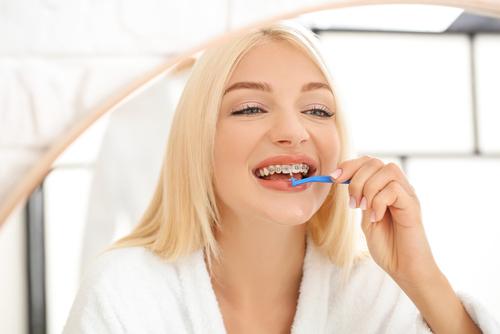
Summer is a time for relaxation, travel and fun activities, but it’s essential to remember that your orthodontic care doesn’t take a vacation just because you do. Whether you are enjoying a home-based staycation, operating at a relaxed pace or traveling abroad, maintaining your braces, aligners and other orthodontic appliances needs to remain a priority. Here are some practical tips and tricks to keep your smile healthy and bright, no matter where your summer adventures take you.
1. Brushing Techniques: The Foundation of Oral Hygiene
Proper brushing is crucial for everyone but especially important for those with orthodontic appliances. Here’s how to do it proactively:
- For Braces: Combine using a soft-bristled toothbrush with fluoride toothpaste. Tip the brush at a 45-degree angle to the gumline and gently brush above, below, and on each bracket. Pay extra attention to areas around wires and brackets where stray bits of food particles and plaque tend to accumulate.
- For Aligners: Remove your aligners before brushing. Brush your teeth thoroughly, including the fronts, backs and chewing surfaces. Clean your aligners with a separate toothbrush and clear, unscented antibacterial soap or special aligner cleaning solutions.
2. Flossing: Reaching the Tough Spots
Flossing can be a bit challenging with braces, but it’s vital for removing food particles and preventing gum disease.
- For Braces: Use floss threaders or orthodontic floss to navigate around wires. Another option is experimenting with interdental brushes or water flossers to clean between teeth and around brackets. The goal is to find what will make you want to floss so you will do it consistently.
- For Aligners: Flossing is straightforward. Simply remove your aligners and floss as you normally would, ensuring you reach between all teeth and along the gumline.
3. Choosing the Right Cleaning Products
Selecting appropriate cleaning products can make a significant difference in maintaining your orthodontic appliances:
- Toothpaste: Opt for fluoride toothpaste to help strengthen enamel and prevent decay. Avoid whitening toothpaste as it can cause uneven coloring around braces brackets.
- Toothbrush: Electric toothbrushes can be particularly effective for braces, as they provide more thorough cleaning and do most of the work for you. You will want to replace your toothbrush (or brush head) every three months as the bristles lose their shape and effectiveness.
- Mouthwash: Did you know that an antimicrobial or fluoride mouthwash helps lessen plaque while strengthening vital tooth enamel? Just be sure to use it after brushing and flossing for an added layer of protection.
4. On the Go Cleaning: Portable Solutions
Traveling or enjoying outdoor activities doesn’t mean neglecting your orthodontic care. Here are some portable cleaning solutions:
- Travel Toothbrush and Toothpaste: Keep a compact toothbrush and a small tube of toothpaste in your bag for quick cleaning after meals wherever you go.
- Orthodontic Wax: Carry orthodontic wax to address any discomfort from brackets or wires.
- Aligner Cleaning Crystals: For aligner wearers, consider carrying aligner cleaning crystals or portable cleaning tablets to soak them in while you are on the go.
5. Regular Check-Ups: Staying on Track
Even during summer, you don’t want to skip your orthodontic appointments. Regular check-ups ensure your appliances stay in great condition and your treatment is progressing as planned. If you are traveling, schedule your appointments around your trips to stay on track with your treatment.
6. Healthy Eating Habits: Protecting Your Appliances
Be mindful of what you eat. Remember to take your aligners out when eating and stay away from hard, sticky or chewy foods that can wreak havoc on your braces–like nuts, caramel, gum, popcorn and hard candies. Avoid crunchy foods like chips and pretzels, tough meats like steak or beef jerky, raw vegetables like carrots and celery, and crusty breads like bagels or pizza crust. Opt for soft, easy-to-chew foods that won’t harm your appliances or compromise your oral hygiene.
Enjoy Your Summer Safely
Maintaining your orthodontic appliances during summer is essential for a healthy smile. By following these cleaning tips and staying diligent with your oral hygiene practice, you can enjoy your summer activities while ensuring your orthodontic treatment remains on track. Our orthodontic team wishes you a safe and happy summer so you can keep on smiling with confidence!
Professional Orthodontic Bite Correction: More Than Just A Pretty Smile
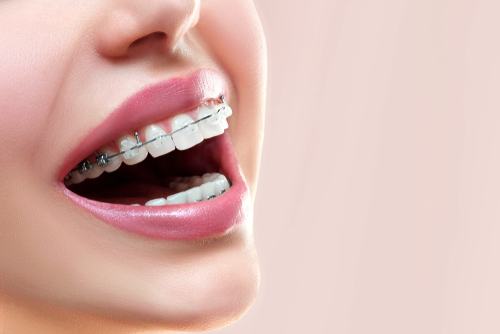
Orthodontic bite correction is often associated with achieving a straight, attractive smile. However, the benefits of correcting bite issues extend far beyond mere aesthetics. A properly aligned bite plays a crucial role in overall health, influencing everything from oral hygiene to digestive health and psychological well-being. In this blog, we will explore the multifaceted health advantages of orthodontic bite correction, illustrating why it is an essential investment in your long-term health.
Improved Oral Hygiene and Dental Health
One of the most immediate benefits of orthodontic bite correction is enhanced oral hygiene. Misaligned teeth create nooks and crannies where food particles and harmful plaque can accumulate, making it difficult to clean effectively with regular brushing and flossing. Over time, this invites cavities, gum disease and other serious dental problems. By aligning the teeth properly, orthodontic treatment makes it easier to maintain good oral hygiene, reducing the risk of these health issues and promoting better overall dental health.
Prevention of Jaw Pain and TMJ Disorders
A misaligned bite can place undue stress on the jaw muscles and joints, leading to temporomandibular joint (TMJ) disorders. TMJ disorders can cause chronic pain, headaches and difficulty chewing and speaking. Orthodontic treatment that properly corrects bite issues can alleviate these symptoms by ensuring that the jaw functions smoothly and efficiently. This not only reduces pain and discomfort but also prevents further complications that could arise from untreated TMJ disorders.
Augment Digestion
Digestion starts in the mouth, where chewing breaks food down into smaller, more easily manageable pieces. A misaligned bite can interfere with efficient chewing, allowing bigger food particles to slip into the digestive tract. This can eventually strain the digestive system and contribute to problems such as indigestion and nutrient absorption issues. By correcting the bite, orthodontic treatment ensures that food is chewed thoroughly, facilitating better digestion and overall gastrointestinal health.
Reduction in Headaches
Chronic headaches and migraines can often be traced back to dental and jaw issues, including misaligned bites. The relentless tension in the jaw muscles and joints can radiate pain to the head and neck, triggering headaches. Orthodontic bite correction addresses the root cause of this tension, significantly reducing the frequency and intensity of headaches. Patients who undergo bite correction often report a marked improvement in their overall quality of life, free from the constant burden of headaches.
Psychological Benefits: Boosted Self-Esteem and Confidence
The psychological impact of orthodontic bite correction should not be underestimated. When you have a well-aligned, attractive smile this can boost self-esteem and confidence, leading to improved social interactions and overall mental well-being. People who are self-conscious about their teeth may avoid smiling or engaging fully in social situations, which can affect their personal and professional lives. By correcting bite issues and enhancing the appearance of their smile, orthodontic treatment boosts individuals’ confidence and positivity regarding their appearance.
Long-Term Investment in Health
While orthodontic treatment requires an initial investment of time and money, the long-term health benefits far outweigh these costs. Preventing dental problems, reducing pain and improving overall well-being can lead to fewer medical and dental expenses in the future. Additionally, the boost in self-esteem and quality of life makes orthodontic bite correction a valuable investment in one’s overall health and happiness.
A Healthier, Happier, More Confident You
As you can see, orthodontic bite correction is much more than just a cosmetic enhancement; it is a comprehensive approach to improving overall health. From better oral hygiene and reduced jaw pain to enhanced digestion and psychological benefits, the advantages of a properly aligned bite are profound and far-reaching. Investing in orthodontic treatment is a step towards a healthier, happier and more confident you.
Dispelling the More Popular Myths About Orthodontic Treatment

Orthodontic treatment has seen remarkable progress in recent years, yet misconceptions persist, potentially deterring interested patients from seeking the orthodontic care they need for a healthier, more aligned smile. This blog post aims to debunk some popular, prevalent myths surrounding orthodontic treatment, shedding light on topics ranging from treatment duration to age considerations. By clarifying these misconceptions, we hope you can gain a better understanding of what orthodontic care entails and how to best proceed more confidently.
Myth 1: Orthodontic Treatment Drags On
A common misconception is that orthodontic treatment is a never-ending process. While timelines vary depending on individual cases and complexities, advancements in technology have significantly reduced treatment durations. Innovative options like accelerated orthodontics and clear aligner therapy offer efficient paths to desired outcomes, challenging the notion of prolonged treatment.
Myth 2: Orthodontic Treatment is Reserved for Teens
Though often associated with adolescence, orthodontic treatment is not age-restricted. Adults constitute a growing segment of orthodontic patients, benefiting from discreet options like clear aligners and lingual braces. The notion that orthodontic treatment is exclusive to teens overlooks the accessibility and effectiveness of these treatments for adults seeking to make the most of their smiles.
Myth 3: Orthodontic Treatment Equals Pain
There’s a prevalent misconception that orthodontic treatment is inherently painful. While some discomfort may arise initially as teeth adjust, the latest advancements in materials and techniques have made treatment more comfortable. Orthodontists prioritize patient comfort and employ strategies to minimize discomfort throughout the treatment journey.
Myth 4: Orthodontic Treatment is Purely Cosmetic
While aesthetics often motivate orthodontic treatment, its benefits extend beyond appearance. Treatment can correct bite alignment, mitigate dental issues like cavities and gum disease, and alleviate symptoms such as jaw pain and headaches. Recognizing the functional improvements alongside cosmetic enhancements reframes orthodontic treatment as a holistic approach to better oral health.
Myth 5: Orthodontic Treatment is Financially Prohibitive
Cost concerns may deter individuals from seeking orthodontic treatment, but options exist to make it more accessible. Many practices offer flexible payment plans and financing options. Moreover, considering the long-term benefits for oral health and overall well-being, the initial investment in orthodontic treatment is often outweighed by its lasting impact.
Challenging these pervasive myths about orthodontic treatment not only clarifies common misunderstandings but also opens the door for more people to consider this a beneficial medical service. Orthodontic care, far from being a daunting or exclusive endeavor, is an accessible and advantageous option for anyone seeking to improve their dental health and boost their overall quality of life.
Seeking Orthodontic Treatment With Confidence
With the evolution of orthodontic technology and the expansion of treatment options to suit diverse needs, patients of all ages can truly look forward to achieving their best smiles. Remember, the journey to a perfect smile begins with dispelling doubts and seeking expert advice. We encourage you to not let myths hold you back from exploring the potential of orthodontic treatment to enhance your smile and your health. If you are considering orthodontic treatment, our team invites you to take the next step and call to schedule your complimentary consultation!
The Latest High Quality Orthodontic Innovations for a Radiant Smile

As the world blooms into another spring season, it’s the perfect time to rejuvenate and refresh, not just our surroundings but ourselves as well. This month, we want to focus on something that radiates positivity and confidence—our smiles. With the rapid evolution of orthodontic technology, achieving that perfect smile is now more accessible and efficient than ever before. From virtually invisible aligners to 3D printing marvels and revolutionary braces systems, we are examining the latest innovative orthodontic advancements that promise to transform your smile.
Invisible Aligners: The Clear Choice
Gone are the days when achieving a straight smile meant enduring years of metal braces, complete with wires and brackets. Now, invisible aligners have taken the orthodontic world by storm, offering a discreet and comfortable way to correct dental misalignments. These clear, plastic trays are custom-made and specifically tailored to your mouth, ensuring the perfect fit. One of the standout features of invisible aligners is their removability—allowing for easy cleaning and the freedom to continue to eat whatever is on the menu. With advancements in material science, today’s aligners are not only virtually invisible but also more efficient in shifting teeth into their desired positions.
3D Printing: Customization at Its Finest
3D printing technology has revolutionized multiple industries, and orthodontics is no exception. This cutting-edge technology enables orthodontists to create precise and customized dental appliances like never before. From aligners and retainers to complex braces components, 3D printing ensures a tailored fit coupled with faster production times. This level of customization not only enhances comfort but also significantly reduces treatment duration, making it a game-changer in your orthodontic care.
Faster Braces Systems: Speeding Up the Process
If you require braces, the latest systems are designed to accelerate the treatment process while minimizing potential discomfort. Innovations such as heat-activated archwires and micro-osteoperforation techniques work by increasing the efficiency of tooth movement. MOPs leverage the natural biological processes of your body to expedite the movement of teeth at the cellular level. Accelerating the process of bone remodeling facilitates the swift and smooth repositioning of your teeth to their intended location, with results in a fraction of the time traditionally required.
Aesthetic and Comfort Enhancements
Beyond efficiency, there is a growing emphasis on the aesthetic and comfort aspects of modern orthodontic treatment. Ceramic braces provide a more discreet option compared to traditional metal braces, as they are designed to match the natural color of the teeth, making them less visible. Additionally, developments in dental materials and techniques have led to braces and aligners that are not only more comfortable to wear but also reduce the amount of irritation to the cheeks and gums.
Embracing the Future of Orthodontics
As we embrace these advancements, it is clear that the future of orthodontics is not just about achieving a functional bite or straight teeth; it’s about doing so in the most efficient, comfortable and aesthetically pleasing way possible. As nature blooms and the world awakens to new beginnings, why not take the first step toward transforming your smile? There has never been a better time to begin your journey towards a happier, more confident you, especially if you are receiving a tax refund this year. It is an opportune time to invest in orthodontic treatment for a healthier, more radiant smile you can enjoy in the years to come!
Uplifting Oral Health Observances From An Orthodontic Perspective
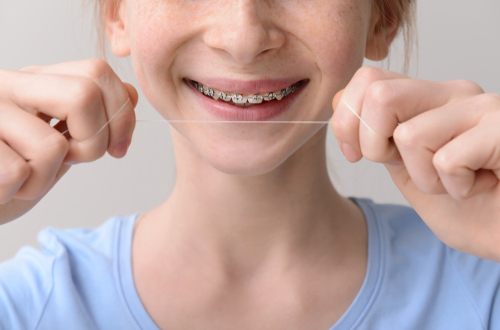
March ushers in the freshness of spring, symbolizing renewal and growth. It’s a time when we instinctively embark on spring cleaning, tidying up our homes and rejuvenating our surroundings. However, it’s not just our homes that deserve this revitalizing touch; our oral health routines can benefit from a spring refresh too. March is a pivotal month in the dental health calendar, as it hosts both World Oral Health Day and National Children’s Dental Health Month. What does this mean for your smile? This is a great time to spotlight the integral role of orthodontics in promoting overall oral health and ensuring the longevity of healthy, vibrant smiles throughout the year.
World Oral Health Day: An Orthodontic Perspective
Celebrated globally on March 20th, World Oral Health Day is a call to action for better oral hygiene, preventive dental care and wider access to life-changing dental treatments. Orthodontics, a dental specialty focused on correcting irregularities of the teeth and jaw, is central to these goals. As we can attest, orthodontic treatments don’t just boost the aesthetics of your smile but also correct malocclusions (bad bites) that, if left untreated, can lead to a host of oral health issues, including tooth decay, gum disease and difficulty chewing and speaking.
Our orthodontic team plays a pivotal role in preventive care. By aligning teeth and creating a more functional bite, orthodontic treatment makes daily oral hygiene practices, such as brushing and flossing, so much more effective. This alignment reduces the risk of food particles getting trapped in hard-to-reach areas, thereby decreasing the potential for damaging plaque buildup and gum disease.
National Children’s Dental Health Month: Emphasizing Early Orthodontic Intervention
March also shines a spotlight on the dental health of the younger demographic through National Children’s Dental Health Month. This observance underscores the importance of early dental care and the benefits of introducing children to orthodontic evaluations by the age of 7, as recommended by the American Association of Orthodontists. Early assessment allows for the timely identification of potential dental issues, such as crowding, overbites or underbites, which can be more easily corrected while your child’s jaw bones are still developing.
Early orthodontic intervention can pave the way for healthier smiles by guiding the proper growth of jaw bones, ensuring optimal spacing for emerging permanent teeth, and correcting habits that may be detrimental to dental health, like thumb sucking or tongue thrusting. These proactive steps contribute significantly to the development of a well-aligned, functional and aesthetically pleasing smile.
The Broader Impact of Orthodontic Treatments on Oral Health
Orthodontic treatment benefits go far beyond the cosmetic enhancement of your smile. By facilitating better alignment, orthodontics plays a crucial role in improving your overall oral health. Properly aligned teeth are easier to clean, reducing the risk of periodontal disease and cavities. Correcting bite issues can even alleviate stress on your jaw joints and muscles, potentially preventing chronic conditions including temporomandibular joint disorder (TMJD) and the associated symptoms of pain and discomfort.
Spring Cleaning, Renewal and Orthodontic Health
As March heralds an uplifting time for spring cleaning and renewal, let it also serve as a reminder of the importance of promoting orthodontic health in the broader spectrum of oral health care. Through early intervention, preventive care and the corrective power of orthodontic treatments, you may enjoy healthier smiles that last a lifetime. We invite you to embrace this month as an opportunity to renew your commitment to oral health by aligning your bite and straightening your teeth as needed, ensuring that your smile remains as beautiful and vibrant as springtime itself!
Are You Ready To Set Some Orthodontic Goals for the New Year?

As we usher in the new year, it’s the perfect time to reflect on our personal goals and aspirations. While many resolutions focus on fitness, career or personal development, it’s essential not to overlook the importance of setting orthodontic-related resolutions for the more perfect smile you have always wanted. Whether you’re already on an orthodontic journey or contemplating starting one, this year can be a transformative one for your dental health. Let’s explore the significance of orthodontic resolutions, the importance of compliance with treatment plans, and tips for maintaining good oral hygiene during orthodontic treatment.
1-Commit to Your Treatment Plan
One of the key resolutions for an aligned smile is committing to compliance with your orthodontic treatment plan. Consistency and adherence to your orthodontist’s recommendations play a crucial role in achieving optimal results. Whether you’re wearing braces, clear aligners or another type of orthodontic appliance, following the prescribed guidelines ensures that your teeth move into their desired positions effectively. Set a resolution to wear your aligners for the recommended hours each day, keep up with rubber band usage when wearing braces, and attend all scheduled appointments. By doing so, you’re not only investing in a straighter smile but also minimizing the overall duration of your orthodontic journey.
2-Attend All Scheduled Check-Ups
Regular check-ups are another integral aspect of orthodontic care. Committing to consistent appointments allows your orthodontist to monitor progress, make necessary adjustments, and address any concerns promptly. This year, prioritize attending all scheduled visits, even if everything seems to be going smoothly. These appointments are crucial for ensuring the ultimate success of your treatment goals and making any necessary adjustments to keep you on the path to achieving that perfect smile.
3-Practice Consistent Oral Hygiene
Maintaining good oral hygiene is equally important, especially during orthodontic treatment. Resolving to keep your teeth and braces or aligners clean will contribute to a healthy, beautiful smile. Brushing and flossing may require a bit more effort and time with braces, but the payoff is well worth it. Make it a resolution to brush after every meal, floss diligently, and use any additional tools recommended by your orthodontist for optimal oral hygiene.
4-Nourish Your Body and Your Smile
In addition to these healthy orthodontic resolutions, adopting a tooth-friendly diet can significantly impact your orthodontic journey. Limit sugary and sticky foods that can damage braces or lead to cavities while undergoing aligner therapy. Instead, focus on a balanced diet of fruits, vegetables and calcium-rich foods to promote overall oral health.
5-Maintain a Positive Mind-Set
Embracing a positive mindset throughout your orthodontic journey is another resolution worth considering. Acknowledge the progress you make, no matter how small, and celebrate the milestones along the way. A positive attitude can make the experience more enjoyable and help you stay motivated to achieve that perfect smile you have always wanted.
6-Enjoy the Process and Transformation
As you embark on your orthodontic resolutions for 2024, remember that the investment you make in your smile today will pay off for a lifetime. By committing to compliance, regular check-ups, good oral hygiene practices, and a positive mindset, you’re well on your way to achieving a perfect smile, improved overall dental health and ultimately, better overall health.
Why not make this year the one where you prioritize your orthodontic goals and enjoy the transformation of your smile? Cheers to a healthier, happier you in 2024!
The Gift of Orthodontics and Braces-Friendly Holiday Treats

The holiday season is upon us, bringing joy, laughter and the chance to express our love and appreciation for everyone we care about. If you’re looking for a unique and lasting gift that can truly make a difference, consider giving the gift of orthodontics. Whether it’s for yourself or someone you love, investing in a healthy, beautiful smile is a present that will keep giving for a lifetime.
The Gift of a Beautiful Smile
Orthodontic treatment isn’t just about straightening teeth; it’s about creating a confident, healthy smile that lasts a lifetime. Giving the gift of orthodontics is not only an investment in aesthetics but also in oral health and overall well-being. Did you know that straight teeth are easiest to clean, lowering the risk of cavities and gum disease? Not only that, but aligned teeth also contribute to better chewing and speech, enhancing overall comfort and confidence.
If you or a loved one has been considering orthodontic treatment, the holidays are the perfect time to take the first step. Many orthodontic offices offer flexible scheduling, making it easier to start the journey toward a straighter smile without disrupting your busy holiday plans.
Braces-Friendly Holiday Treats
Celebrating the holidays with braces doesn’t mean sacrificing the joy of indulging in traditional festive treats. It just requires a bit of creativity and awareness of what foods are safe when wearing braces. Here are some delicious and braces-friendly holiday treats to ensure a safe and joyful celebration!
- Soft Gingerbread Cookies: Swap out crunchy gingerbread cookies for a softer version. Soft gingerbread cookies are not only delicious but also gentle on braces. They allow you to enjoy the festive flavors without the risk of damaging brackets or wires.
- Mashed Potatoes and Gravy: A holiday dinner classic, mashed potatoes and gravy are not only braces-friendly but also a comfort food favorite. They’re soft, easy to chew and won’t pose a threat to braces. Just be mindful of any added hard or crunchy toppings.
- Creamy Hot Chocolate: Warm up with a cup of creamy hot chocolate. This festive beverage is not only braces-friendly but also a delightful way to stay cozy during the winter season. Avoid hot drinks with hard toppings or crunchy bits to keep it safe for your braces.
- Fruit Salad: Create a colorful and refreshing fruit salad for a healthy and braces-friendly dessert option. Soft fruits like berries, kiwi and melons are not only delicious but also won’t harm your braces.
- Pudding Parfaits: Layer soft pudding with your favorite braces-friendly toppings like whipped cream, soft fruits or crumbled cookies. Pudding parfaits are a decadent treat that’s safe for braces and customizable to suit your taste.
Giving the Gift of Oral Health and Happiness
This holiday season, consider giving yourself or a loved one the gift of orthodontics—a present that will contribute to a lifetime of better oral health, confidence and beautiful smiles. With the right orthodontic care and a mindful approach to holiday treats, you can celebrate the season in style without compromising the progress of your braces. From our orthodontic family to yours, we wish you and your loved ones a joyful and braces-safe holiday season!
We Are Grateful To Help You Create Healthier Smiles Using Our Orthodontic Services
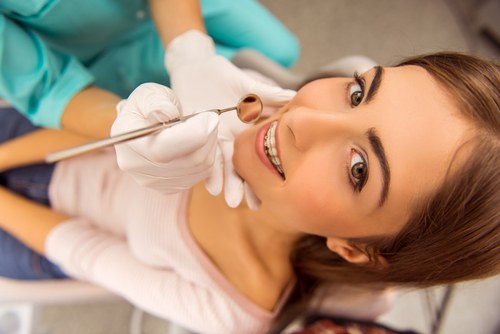
November is a time of remembering the people we are thankful for and those who give us joy. At our orthodontic practice, we understand the importance of gratitude, and today, we want to express our deep appreciation for you, our patient! Without your trust and support, our mission of helping you live a healthier, happier life through orthodontic care wouldn’t be possible. We love helping you align your smile and improve your quality of life.
The Power of a Smile
A smile is a universal symbol of happiness and well-being. It not only radiates positive energy but also has the potential to transform your life. A beautiful smile can boost your self-confidence, improve your social interactions and even positively impact your physical and mental health. This is why we are so passionate about our orthodontic services.
Orthodontic Treatment: Beyond Aesthetic Benefits
Orthodontic treatment is often associated with improving the aesthetics of your smile, and while that is certainly a significant aspect, the benefits extend far beyond a cosmetic enhancement. By aligning your teeth and correcting issues such as overcrowding, misalignment or bite problems, we strive to provide you with a healthier and happier life overall. So what does this mean for you?
- Improved Oral Health: Misaligned teeth can lead to a range of oral health issues, including gum disease, tooth decay and jaw pain. Orthodontic treatment helps create a healthier environment in your mouth, making it easier to maintain good oral hygiene habits.
- Enhanced Speech: Proper alignment of teeth and jaws can improve speech and pronunciation, helping you communicate more effectively and confidently with those around you.
- Increased Self-Esteem: When you feel good about your smile, your self-esteem soars. This confidence boost can extend to various aspects of your life, from career opportunities to personal relationships.
- Better Digestion: Correcting bite problems can lead to better chewing and digestion, contributing to better overall health and well-being.
- Long-Term Comfort: Properly aligned teeth can reduce the risk of jaw pain, headaches and discomfort associated with misalignment issues.
Our Heartfelt Gratitude
We are thankful for every patient who places their trust in us, and we cherish the opportunity to be a part of your journey towards a healthier and happier life. Your smiles, stories and transformations inspire us every day. Your patience, commitment and courage to embark on the path of orthodontic treatment motivate us to deliver the best care possible.
Our Orthodontic Team’s Dedication
Our team is dedicated to providing top-notch orthodontic care. We stay current with the latest advancements in the field, ensuring that you receive the most effective and comfortable treatment possible. Our entire team believes in fostering a supportive and compassionate environment where you can freely express your concerns and questions so we can do what we do best.
With our state-of-the-art technology and dedicated team of experienced professionals, we aim to make your orthodontic journey as smooth as possible. Our goal is not only to straighten your teeth and align your bite but also to create a positive and lasting impact on your overall health, confidence and well-being.
Conclusion
As we express our heartfelt gratitude for our orthodontic patients, we want you to know that your trust in us is a driving force in our commitment to providing the best orthodontic care possible. Your satisfied smile inspires us, and your well-being is our utmost priority. Thank you for being a part of our orthodontic family, we look forward to helping you create your best smile!
Now Is the Time To Celebrate National Orthodontic Health Month!
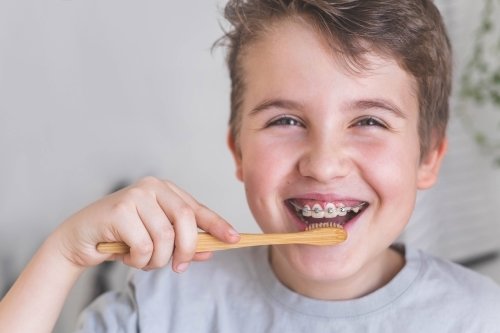
October is finally here, and we are thrilled, because it’s not just spooky season and pumpkin spice lattes; it’s also National Orthodontic National Orthodontic Health Month is observed annually during October and is dedicated to promoting good orthodontic health, understanding orthodontic issues and their treatment. Our goal today is to help you see how orthodontic care can contribute to your most confident and healthy smile.
Why Is Orthodontic Health Important?
Did you know that your orthodontic health isn’t just about having straight teeth? Your orthodontic health plays a vital role in your overall oral health. Our orthodontic team has helped patients struggling with misaligned teeth and jaw problems find themselves experiencing better oral health after treatment.
- Improved Self-Confidence: Through proper orthodontic care, you can achieve a beautiful, straight smile to boost confidence and improve social interactions in your busy life, making you proud to flash your aligned smile.
- Better Oral Health: Properly aligned teeth are easier to clean and maintain. This reduces the risk of cavities, gum disease and other common dental conditions.
- Optimized Bite Function: Correcting bite issues ensures that your teeth meet properly when you chew, minimizing wear and tear on your teeth and reducing the risk of jaw pain and headaches.
- Enhanced Speech: Orthodontic treatment can also improve your speech if your misaligned teeth currently interfere with normal pronunciation.
What Are Some Common Orthodontic Issues?
Understanding common orthodontic problems is key to appreciating the importance of orthodontic health:
- Malocclusions: These refer to improper bite alignments (overbites, underbites, and crossbites). These misalignments can affect how your upper and lower teeth come together, potentially leading to oral health issues and discomfort.
- Crowding: When there isn’t enough space in your jaw for teeth to grow properly, crowding occurs and needs to be fixed as the tight spacing makes it challenging to clean between them. This can leave you vulnerable to damaging plaque buildup, tooth decay and gum disease.
- Spacing: Gaps or spaces between teeth can be unsightly and affect overall oral health, causing gum recession from lack of stimulation in those areas and the risk of injury and trauma as teeth shift or rotate.
- Misalignment: Crooked teeth, no matter how slight, can lead to problems cleaning your teeth and abnormal wear and tear on specific teeth, leading to premature erosion, fractures and sensitivity.
How Can Orthodontic Treatment Help You?
Orthodontic treatment, including braces and aligners, can address your issues effectively. Here are some of the benefits of seeking orthodontic care:
- Aesthetic Improvement: Orthodontic treatment can dramatically enhance the appearance of your smile as you feel like smiling freely and more often.
- Oral Health: Since straight teeth are easier to clean, you will reduce your risk of cavities and gum disease.
- Functional Improvement: Correcting bite issues can improve eating and speaking abilities.
How Can You Maintain Good Orthodontic Health?
As our orthodontic team observes National Orthodontic Health Month, we invite you to consider these tips for maintaining your best orthodontic health:
- Regular Check-ups: Schedule routine visits to our orthodontist to monitor your progress and ensure your treatment is on track.
- Oral Hygiene: Keep up with your diligent daily oral hygiene practices. This means brushing, flossing and using mouthwash to help keep your teeth and gums healthy and strong.
- Dietary Considerations: Be mindful of what you eat to avoid damaging braces or aligners. This is the time to stick to softer foods and avoid sticky or hard candies that can damage teeth and braces.
- Follow Instructions: Follow our orthodontist’s instructions carefully so you can receive the best possible outcome from your treatment; after all, you are investing both time and money to create your best smile.
Questions? Give Us a Call!
As October rolls around, we invite you to take a moment to appreciate the importance of your orthodontic health. Whether you’re considering orthodontic treatment or are already on your journey to a healthier smile, National Orthodontic Health Month is the perfect time to remember why we celebrate the positive impact of orthodontics on your life and oral well-being!
Orthodontic Myths Unmasked: How to Separate Fact from Fiction for a Straighter Smile

Let’s set the record straight about orthodontics, shall we? There are more than enough misconceptions surrounding braces, clear aligners, and orthodontic treatment in general. Join us today as we bust some common myths and address concerns that might be holding you back from pursuing the beautifully straightened smile you deserve. Discover the truth about comfort, duration, aesthetics and more, and gain a clear understanding of the positive impact orthodontic treatment can have on your quality of life.
Myth: Orthodontic treatment is painful.
Fact: One prevalent misconception regarding orthodontic treatment is the belief that it is excessively painful. In reality, while you might find yourself with some discomfort when your braces or aligners are initially adjusted, this discomfort is both manageable and short-lived. In fact, most patients report that any pain they experience is more like mild soreness rather than intense pain. Plus, advances in orthodontic technology have made modern braces and aligners much more comfortable than their predecessors.
Myth: Orthodontic treatment takes an eternity.
Fact: Another myth that often discourages people from seeking orthodontic treatment is the belief that it takes years to achieve results! But the truth is, while the length of treatment varies depending on your unique needs, leading edge advancements in orthodontic technology have actually lowered treatment times. Many people can achieve their desired results in as little as six months to two years. Additionally, some cases may even qualify for accelerated treatment options.
Myth: Orthodontic treatment is mainly for children and teenagers.
Fact: Orthodontic treatment really isn’t only for kids and teenagers! While many people undergo teeth straightening during their youth, adults often benefit from orthodontic treatment as well. In fact, an increasing number of grownups are having orthodontic treatment to improve their smiles and oral health. With options like clear aligners, which are discreet and comfortable, orthodontic treatment is now accessible to people of all ages.
Myth: Braces and aligners are unattractive.
Fact: The belief that braces and aligners are unappealing is a myth that needs debunking. Thanks to modern technology, orthodontic appliances have come a long way in terms of aesthetics. Traditional metal braces are now smaller and less noticeable than in the past. Moreover, options like ceramic braces and clear aligners are nearly invisible, allowing you to straighten your teeth without drawing attention to your mouth.
Myth: Orthodontic treatment is only about looks.
Fact: While orthodontic treatment offers a more aesthetically appealing smile, it also offers numerous other benefits too. Did you know that straight teeth are easier to clean and maintain, lowering your risk of dental issues like cavities and gum disease? Correctly aligned teeth also contribute to better overall oral health and while alleviating issues like jaw pain and headaches that show up in misaligned bites.
Myth: Orthodontic treatment is costly.
Fact: Cost is often a concern for those considering orthodontic treatment, but it’s essential to remember that the price can vary depending on the complexity of your case and the type of treatment you opt for. Many orthodontic offices offer flexible payment plans and financing options to make treatment more affordable. Not only that, but investing in orthodontic treatment often prevents costly dental problems down the road.
Myth: Orthodontic treatment is reserved for severe cases of misalignment.
Fact: Orthodontic treatment is not just for severe cases of misalignment! Even if you have minor alignment issues, orthodontics can help improve the function and appearance of your smile. In fact, addressing minor issues early on can prevent them from becoming more severe over time.
Conclusion
As you can see, orthodontic treatment is a valuable option when you are looking to improve your oral health while achieving a beautiful smile. By understanding how these common myths and misconceptions might hold you back from exploring the benefits of orthodontic treatment, you can find out for yourself how it can actually benefit you. Our orthodontic team invites you to schedule a complimentary consultation to discuss your specific needs and goals. Learn how accessible, comfortable, and effective modern orthodontic treatments can be. The journey to a straighter, healthier smile is smoother than you might think!
Embracing Braces: Tips for Back-to-School Confidence During Orthodontic Treatment

As summer winds down, the excitement of a new school year can be thrilling for many students. However, for some, the anticipation of returning to school is accompanied by feelings of anxiety and self-consciousness because of one significant change in their lives: wearing braces. While undergoing orthodontic treatment is a step towards achieving a beautiful and healthy smile, for teens, it is natural to feel emotionally challenged during this transformative period.
The Emotional Aspect of Getting Braces Before Returning to School
Getting braces for your teen can be a mixed bag of emotions. On one hand, there’s the excitement of knowing that in the long run, they will have an improved smile and better oral health. But there can also be apprehension and self doubt about how they will be perceived by their peers. The fear of standing out or being teased can make the thought of going back to school with braces seem especially daunting. It is entirely normal to feel this way, and it’s okay to be nervous or uncertain about adapting to a new appearance. Understanding that many classmates may have been through or are currently experiencing the same feelings can help your teen feel like they are not alone on this journey.
Building Confidence and Self-Assurance While Wearing Braces
Confidence is a powerful tool that can help your teen navigate the challenges of wearing braces. Here are some tips to embrace braces with confidence:
- Focus on the End Goal: Remind them why they are getting braces in the first place. Keeping their eye on the prize – a more beautiful, straighter smile – can help them stay positive throughout the treatment process.
- Accessorize: Make their braces more fun by adding some personal flair. Choosing colorful bands can help them appreciate their braces as they reflect their unique style.
- Practice Good Oral Hygiene: Taking good care of braces and teeth will not only improve the effectiveness of orthodontic treatment but will also boost your teen’s self-confidence around others.
- Talk to Others: Sharing their feelings with friends, family and our orthodontic team can help! Talking about their concerns is often cathartic and others may offer helpful advice and support.
Addressing Concerns about Appearance and Potential Teasing
One of the most significant concerns for students with braces is the fear of being teased or bullied by their peers. However, it’s crucial to understand that we have come a long way in embracing differences and uniqueness. Here are some ways your teen can handle concerns about potential teasing:
- Educate Their Peers: Sharing with their friends and classmates what getting braces entails and the potential benefits can help. Most kids are understanding and supportive once they realize the importance of the treatment.
- Confidence is Key: Confidence plays a crucial role in how others perceive your teen. When they are comfortable with their braces, it sends a message to their peers that they are unbothered by their opinions.
- Stay Positive: If your teen encounters teasing or negative comments, they can stay upbeat by surrounding themselves with positive influences and remembering that true friends will accept them for who they are, braces and all.
We hope these coping strategies help your teen remain confident and excited about returning to school while wearing new braces! Focusing on how they will end up with the smile they want can help them wear their braces with a smile and face the new school year with pride and self-assurance!
Summer Smiles: How Orthodontic Treatments Can Enhance Your Summer Experience

Summer is a season of sunshine, laughter, and creating and documenting lasting memories with family and friends. It’s a time when everyone wants to look and feel their best, and that includes sporting a confident smile. If you’re considering orthodontic treatment, whether it’s braces, aligners, or retainers, summer can be the perfect time to embark on your smile transformation journey. Let’s explore how orthodontic treatments can improve your summer experience to give you even more reasons to smile!
Comfort and Convenience
Today’s orthodontic treatments have come a long way, with modern options like clear aligners that offer a comfortable and convenient solution for you to consider. Unlike the traditional braces of the past, clear aligners are virtually invisible, allowing you to enjoy your summer activities without feeling self-conscious, even when taking lots of photos to share on your social media platforms. Not only that, but clear aligners can be easily removed when you eat, drink, and brush your teeth, giving you the freedom to indulge in your favorite seasonal treats without any restrictions. In-season corn on the cob, anyone?
Confidence Boost
A straight and beautiful smile can significantly boost your confidence wherever you go. Whether attending summer parties, traveling on vacations, or just spending time at the beach or lake, orthodontic treatments can give you the confidence to smile freely and radiate positivity. You can feel more at ease engaging with others, making new friends and creating memorable experiences throughout this refreshing season.
Shorter Treatment Time
Orthodontic treatments are also becoming faster and more efficient. With advancements in orthodontic technology, some treatment options offer accelerated results, lowering overall treatment time. Summer provides an opportunity to make progress on your orthodontic journey, allowing you to achieve a straighter smile before the next school year, work, or upcoming life events.
Better Oral Health
Did you know that orthodontic treatments don’t just enhance how your smile looks but can actually improve your overall oral health? That’s because straight teeth are easier to keep clean and maintain, effectively lowering your risk of tooth decay, cavities, gum disease, and other dental hazards. By starting your orthodontic treatment during the summertime, you can establish good oral hygiene habits and ensure a healthier smile in the years to come.
Customized Treatment
Each person’s orthodontic needs are unique. Whether you currently experience crowded teeth, gaps, or misalignments, our orthodontic treatments can be tailored to address your specific concerns. During the summer, our orthodontic team has more availability and flexibility to develop a personalized treatment plan that suits your lifestyle and goals. Summer is the perfect time to work closely with our orthodontist to achieve the smile you’ve always wanted!
Seamless Transition
Starting orthodontic treatment during the summer allows a seamless transition into your new routine. It gives you plenty of time to adjust to wearing aligners or braces and become familiar with their required care and maintenance. By the time fall arrives, you’ll already be comfortable with your treatment, making it easier to manage during school, work, and attending all the seasonal festive events.
No Better Time
Embrace the summer season with a confident smile by considering orthodontic treatment. With the plentiful options available today, you can find a treatment that aligns with your lifestyle and goals. We invite you to consult with our orthodontic team to discover the best approach for bettering your smile this season. Now is a great time to invest in yourself so your smile can shine brighter than ever before. Call today!
Unlocking Your Best Smile: Why It’s Never Too Late for Adult Orthodontic Treatment
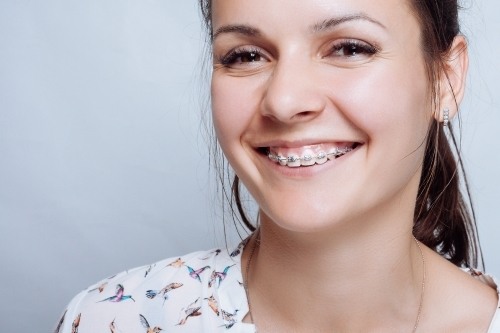
When it comes to orthodontic treatment, the misconception that it’s only for children and teenagers is far from the truth. In actuality, more adults are investing in orthodontic treatment to enhance their smiles along with their overall oral health. Whether it’s for aesthetic reasons or to address bite issues, adults are realizing that it’s never too late to achieve the smile they’ve always desired. If you are an adult seeking orthodontic treatment, we will explore why orthodontic treatment for you is a worthwhile investment and the many benefits you can reap!
Aesthetics and Confidence Boost
A captivating smile can make a world of difference in both personal and professional settings. Orthodontic treatment effectively improves crooked or misaligned teeth, closes gaps, and straightens your smile. By improving the aesthetics of your teeth, you can experience a boost in confidence and self-esteem, allowing you to fully embrace your uniqueness and radiate positivity in all aspects of your life.
Enhanced Oral Health
Beyond the cosmetic benefits, orthodontic treatment for adults can greatly improve your oral health. Misaligned teeth can be challenging to clean properly, leading to a higher risk of tooth decay, gum disease, and other oral issues. Orthodontic treatment aligns the teeth properly, making it easier to maintain optimal oral hygiene care. Straight teeth are more accessible to clean thoroughly, reducing the likelihood you will incur dental problems and ensuring long-term oral health.
Correcting Bite Problems
Orthodontic treatment is not solely about achieving straight teeth; it can also correct bite problems. Issues such as overbites, underbites, or crossbites can cause discomfort, affect proper chewing, and even impact speech. By addressing these bite issues through orthodontic treatment, you can improve your dental function and alleviate associated discomfort, leading to enhanced overall well-being.
Technological Advancements
Advancements in orthodontic technology have revolutionized treatment options for adults. Traditional metal braces are still effective, but there are now discreet alternatives available to you. Clear aligners offer a virtually invisible solution, allowing you to straighten your teeth without drawing attention to the orthodontic appliance. Digital technology has also improved treatment planning and efficiency, resulting in shorter treatment times and more accurate results.
Improved Comfort
As an adult, you don’t need to endure uncomfortable orthodontic appliances. Modern technology ensures that your braces’ hardware is smaller and sleeker. Smooth brackets and wires reduce irritation and lessen discomfort during your orthodontic treatment. Clear aligners, on the other hand, are custom-made to fit your teeth snugly, providing a comfortable orthodontic experience. With these advancements, you can undergo orthodontic treatment with minimal disruption to your daily life.
Long-Term Cost Savings
Investing in orthodontic treatment as an adult may seem daunting, but it’s essential to consider the long-term cost savings it offers. Correcting misaligned teeth and bite problems can prevent more significant dental issues in the future, saving you from potentially costly and invasive procedures. By addressing orthodontic concerns, you can maintain a healthy smile and avoid the need for extensive dental work down the road.
Age Is Just a Number
It’s never too late to prioritize your oral health and achieve the smile you desire. Orthodontic treatment knows no age limits. Many adults are choosing to embark on their orthodontic journey and are reaping the benefits. Whether you’re in your 30s, 40s, 50s, or beyond, it’s never too late to take the first step towards a healthier, more confident smile!
You Can Achieve a Healthy, Beautiful Smile Through Orthodontic Bite Correction

Did you know that a straight and healthy smile not only looks good, but it also promotes better oral health? One of the most beneficial aspects of achieving a healthy smile is correcting your bite. A misaligned bite can lead to dental problems, including tooth decay, gum disease, and even jaw pain. But what is a bite, and how can it be corrected?
Understanding Your Bite
A bite refers to the way your teeth come together when you close your mouth. Your bite pattern is determined by the alignment of your teeth and the relationship between your upper and lower jaws. A healthy functioning bite allows you to chew and speak properly, while an improper bite can lead to problems with your jaw, teeth and gums.
Types of Bite Misalignment
There are several types of bite misalignment, including:
- Overbite: When your upper front teeth overlap your lower front teeth.
- Underbite: When your lower front teeth overlap your upper front teeth.
- Crossbite: When your upper teeth sit inside your lower teeth when you bite down.
- Open bite: When there is a gap between your upper and lower front teeth when you bite down.
Bite Correction Options
Orthodontic treatment is often the best way to correct a misaligned bite. There are several orthodontic treatment options available to you, including:
- Braces: Traditional braces and their ceramic counterparts use brackets and wires to gradually move your teeth into their correct positions. This is the most common orthodontic treatment option and can be used to correct a variety of bite problems.
- Clear Aligners: A clear aligner system uses a series of custom-made aligners to gradually move your teeth into their correct positions. This discreet option is often preferred by adults and older teens who do not want the noticeable appearance of traditional braces.
- Orthognathic surgery: In severe cases of bite misalignment, orthognathic surgery may be a necessary option. This surgery involves repositioning the upper or lower jaw to correct your bite.
Benefits of Bite Correction
Correcting your bite has several desirable benefits, including:
- Improved oral health: A healthy bite reduces your risk of tooth decay and gum disease.
- Reduced risk of jaw pain: An unhealthy bite can lead to jaw pain, headaches and even temporomandibular joint (TMJ) disorder. Bite correction can help alleviate these symptoms.
- Enhanced appearance: A straight and healthy smile can boost your self-confidence and improve your overall appearance.
Choosing the Right Orthodontic Treatment
When it comes to fixing your smile issues, choosing the right orthodontic treatment is crucial. It largely depends on your individual needs and goals, so your care will be tailored specifically to your needs. Our orthodontist will evaluate your bite and recommend the best treatment option for your smile. Factors such as the severity of your bite misalignment, your age and your lifestyle will all be taken into consideration for the best possible outcome.
Consultation Call
As you can see, correcting your bite is the foundation for successfully achieving a healthy and beautiful smile. Orthodontic treatment, whether it is some form of braces or clear aligners, can help correct a variety of bite misalignments. Also, if you are experiencing symptoms such as chronic jaw pain or headaches, it is essential to seek orthodontic treatment to prevent further complications from taking place. We welcome you to consult with our orthodontist to determine the best course of action for your smile!
Spring Is a Good Time To Spruce Up Your Teeth Cleaning in Braces With Water Flossing
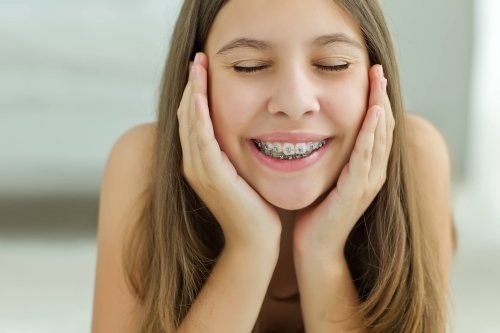
As the sun begins to shine brighter and the flowers start to bloom, we all know what time it is: spring cleaning! While you’re busy decluttering your home and tidying up your living space, don’t forget about another important task this time of year; taking care of your teeth.
If you wear braces, you know how important it is to keep your teeth and gums clean. You have likely already noticed that braces can easily trap food particles and make it harder to floss thoroughly, putting you at greater risk of tooth decay and gum disease. Luckily, there’s an easy solution: water flossing!
Flossing is just as important as brushing those pearly whites. This task can be made easier by using a water flosser, also known as an oral irrigator. This innovative device uses a pulsing stream of water to clean between your teeth and along your gumline. Water flossing is especially useful for people with braces, as it can help flush out any leftover debris or food particles that may be stuck in the wires and brackets.
Here are some tips for using a water flosser while wearing braces:
- Use lukewarm water: Cold water can be uncomfortable on sensitive teeth, while hot water can damage the device. Lukewarm water is the perfect temperature for using a water flosser.
- Start at a low setting: If you’ve never used a water flosser before, start at a low setting and gradually increase the pressure as you get used to the sensation.
- Aim for the gumline: Place the tip of the water flosser at a 90-degree angle to your gumline and work your way along each tooth, paying careful attention to those sections around your braces hardware; the brackets and wires.
- Take your time: Don’t rush the flossing process. Make sure to thoroughly clean each tooth and bracket.
- Use mouthwash: After you’ve finished using the water flosser, rinse your mouth using an antimicrobial mouthwash to kill any remaining oral bacteria while refreshing your breath.
In addition to using a water flosser, it’s also important to maintain a regular oral hygiene routine while you are wearing braces. Here are some tips to help you keep your teeth and gums healthy while you are having orthodontic treatment done.
- Brush your teeth and braces at least twice a day: You can use a soft-bristled brush and fluoride toothpaste to gently and effectively clean your teeth and braces.
- Floss at least once a day: Use floss threaders or orthodontic floss to thoroughly clean between your teeth and along your gumline.
- Avoid hard, sticky, and sugary foods: These types of foods can damage your braces and increase your risk of tooth decay.
- Visit our orthodontist regularly: Our skilled orthodontist will be able to monitor your progress and make any necessary adjustments to your braces.
If you are using clear aligners instead of braces to straighten your teeth and bite, cleaning is easy and still essential. Just take out your aligner tray to brush and floss normally. Be sure to clean your aligners daily as well. And that’s it!
While you’re busy spring cleaning your home, don’t forget to take good care of your teeth, too. With a little extra effort and the help of a water flosser, you can keep your smile healthy and bright while undergoing orthodontic treatment!
Eating Healthy Foods While Straightening Your Teeth

March is the 50th anniversary of National Nutrition Month. With spring almost here, this is a great time to renew your focus on eating the foods your body and mouth need while protecting your braces hardware or clear aligners.
Tooth-Friendly Healthy Foods
This is a good time to make sure you are getting the nutrients you need for healthy teeth and gums. You want foods that provide essential vitamins and minerals, including calcium, phosphorus, and vitamins C and A, that protect vital tooth enamel.
Even though it’s the hardest substance in your body, tooth enamel can still be damaged by harmful acids and bacteria in the mouth. While you can’t eat crunchy fruits, nuts, or leafy greens with braces (the latter is hard to remove from braces), you can take a vitamin supplement as recommended by your doctor and consume these tooth-friendly foods recommended by the American Dental Association:
- Cheese
- Eggs
- Milk
- Plain yogurt
- Tofu
Please limit or avoid processed sugar like candies, chocolates, sodas, juices and sports drinks. Since high-carbohydrate foods break down into simple sugars, they are just as harmful to your teeth and gums. Instead, focus on sticking to the following choices:
Best Fruits and Vegetables While Wearing Braces
- Bananas
- Blueberries
- Ripe peaches
- Ripe pears
- Applesauce (avoid whole or apple pieces)
Cooking your vegetables is the easiest way to get the nutrients provided by this food group. Anything you can bake, boil or steam helps lock in their nutrients while making them soft and easy to eat, such as:
- Broccoli
- Carrots
- Potatoes
- Squash
- Sweet Potatoes
- Zucchini
Eating the wrong foods can loosen or break braces, wires, or bands. This means staying away from sticky or crunchy foods. Be sure to maintain proper dental care while wearing braces by brushing at least three times a day and, ideally, after each meal. Use a soft-bristled toothbrush to clean around the braces to clear out all stray bits of food. Follow up by flossing well between your teeth so food particles can’t linger in the braces and wires.
Tip: Chew your food with the stronger molars in the back instead of your front teeth while protecting braces hardware.
Healthy Foods and Tips While Undergoing Clear Aligner Therapy
Dairy products are loaded with calcium and protein, both of which support tooth health. Dairy increases your mouth’s pH level, which fights off oral bacteria that cause cavities. Fruits (melons, berries, plums) and veggies (cucumber, tomatoes, zucchini ) that are high in water to keep your mouth well hydrated.
- After wearing your clear aligners for 20 to 22 hours, you should clean your aligner tray when you take them out to eat so they will be sanitized and ready to put back in. Use a soft-bristled toothbrush, antibacterial soap, and warm water, which is gentle on the trays to avoid warping or damaging them.
- Always clean your teeth after you eat so the aligner tray will fit over your teeth properly and without bacterial buildup that could potentially lead to infection and damage.
- Set an alarm reminder to make sure you wear your aligner trays for the necessary time and replace them every two weeks as instructed.
- Remember to come in every four to six weeks so our orthodontist can track your teeth’s movements and provide additional trays if needed to finish your aligner therapy!
Call Today!
Our experienced orthodontic team is here to help you create the healthier, straighter teeth you deserve (and have always wanted)! Please give us a call today with your questions or concerns.
Show Your Smile Some Love This Valentine’s Day by Looking Into Orthodontic Treatment
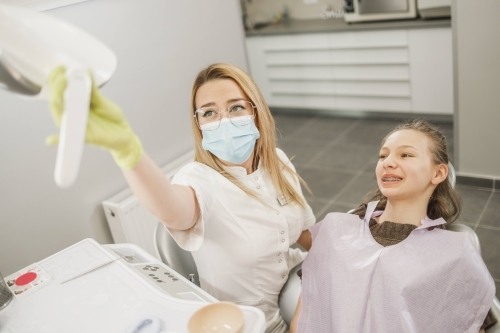
Valentine’s Day is here, and what better time to show your smile some love while you get into the holiday mood? This month is a great time to finally commit to the orthodontic treatment your smile deserves for the smile you have always wanted. Today’s orthodontic options are faster, more discreet, and more affordable than ever.
Give Yourself a Straighter Smile
Enlisting orthodontic help to improve your smile means finding a qualified orthodontist with a proven track record of success, creating those winning smiles that make you want to smile from ear to ear without hesitation. Our orthodontic team is committed to giving you the best possible experience and the results you envision. Between our team’s expertise and your consistent daily care, following your at-home instructions can help you achieve your smile-straightening goals before you know it.
A straight smile is not just a physical improvement by itself. More and more, studies affirm that smiling can actually improve your life by encouraging you to feel more positive about smiling freely. When smiling becomes a natural habit, you will likely experience more success and happiness in your day-to-day life. It’s quite different than when you rarely smiled because you felt embarrassed about your teeth.
Orthodontic Correction
With proper orthodontic treatment, you’ll want to flash that smile, leaving you feeling and looking happier and mentally healthier. So, how can orthodontic care help your smile? By correcting malocclusions of the teeth and jaw, you can look forward to preventing the following conditions:
- Dental decay and tooth loss
- Bone loss from tooth loss
- Changes to your facial appearance
- Gum disease
- Speech issues
- Difficulty or painful chewing
- A painful bite
- Issues with TMJ, including jaw pain
Show Your Smile Some Love
Fixing these dental problems with orthodontic treatment can transform your outlook! To help you feel more like smiling, we recommend that you adopt the following:
- Implement a good oral hygiene routine. Always take the time to brush and floss your teeth as recommended by your dentist. For extra-oral protection and self-confidence, consider rinsing with an antibacterial mouthwash for fresher breath. Try a new toothpaste flavor, switch to a powered toothbrush (with a soft-bristled toothbrush head), or even a water flosser to make cleaning your teeth and gum line easier.
- For better mental health (when it comes to your smile), it’s important to be realistic. Avoid comparing your smile with those of the celebrities you see on social media and television. This includes influencers, actors and especially models. One reason for this is that their photos have more likely been enhanced or edited. Celebrities also typically spend money on cosmetic dental enhancements like teeth whitening, prosthetics or dental veneers.
- Start small by giving your teeth an extra boost by whitening them. Teeth whitening has the added benefit of brightening your whole smile. And when your teeth look white and bright, you’ll feel like smiling more often. Your dentist can help you achieve this goal with the safest and best outcome.
- Invest in orthodontic treatment. Whether you prefer braces or one of the clear aligner therapies available today, you can transform your smile and even your life. Our skilled orthodontist is happy to meet with you to evaluate your teeth, jaw and orthodontic needs to find what will work best for you while staying within your budget.
Orthodontic Consultation
This Valentine’s Day, why not schedule your complimentary orthodontic consultation? You no longer need to be shy about your smile when help is at your fingertips. Our team has helped many people feel good about their smile and overall appearance, and you deserve to look and feel your best. The world is waiting for your smile!
Straightening Your Teeth With Braces in the New Year Can Boost Your Quality of Life

With a new year upon us, it is always a good time to make some changes in our lives that make us mindful of our health as well as our oral health. After all, your smile is one of the very first things people tend to notice about you, so having a nice smile is a great opportunity to make a good first impression. If you are self-conscious about flashing your pearly whites because they are crooked, this might be the perfect time to put straightening your smile on your list of New Year’s resolutions!
Orthodontic Options
Orthodontics not only improves your physical health but your mental health too. Gone are the days when there were limited options for teeth straightening. Today, you have discreet options, like ceramic, tooth-colored braces, clear braces, or even clear aligner therapy. These options effectively straighten your teeth for a more symmetrical look while correcting bite issues and even relieving the pain you feel when constantly grinding or clenching your teeth.
The Power of a Straight Smile
- Increased self-esteem. When your teeth are straight, you don’t have to hide your smile or dodge cameras (and today’s social media often makes photo sharing easier than ever). Feeling at ease about smiling will give you the confidence you want, whether it’s requesting that long-desired promotion or impressing your new date, your smile can light the way to a more confident connection. An aligned smile has the power to change your outlook on life when you feel good about your teeth.
- Better oral health. Poorly aligned teeth or bite issues like malocclusions can also make eating and speaking harder. Crooked teeth can often create pain in your jaw or TMJs and ultimately create poor oral hygiene if you can’t easily clean all tooth surfaces. Crowded teeth can leave you vulnerable to cavities, accumulated dental plaque, advanced gum disease (periodontal disease) and even tooth loss. Wearing braces can turn all that around!
- Better overall health. Did you know that periodontal disease raises your risk of illnesses like heart disease and diabetes? If you have jaw problems, you might experience chronic headaches, earaches, and even stomach pains, all of which can be linked to dental conditions. Correcting your smile with braces can give you a healthier mouth that boosts your general health as well.
- Change facial features. If you have a severe bite issue like an overbite or underbite, the way the jaw sits can also adversely affect your facial symmetry. As braces align your jaws, your facial features will line up properly. If you have had a protruding or receding chin throughout your life, wearing braces can finally fix that by aligning your facial profile.
If you have a list of resolutions you would like to implement this year for a better, healthier you, don’t forget to include your oral health. Good oral health supports your overall health and boosts your mental health. Your new self-confidence can impact you both subtly and dramatically.
Complimentary Consultation
As you commit to making 2023 one of your best years yet, take the time to feel excited about this year’s resolutions. Remember that your oral health is a powerful part of your quality of life. Protecting your teeth will allow you to keep your natural teeth for a very long time.
If you want to make brushing and flossing your teeth easier, braces can help you achieve that goal for a lifetime of healthier smiles. It is never too late to implement positive changes in your life. Our orthodontic team welcomes you to reach out and schedule your complimentary consultation. Your smile will thank you!
Do You Know Which Tooth-Friendly Holiday Treats To Enjoy (and Which To Avoid)?

Celebrating the holidays often means embracing some of our favorite traditions of the year. While you are gathering with loved ones and sharing memories and gifts, it’s still important to protect your teeth, especially when you or your child is undergoing orthodontic treatment.
When wearing braces, there is a list of foods and treats to avoid so as not to damage your braces’ parts. But even if you are wearing clear aligners and take them out to eat, keep in mind that your teeth need to stay healthy and strong even as you undergo orthodontic treatment. This means avoiding harmful foods and drinks that can damage teeth while using clear aligners.
How Sugar Affects Teeth
If you’ve ever gone on a sugar spree, you’ve likely noticed a sticky film coating your teeth afterward. This oral bacterial film is called plaque. You want your teeth to be healthy and strong when your orthodontic treatment, whether with braces or clear aligner therapy, is done. The last thing you want is to have to deal with tooth decay instead of enjoying your newly straightened teeth.
Holiday Treats to Avoid
It’s important to be mindful of the food you enjoy, especially sugary and acidic treats that damage your pearly whites. Keep in mind that these treats are more like rare desserts, not daily snacks that are constantly consumed.
- Sugary treats like candy canes, peppermints and peppermint sticks are basically giant pieces of sugar that can crack a filling or a weak tooth. You’ll also be feeding sugar-feasting oral bacteria that produce tooth-damaging acids, eroding vital tooth enamel. The same goes for seasonally popular caramels, toffee or nut brittle, as they’re sticky, hard and chewy, meaning that you risk loosening a dental filling or cracking a tooth.
- But what about your traditional gingerbread cookies, fudge brownies or Grandma’s lemon bars? While they aren’t hard, they’re loaded with tooth-damaging sugar. Even “healthy” fruit cakes are brimming with bacteria-feeding sugar, as are your favorite pies. Limit these as much as possible.
Do you love eggnog or hot chocolate? A holiday diet of bacteria-feeding sugary drinks can increase your risk of tooth decay. Wine is highly acidic, and soda is both sugar-laden and acidic, while holiday punch is made from sugary fruits with soda. Limit your teeth’s exposure to these beverages, and drink plenty of water to boost hydration and cavity-fighting saliva levels.
Safe Holiday Foods
- Your smile benefits from protein in turkey, ham and salmon as well as the phosphorus, potassium and other essential goodies that support healthy teeth and gums. Salmon, mackerel and tuna are rich in omega-3 fatty acids, promoting gum health.
- Cheese promotes healthy saliva production, which supports tooth enamel, and is high in calcium while lowering acidity in the mouth. Enjoy all your favorites, including brie, Camembert, cheddar and Monterey Jack cheese with their healthy calcium and protein content.
- Vegetables are a great source of fiber that protects against cavities, thanks to their fibrous, tooth-scrubbing texture (think broccoli and celery). They promote saliva production and fortify tooth enamel. So serve up colorful veggie platters brimming with carrots, celery, radishes and root vegetables and side salads made from leafy greens, including kale, spinach, chard or collard greens.
- If you are wearing aligners, you can safely enjoy all the seasonal nuts since you take the aligners out to eat. If you are wearing braces, you’ll want to wait until after your orthodontic braces. Stick to the safe soft foods you love!
- Enjoy a vitamin-filled, festive fruit platter with sliced apples, pears, grapes and kiwis that won’t stick to your pearly whites and are actually healthy for teeth and gums. Clean your braces meticulously after eating.
Happy Holiday Smile
This holiday season, enjoy yourself while protecting your smile as it is being straightened. Even though you’re busy, brush and floss as instructed every day, no matter how tired you are. Before you know it, you’ll be done with your orthodontic treatment and have achieved the smile you have dreamed of!
This Thanksgiving, Give Yourself the Gift of an Aligned Smile for Ultimate Oral Health

November is finally here, bringing with it changing seasons and a time of giving thanks for the things that make our lives better. Nine in 10 people in the U.S. have some type of malocclusion (overbites, underbites, crossbites, protruding teeth, etc.), and for these people, the malocclusion can impede their ability to chew and speak properly. Fortunately, there are orthodontic treatments that can change these conditions for a healthier, more appealing smile!
If your mouth suffers from crooked, crowded or even protruding teeth, it does not just affect your appearance. Poor alignment can make it harder to clean your teeth, allowing bacteria to build up into harmful plaque, premature wear and tear on your teeth, and even trouble chewing properly, leading to poor nutrition. Bite force pressure does not just affect your teeth either; your gums can pull away from your teeth, known as gum recession. Do you have one of these malocclusions?
Types of Malocclusions
Crooked Teeth: Your teeth can become crooked when they are crowded, misaligned and even gapped. This can make brushing and flossing harder than ever, leaving you more vulnerable to tooth decay and gum disease.
Gapped Teeth: Teeth should have very little spacing between them. Lost teeth leave behind gaps that allow teeth to shift unless replaced with a dental restoration.
Crowded Teeth: If your teeth are crowded, this can lead to problems with adult teeth coming in correctly, and if they overlap, they can be hard to clean and can mess up your alignment and bite.
Protruding Teeth: Teeth that stick out instead of pointing down normally adversely affect the ability to speak clearly.
Overbite: Normal upper teeth often overlap a bit, which is fine. But if the overlap is severe, the overbite will need fixing.
Underbite: This happens when the front bottom teeth cover the upper row of teeth when you closed your mouth.
Open Bite: When you close your mouth and your upper teeth do not overlap your bottom row of teeth, this can leave you with a visible gap between the upper and lower rows of your incisors and canines.
Impacted Teeth: This happens when a tooth does not fully erupt or come through properly, and, if it is crooked, leads to its neighboring teeth becoming misaligned.
Why Fix Malocclusions
You might have trouble speaking clearly. Our teeth work with our tongue and lips to maintain proper airflow when we are speaking. For example, some sounds require having the tongue touch the teeth in a certain type of way. Malocclusions can lead to a lisp. Or you might experience jaw pain if your temporomandibular joints are damaged from TMJ disorder. This leads to bruxism while you sleep (clenching the jaw and grinding your teeth), trouble sleeping and even painful eating. Headaches and daytime fatigue also stem from TMJ issues.
Schedule a Consultation
A physical examination, using digital imaging or X-rays, along with looking at your symptoms will help us diagnose your malocclusions so proper treatment can be recommended. You may be able to wear clear aligners to fix certain types of malocclusions, but most often, traditional orthodontics, like braces, are highly effective for optimal results.
We welcome you to give us a call if you are experiencing malocclusions, speech issues or even trouble chewing. We are happy to provide a consultation and recommended treatment plan. Our goal is to help you get your oral health back on track, along with your smile’s appearance and self-confidence! Those are great goals to be thankful for!
Celebrate National Orthodontic Health Month This October With Us in Spook-tacular Style!

Every year, we celebrate Orthodontic Health Month in October, and this year is no different! We love the work we do helping our patients get straighter smiles and aligned bites. With proper orthodontic care, your smile can look its best, your mouth can function properly and your daily oral hygiene routine can be more effective!
Straight teeth are easier to keep clean and even the joints are healthier as proper alignment distributes the pressure over all of the teeth equally like correcting crooked teeth, teeth that stick out, or a bite that is off. Conversely, leaving these conditions untreated often leads to cavities and tooth loss, gum disease and jaw problems. Proper orthodontic treatment is how to harmonize your smile for optimal oral health.
Orthodontic treatment has come a long way since the early days of wrapping teeth in ivory, wood, copper, or zinc, and later gold or silver. Today’s braces materials are high-tech and advanced for maximum results and comfort, so it’s no surprise that the American Association of Orthodontists officially announced observing National Orthodontic Health Month.
Why Observe National Orthodontic Health Month
Straighter teeth ensure clearer speech. Common speech problems include lisping, whistling, word slurring and mispronunciation. If your tooth placement and jaw structure hamper tooth movement, that can interfere with your tongue placement so you can’t form your words properly and end up with a stutter or slurred speech. Mispronunciation occurs when your teeth are out of alignment, making it hard to enunciate sounds like “T,” “S,” or “CH,” which rely on tongue-to-tooth contact. And finally, lisping and whistling often happen from an overbite (your top teeth overlap the lower teeth) or gaps between teeth, preventing the right tongue placement so that air escapes when you speak.
This month is a great reminder to have your child’s growing smile checked for potential problems. Spotting crowded or overlapping teeth, detecting jaw growth issues, and poor tooth development can all be treated and prevented. Your child could have tooth and jaw issues because of cavities, losing baby teeth too early, trauma or injury to the mouth, and even thumb-sucking that goes on for too long.
Straight teeth also help you feel good about yourself. This confidence comes when you have a smile you can be proud to show off, instead of hiding crooked teeth. If your child has a straighter smile, they will likely perform better in school as they feel more at ease and self-confident when speaking or smiling.
Observing National Orthodontic Health Month
Now is a good time to schedule an orthodontic appointment for an evaluation. A properly aligned mouth can help your teeth function correctly and give you the appealing smile you want. It can also make biting, chewing, and even speaking easier as well as making brushing and flossing easier and more effective. Being able to thoroughly brush and floss your teeth is vital to good health and straight teeth facilitate easier, more effective cleaning.
Stay away from harmful foods. We know it’s October and treats are everywhere, but consuming a lot of sugary treats and candy can do a serious number to your teeth. And it’s not just your teeth that suffer; if your diet includes too much sugar and not enough nutritious foods, your gums will pay the price too ending up with gum disease.
Braces-Friendly Halloween Treats
- Hershey Kisses
- Chocolates
- Malt balls
- Jello and pudding
- Ice cream and yogurt
- Peeled and thinly-sliced apples
- Peanut butter cups
- Soft peppermint patties
National Orthodontic Health Month is a great time to practice a braces-friendly diet that protects gum health and prevents cavities. Limit Halloween treats, and brush and floss each day thoroughly. Rinsing with a healthy mouthwash can also boost your oral care. And finally, we urge you to keep all scheduled routine visits to ensure your orthodontic treatment stays on track. Celebrate October with us in spook-tacular style!
How Effective Is a Water Flosser for Your Teeth and Gums When You’re Wearing Braces?

If you are wearing braces to correct your tooth and bite alignment, now more than ever, you need to take optimal care of your teeth and gums. Braces can get in the way of normal oral cleaning tools when brushing and flossing, making it harder to remove stray food particles and bacterial debris from your teeth and gums.
Consistent Oral Hygiene
We tell our patients to make cleaning their mouths a top priority so that when their braces come off, their teeth will look, feel, and function better than ever. Thanks to continuing technological advances, there are more effective oral hygiene tools than ever to protect your smile! One of these involves flossing, as normal flossing tools might have trouble cleaning around wires, bands, and brackets.
Thankfully, you can still effectively care for your smile while undergoing orthodontic treatment in braces with the help of a water flosser! A water flosser (or oral irrigator) can easily clean around teeth and gums, so they stay healthier and pain-free. Flossers emit a pressurized jet (or pulse of water) that removes much of the hassle of maneuvering dental floss or flossing picks around orthodontic hardware. That’s an extra motivational boost you’ll appreciate while straightening your teeth!
It’s important to note that brushing and flossing need to be completed diligently while wearing braces. It means brushing and flossing after every meal so nothing stays trapped in the hardware or the surfaces between teeth. Cleaning behind the wires and areas between brackets is essential for a thorough cleaning. If your flossing tools are hard to use, you’ll probably be more tempted to skip flossing altogether, and over time, that’s bad news for your mouth.
Brushing and Flossing Between Braces Hardware
While a normal toothbrush can do the job, using a sonic toothbrush can make the job easier for you. Sonic toothbrushes have vibrating brush heads that expertly clear away bacterial plaque and food particles from your braces hardware, so brush after each meal or snack you consume.
Tip: If you’re away from home and can’t brush right after eating, use water to rinse your mouth well and clear out some of that oral debris.
Why go to all this effort when wearing braces? To keep your mouth free from dental problems like these:
- Bad breath
- Cavities
- Gum disease
- White spots on teeth
- Yellow or brown stained teeth
Using Your Waterpik
Waterpiks are the most popular water flossers on the market. They spray water to flush out food particles and often have an orthodontic tip that works perfectly to clean braces. This tapered brush is made clean the hard-to-reach dental plaque around braces’ brackets and wires. It makes short work of food particles and germs from under and around your teeth.
It’s pretty easy to use a Waterpik to clean your teeth in braces. After you fill the device’s water tank with warm (not hot) water, bend over the sink while angling the water flosser at your gumline. Then turn the flosser on and gently move the flossing tip around your gum line and clean between each tooth. Close your lips around the flosser while cleaning so you don’t splash water everywhere. That’s pretty much how easy and quick flossing can be with a Waterpik!
We encourage you to make your oral hygiene routine as easy and effective as possible while straightening your pearly whites. You can even boost your daily habits by using fluoridated toothpaste or fluoride rinse to keep cavities away. Before you know it, your braces will come off, and your teeth will look better than ever!
Getting Your Child’s Smile Ready for the New School Year Wearing Braces

Back-To-School ads are off and running as summer winds down and a busy school year is on the horizon. If your child is also beginning the school year wearing braces, that will likely involve a huge adjustment for your child or teen. There will be dietary adjustments to make, extra care taken when practicing their daily dental hygiene routine, and wondering how their friends and other classmates will react to their new look in braces.
But with a little preparation and care, you can make this transition as comfortable for them as possible and easier for them to navigate. You’re probably already busy helping them acquire new clothes, shoes, backpacks and school supplies.
Tip: If you haven’t already, it’s a good time to get their routine checkup and dental cleaning out of the way so they can start the new school year ready for those school photos!
Getting Used to Braces
Here’s our advice for helping your child who is wearing braces this school year to get accustomed to their shifting teeth as smoothly as possible.
- Sticking to soft food choices like mashed potatoes, pasta, soups, stews, smoothies, yogurt and ice cream is necessary after routine braces adjustments. The rest of the time, they will still need to steer clear of hard or crunchy foods that can damage their braces hardware. They also need to replace sugary and starchy snacks with fresh fruits, veggies, whole grain crackers, sugar-free gum, and cheeses.
- They will need to be more diligent with their daily brushing and flossing because it’s easier for food particles and bacterial plaque to hide between braces parts. They can do a good job of cleaning around these parts by using an electric toothbrush as well as interdental brushes and flossing picks. Stock up on whatever they need to keep in their backpack to use after school lunch or snacks.
- Tuck orthodontic wax into a zip lock baggie filled with other dental tools into their backpack, along with toothpaste, a toothbrush and extra elastics as part of a braces care kit. The wax effectively protects sensitive oral tissues when wires are poking the mouth. The wax is soft and easy to roll between their fingers and then place it over the braces hardware that is irritating them.
- If your child is active in sports throughout the school year, they should be wearing a protective mouthguard over their braces. It saves the braces as well as your child’s teeth and soft oral tissues against injury from impact, just as goggles protect their eyes.
- Make sure your child keeps a water bottle in their backpack for easy hydration and to rinse out trapped oral debris that keeps their breath fresher and tooth decay away. In fact, consuming sugary drinks like fruit juices, energy drinks, sports drinks, and soda can lead to cavities while wearing braces.
- While your child is wearing braces, it’s important to detect and treat cavities early before they grow in size. Fluoride can also help prevent tooth sensitivity by fortifying tooth enamel while dental sealants can protect those rear molars from decay.
A New School Year and Smile
The more comfortable your child becomes with their new braces, the easier it will be for them to blend in with their peers. If your child feels self-conscious about their braces, once they notice their fellow students walking the hallways wearing braces as well, the better they will feel about blending in.
How Can an Orthodontist Fix Your Mouth and Jaws for Optimal Alignment?
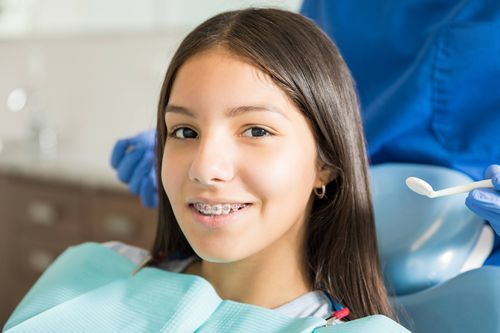
Do you know the difference between a dentist and an orthodontist? Both work hard to keep your teeth and mouth healthy, but we orthodontists have additional training so we can treat tooth and jaw misalignment. We also participate in a two- to three-year residency, finishing with over 4,800 hours of orthodontic training under our belt!
Orthodontic Training
Not only do we orthodontists complete the same coursework and training that your dentist does by earning a bachelor’s degree, but we also graduate from a four-year accredited dental school program to earn our orthodontic certification. During this time we go through an orthodontic residency program that takes two to three years, teaching us the skills we need to practice orthodontics with all the qualifications needed to pass. In the end, your awesome dentist finishes eight years of higher education while we end up with 10-11 years of school when we’re finished!
So what does this mean for you? Whether you are tired of seeing crooked teeth when you look in the mirror, or your dentist refers you to us after diagnosing you with a misaligned bite, our orthodontic team has the qualifications you need to help you. Like your dentist, we take your oral health seriouslyand look forward to helping you achieve your healthiest, aligned smile that will also help you look and feel your best when you look into the mirror!
What We Can Do for You
As orthodontists, our goal is to help you correct the alignment of your teeth and jaws. While a more appealing smile results from straighter teeth, we actually focus on your jawbone health, along with aligning your teeth and correcting abnormalities in your mouth and face. Our day-to-day duties center on procedures and treatments that fix your occlusion, misalignment and tooth abnormalities. For example, having crowded teeth or a bite that is off, such as an underbite or overbite along with crooked teeth are all issues with your alignment. When you come to our orthodontic practice for treatment, we might perform any of the following:
- Evaluate your smile to spot abnormalities in your mouth, jaw and face
- Take X-rays and molds to assess your teeth alignment
- Place orthodontic braces or another orthodontic device (aligners, retainers, etc.)
- Straighten teeth with the help of orthodontic surgery
- Supervise your child’s tooth growth and alignment
Of course, while helping your smile look better than ever is part of our specialty, crooked, or misaligned teeth should be treated for non-aesthetic reasons, because problems with your mouth can leave you with lockjaw, speech impediments, headaches, etc. So solving these problems can improve your overall quality of life! So how do you know whether you should see a dentist or an orthodontist for your oral health concerns? Here are some signs to help you decide:
When Should You See an Orthodontist?
- Your teeth are crowded from insufficient space in the jaws or the size of your teeth
- You struggle with teeth that are either misaligned, overgrown, or crooked
- You have an overbite, underbite, crossbite or openbite
- Your teeth need to be straightened
- You feel discomfort or pain in the mouth or jaw (TMJ) requiring a retainer, etc.
- You struggle when chewing or trying to speak
- Your palate needs to be expanded
Call Today!
Whatever you do, don’t put off recommended orthodontic care. Don’t like braces? No problem! Clear aligners can often fix the issue so you feel less conspicuous. Your oral health is as important as your overall health, and regular visits with your dentist and our orthodontist can help you maintain a healthy, beautiful smile for years to come! You deserve high-quality orthodontic care. Please call us to learn more or address your concerns!
Flossing Your Teeth Daily While Wearing Braces Is Essential for Healthy Teeth and Gums
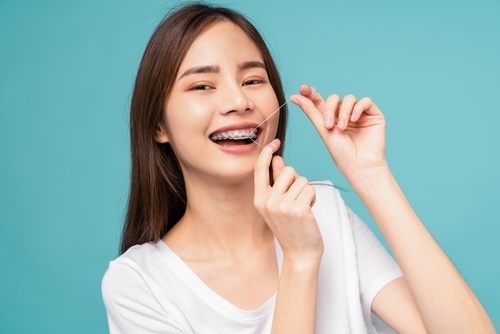
One of the biggest challenges to keeping your smile looking and feeling its best is to take the time every day to brush and floss your teeth (which also benefits your gum health). When you receive orthodontic care, you will want to step up your oral hygiene game to ensure your teeth and gums stay healthy when your braces come off. It means brushing and flossing become even more tooth-protecting habits than ever. Flossing, in particular, is essential because your toothbrush can’t do the job.
Flossing, or interdental cleaning, removes the harmful dental plaque that builds up around the teeth and gum line. Plaque, or biofilm, is a bacterial film that attacks tooth enamel and gum tissue. And while toothbrushing does a great job cleaning tooth surfaces, it can’t squeeze into the areas between teeth. It takes a flossing tool to clear out those tight places where the teeth meet and along the gum line. When wearing braces, you need to be able to get in there and clear out the harmful bacteria every single day if you want to avoid preventable dental issues.
What Happens When Plaque Lingers Between Teeth
- Dental plaque not removed daily quickly hardens, turning into tartar, which will need to be removed by a hygienist using tartar removing tools.
- Lingering plaque and tartar target your gums, inflaming them, so they hurt. The good news is that catching gum disease in the beginning stage is removable, but not so with advanced periodontitis.
- Dental caries or cavities crop up when tartar makes holes in your tooth enamel. When this happens, you can find yourself with toothache pain or infection with diseased gums and teeth that may need an extraction or a root canal to save it.
- Chronic oral health problems have been directly linked to general health conditions, including Alzheimer’s, cancer, and cardiovascular and respiratory disease.
Flossing Around Braces
If you wear clear aligners to straighten your teeth, you can remove them to thoroughly brush and floss, removing dental plaque. With braces, you have to be a little more dedicated. Remember, the key is finding a flossing method you like using to motivate you to floss your braces consistently.
- Waxed or unwaxed string floss: Pull out the amount you need, wrap it around your index fingers and then glide it between your teeth and braces parts to lift oral bacteria and food particles. Throw away when done.
- Dental picks: The floss comes pre-attached to a plastic holder, so you slide it gently between teeth and braces hardware to get rid of oral debris. Toss it after using.
- Interdental brush: These tiny toothbrushes are ideal if you have small gaps between your teeth or braces that you can clean.
- Water flossers: These oral irrigators come with tips that you can aim a water stream between teeth and your orthodontic appliance. It allows for a more precise cleaning while protecting your braces. Begin at the back of your mouth where the molars sit. Next, follow your gum line to clean each tooth. A good rule of thumb to follow is to aim the stream over each tooth for two seconds.
American Dental Association Seal of Acceptance
Finding your favorite flossing tool can help you achieve healthier teeth and gums with a beautiful smile. Look for the American Dental Association Seal of Acceptance to check the product for safety and effectiveness. These safety and performance tested products pass strict inspections to help ensure you get your wanted results. If you are investing in braces to get your teeth straightened, shoot for a goal of decay-free teeth and disease-free gums!
Summer Is Almost Here, and Now Is the Time To Get Your Braces and Straighten Your Teeth!

With summer right around the corner, it is a great time to think about getting your teeth straightened and getting a jumpstart on an orthodontic treatment plan! Whether you consider wearing aligners or braces, there are benefits to getting orthodontic care during these warmer, less hectic months.
The summer season is a great time for kids and teens to adjust to braces during these more laid-back months. With braces, they have to come into the office routinely to have their hardware adjusted and tightened. By the time school starts back up in the fall, they have had time to get used to navigating them. It also makes the process easier for you as well!
Why Summer?
If you are warming up to the idea of wearing orthodontics this time of year with its relaxed schedule, think about the valuable benefits of wearing braces during the summer:
- A more relaxed schedule: Summer’s downtime allows you to focus on getting used to wearing your braces without worrying about navigating the hectic fall and winter months. It is even more applicable if you have vacations or staycations coming up! Your summertime schedule allows you to work with our orthodontic team for routine adjustments and tightening with far less stress.
- Adjust to your new normal: Ease into the experience of wearing wires and brackets. Having something new in your mouth all day takes getting used to, and it feels less stressful when you are not so busy. With conventional metal or ceramic braces, you will need to get used to the brackets and wires in your mouth and how to keep them clean from trapped food particles that feed oral bacteria. You do not want cavities showing up when your braces come off!
- Dietary changes: Typically, when you start orthodontic treatment with braces, you will have to acclimate to new food restrictions. Be mindful of avoiding the chewy, crunchy and hard foods you normally enjoy. You will have a list of foods to stay away from, like popcorn, gum, fruit snacks and more, to protect the hardware of your braces. It is a great time to take advantage of easy-to-chew seasonal fruits like melons, berries, bananas, grapes, mangos and peaches! Just be sure to brush and floss afterward to get rid of fibers and stray bits of food.
Why Wait? Start Now!
Starting the summer with orthodontic treatment, whether for yourself, your teen, or your child, is a great time to move forward at a relaxed pace without unnecessary stress. Your child won’t have to miss classes for appointments, and you won’t have to navigate fall traffic while you are in the early phase.
Summer also gives you time to adjust your new dental hygiene routine with less stress. You will need to get acclimated to brushing around braces. It is a good time to enlist the help of a powered toothbrush and a water flosser to clear out food around your braces appliance. The same goes for your child or teen so they can get used to their new dental hygiene practice without dealing with the early morning school rush. When the braces come off, teeth and gums need to be as healthy as before orthodontic treatment began.
Call for Consultation
Whether you or your child need braces to straighten teeth, align a crooked bite, and prevent future dental health issues like tooth decay, tooth loss, or gum disease, it is never too early (or too late) to have our orthodontist take a look at your smile. We offer consultations to evaluate smiles and recommend life-changing orthodontic treatment, so call today!
How To Protect Your Teeth and Gums During Orthodontic Treatment

If you are wearing braces or another type of orthodontic aligners, taking good care of your teeth and gums is more important than ever. Good daily oral hygiene care is needed to protect your teeth and gums from oral infections while straightening your teeth. You don’t want to end up with dental problems like cavities, tooth discoloration or tartar buildup at the end of your orthodontic treatment.
When you first get your braces, they can hurt your tongue, cheeks, and other areas as your mouth gets used to the metal. When the wires rub against the soft tissues, it can be uncomfortable or downright painful. Thanks to dental wax, you can find much-needed relief as the waxy layer buffers the contact between the metal edges of your braces and your oral tissues so they can heal.
What’s in Dental Wax?
This wax is made from natural materials and sometimes comes with added ingredients like mint to make it taste better. Common types of dental wax may contain the following:
- Beeswax
- Carnauba wax (Brazil wax and palm wax)
- Microcrystalline or paraffin wax
Dental wax is solid when at room temperature and then softens by the heat of your hands as you shape it. Just smooth it out over the parts of your braces that touch (or irritate) your oral tissues. To put the wax onto your braces, start by making sure your hands are clean, and take a moment to brush your teeth. After pulling off a small piece of wax, squeeze it to soften it, and then shape it into a ball. Flatten the ball a bit and gently apply it to the parts of the braces that are poking you.
You can keep the wax on overnight and replace it every couple of days (as needed). It is okay to eat and drink with the wax on the braces, but if bits of food particles stick to it or the wax feels dirty, you can change it out. To clean your teeth, take it off so you can properly brush and floss with an interdental cleaning tool between the teeth. Follow up with mouthwash to further protect your tooth enamel.
Protect Your Teeth With Custom Mouth Guards
Now that spring is here, so are outdoor activities like contact sports and recreation. Whether you play soccer, baseball, or skateboard, you will want to protect your teeth and gums while getting your teeth straightened. You do not want to get a sports-related mouth injury during your treatment!
To avoid getting broken teeth or injuries to your lips, tongue, and cheek lining, mouth guards can protect your investment. These mouth protectors work by cushioning blows and lowering the risk of injury. A custom mouthguard can often be made and be ready in three to four weeks. Since you are already investing in orthodontic treatment, get the added protection of a custom mouthguard that perfectly fits your teeth. This will ensure that it fits comfortably and will not suddenly fall out during your recreational activity.
Protect Braces From Bad Habits
For those wearing braces, it is also important to protect the metal parts from harmful habits like nail-biting, unnatural tongue thrusting, chronic pencil chewing, and even nervously picking at your wires. If you harm your orthodontic hardware, it can leave you with additional appointments and even an extended treatment time. Remember to do what you can to protect your smile and call our orthodontic office right away if your braces are damaged.
Never skip your dental cleanings and exams while getting orthodontic treatment, whether you wear braces or clear aligners. Your dentist can remove harmful tartar deposits so your smile can thrive. If you would like to learn more or schedule a visit with our orthodontist, call us today!
Learn How Orthodontic Treatment Can Help Correct an Open Bite

There are various reasons for seeking orthodontic treatment, including straightening your teeth and aligning your misaligned bite. Another reason is correcting an open bite. It is a common dental issue and can be effectively addressed with orthodontics.
You want your upper and lower teeth to come together with a slight overlapping of the upper teeth over your lower teeth when you close your mouth. An open bite is considered a malocclusion (also known as a bad bite). This condition arises when your top and bottom teeth don’t meet whenever you close your mouth all the way. So what you get when you try to close your mouth is an open space between your top and bottom teeth. While you can get an open either in the front or the back of your mouth, it’s most likely to occur to your front teeth.
Even if you close your mouth and jaw shut all of the way, an open bite can occur when the upper and lower teeth don’t come into proper contact in the front (or back) of the mouth. And when you have a bad bite, the malocclusion can leave you dealing with a host of problems. It can include pain when you clamp down to chew, problems cleaning your teeth properly (leaving the potential for cavities), and gingivitis (gum disease).
Open Bite and What To Look For
- Your teeth are out of alignment
- Trouble speaking properly
- Trouble biting down with your front teeth
- Trouble or pain when chewing and swallowing, affecting your digestive tract
- Your teeth don’t make contact when you close your mouth
- Diminished chin line adversely affects your facial profile
- Temporomandibular joint dysfunction (TMD)
- Headaches and earaches
- Sleep difficulties
- Snoring
Why an Open Bite Bad Is Bad for You
As you can see, an open bite harms your teeth, mouth, and body if you can’t eat properly, but it also affects your image and self-confidence. Your bite will only worsen with time, and your tooth enamel wears down in the process, risking tooth decay and cavities. If you find yourself dealing with an open bite, it is important not to ignore it. Coming in for an orthodontic evaluation is a vital step to determining the degree of malocclusion and correcting it with orthodontic treatment such as braces or clear aligners.
- Braces: Braces are reliable, cost-effective and you can choose from several different options. They can provide beautiful results and are relatively easy to maintain for children and adults.
- Clear Aligners: These are comfortable, discreet, and convenient to wear. They are great for correcting open bites for adults as well as teens.
- Retainers: Once your orthodontic treatment is complete with either clear aligners or braces, you will still need to wear a retainer to make sure your bite doesn’t fall back into misalignment. Retainers serve a dual purpose; they keep your newly aligned teeth and bite in their place. Without it, your teeth can regress to their original position and adversely affect your bite again.
- Oral Surgery: As a last resort, oral surgery can help when orthodontic treatment alone can’t correct the malocclusion. Long-lasting results are achievable by combining orthodontic treatment with oral surgery for a severe open bite.
Why Wait? Call Today!
There is help if you struggle with an open bite and are ready to align your teeth and jaw for exceptional results. It is a worthy investment in your oral health, appearance and self-esteem. With today’s advanced orthodontic treatments and techniques, you can achieve the smile you have always wanted while correcting the many issues you might have from your open bite. Why wait? We welcome you to call us today for more information or a consultation.
Wearing a Retainer After Straightening Your Teeth Is Essential for Continued Alignment
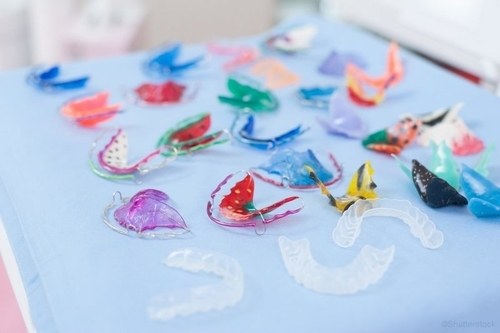
Congratulations on getting orthodontic treatment for the health and appearance of your smile! Whether you wore braces or clear aligners, you will still need to wear a retainer to maintain that beautiful symmetry with your newly aligned teeth and bite. While wearing braces or clear aligners is phase one of your orthodontic treatment, retainers are phase two to ensure continued success.
Why Are Retainers Needed After Braces?
Your newly straightened teeth will not be able to hold their new positions without a placeholder to maintain them. In orthodontics, we call that retention, meaning your teeth retain their position instead of gravitating back to their old places.
Your teeth are kept in their place by a tissue layer of cementum, which weakens when the teeth are manually moved. Think of a rubber band. This layer of cementum will try to pull your gums back to where they started after your orthodontic treatment. Wearing a retainer keeps the cementum staying in its new position while your teeth and tissue fully adjust.
If you do not wear a retainer, you allow your cementum and gums to shift back; retainers work by holding the tissue where it has been moved. Over time, your teeth will adjust to their new positions with the help of the retainer.
How Your Retainer Supports Your Smile and How To Care for It
- Stabilizes your bite: This oral appliance gives your soft tissues and bone time to adjust to their new place when worn consistently. It is called stabilization as wanted shifting is kept to a minimum.
- Protects your mouth from improperly erupting wisdom teeth: If you have had orthodontic treatment in your teen years, your retainer will keep your newly erupting wisdom teeth from shifting your straightened teeth.
- Keeps your bones and gums aligned with your teeth: With the help of your retainer, your teeth, bones, and gums will stay strong and stable for years to come.
- Prevents the need for additional orthodontic treatment later: Properly wearing your retainer (both night and day as recommended) means your teeth won’t shift out of the desired alignment you worked so hard to achieve.
Types of Retainers
- Fixed or bonded retainer: A strong wire bent around the inside of your teeth is cemented in place to keep your teeth aligned and stable. Brush and floss daily to keep your retainer free from harmful plaque formation. It also means keeping all scheduled routine dental cleanings so hardened plaque (tartar) is removed and doesn’t irritate your teeth and gums.
- Hawley retainer: The base of this popular retainer is made from plastic or acrylic and metal bars that wrap around your newly straightened teeth on the top and bottom. You can take it out to eat and clean.
- Clear plastic retainer: This clear retainer made from plastic conforms to your teeth for a perfect fit while keeping them in place. Clean them every day to keep them looking and feeling their best!
What Not To Do With Your Retainer
Wear your removable retainer as directed and clean it using cool water to avoid warping (no dishwasher, hot water, alcohol or bleach to clean). Do not wear your retainer while dining, and keep it in a sturdy container case when you take it out, so you don’t lose it. Don’t use abrasive cleaners like toothpaste or baking soda to clean your clear retainer, and brush gently with a soft-bristled toothbrush. While it might be tempting, don’t swim with your retainer so you don’t lose or damage it.
We hope you love your straightened teeth and are committed to protecting them by properly wearing your retainer. After investing in a beautiful smile, you can easily keep it that way by taking good care of your teeth, gums, and retainer every day! If you have any questions about orthodontics or retainers, give us a call today! We love to help!
Now Is the Time To Set Orthodontic Goals for an Aligned Smile!

It’s that time of year again when we look back over the past year and make some goals to better ourselves mentally and physically. For many, that includes improving their smile! While considering your New Year’s resolutions for this year, be sure to include improving your smile on your list! And what better way to improve your smile than getting orthodontic treatment?
A Great Smile Starts With Good Oral Health
You already know that keeping teeth healthy means brushing twice a day and flossing daily. You want to keep dental plaque away so it doesn’t harden into tartar (which your dental hygienist then needs to remove). But did you know that straight teeth are easier to clean effectively? Having crooked or overlapping teeth makes oral hygiene harder and leaves teeth vulnerable to cavities and gum disease.
Why Orthodontic Goals?
While you are setting new goals for 2022, consider putting your smile on the list to make improvements with orthodontics! Brushing and flossing are optimized with straight and aligned teeth. Not only does this spare you from unnecessary tooth decay and gum problems, but it will also protect you from having trouble chewing and eating. Being able to flash a straight smile boosts your self-confidence around others, whether in school, the workplace, social gatherings, or dating! An aligned smile can leave you smiling from ear to ear and laughing more openly because you are happy with your smile.
Modern Orthodontic Options
Gone are the days of bulky and uncomfortable metal braces. Today’s orthodontic treatments can range from smaller, smoother, and more esthetically pleasing braces as well as removable clear acrylic aligners. Modern braces are lighter and more forgiving, which can make them more comfortable and more efficient at shifting teeth. It also translates to shorter treatment times than in the past and fewer office visits to get adjustments. And while you can still get metal braces if you prefer, you can also get ceramic braces or braces with colorful brackets. Kids and teens often enjoy colorful braces, while adults often opt for clear aligners.
Oral Hygiene While in Orthodontic Treatment
No matter what your choice of orthodontic treatment is, you must brush and floss your teeth daily. Cleaning teeth is easy to do while wearing clear aligners and will keep teeth and gums healthy, but you also need to keep your aligner trays free from harmful bacteria, food particles, and even dried saliva. Speaking of saliva, it is important to stay hydrated throughout your day by drinking enough water so your mouth can flush out harmful bacteria and food particles that cause tooth decay. For this reason, avoid alcohol while undergoing orthodontic treatment to protect healthy tooth enamel and avoid bacterial acids. It lessens your risk of getting cavities, gum disease or other oral health problems that might interfere with your orthodontic treatment.
Avoid drinking anything other than water while wearing clear aligners, as that can stain them. Hot drinks can also warp your aligners, so avoid hot chocolate, tea, or coffee! But even with braces, you will want to avoid soda because of the sugar and acids, both of which accelerate tooth decay! Even sports drinks and fruit juices are high in sugar that decay teeth.
Initial Complimentary Consultation
No matter what type of orthodontic treatment you ultimately choose, our orthodontic team is excited to work with you this year to create the aligned, beautiful smile you deserve! We welcome you to give us a call so we can schedule your complimentary initial orthodontic evaluation. We look forward to helping you fulfill your New Year’s resolution for a spectacular smile!
Do Your Teeth Need To Be Healthy and Cavity-Free Before Getting Braces?

You’ve decided to wear braces. Congratulations on investing in your smile for a healthier and more attractive appearance! Straight teeth are also easier to clean, maneuver around and in between, so you actually benefit from better oral health along with beautifully aligned teeth!
Cavities and Braces
But what about braces and cavities? While our orthodontist can help you align your teeth and bite, we can’t treat tooth decay and cavities. It is your dentist’s job, so if you want braces soon, make sure your dentist performs a thorough checkup. They can take care of any cavities before placing your braces.
You want to make sure your teeth (and gums) are healthy before wearing any metal or ceramic braces. Teeth are harder to clean around braces hardware with brackets and wires. And if you aren’t cleaning your teeth well, tooth decay can gain a foothold. Since the brackets bond onto and in-between your teeth, these areas also become harder to floss around, making them prime targets for cavities.
So, what causes cavities? Forming plaque in the mouth from oral bacteria, stray bits of food particles, saliva, and acids in the mouth combine into a sticky, bacterial film, which quickly hardens into tartar and calculus (that stuff your dentist eliminates during dental cleanings!). Unless removed, the acids attack tooth enamel, weaken it, and create holes in the tooth (a.k.a. cavities).
Bottom line: You’ll want to start your time in braces with your teeth as cleaned and cavity-free as possible!
Another reason you want to treat cavities (and gum disease) as quickly as possible is to minimize damage to your teeth and gums. Both conditions only worsen with time, and if left untreated, they don’t resolve themselves. The longer you wait, the greater the damage. And putting braces on weak teeth can leave you with bigger problems like cracks or fractures that eventually could result in lost teeth later.
Caring for Teeth in Braces
Once your teeth have a clean bill of health and you finally get your braces, you’ll need to go the extra mile and commit to brushing and flossing well every time you eat to keep your teeth strong and cavity-free. Keep braces clean and free from plaque to prevent decay around your braces appliances.
- Brush after each meal to prevent plaque and tooth stains. Make sure to remove all the bits of food stuck around the hardware.
- Floss thoroughly around brackets and wires and the spaces in between teeth.
- Invest in tools you will want to use and will meticulously clear away food particles and plaque. These include floss threaders, a proxabrush or Waterpik.
After spending 18-24 months in braces, you don’t want the hardware to come off only to discover cavities and weakened teeth from decay. If, for some reason, you need to have cavities treated while in braces, we will likely need to take out the wire so your dentist can get to the cavity and fill it. It also means scheduling your dental and orthodontic appointments as close together as possible so your wire can be replaced soon after the cavity is filled so that your teeth don’t move out of their new position.
You will also want to give your dentist a heads up if you notice any tooth sensitivity or pain when you chew or consume hot or cold foods and beverages. Keeping your teeth and gums as healthy as possible is always the goal throughout your life, and even more so when you are committed to straightening your teeth for an amazing smile!
October Is National Orthodontic Health Month! Here Are Some Brace-Friendly Tips

It’s October, and we’re celebrating National Orthodontic Health Month along with the American Association of Orthodontists (AAO). Our goal is to help promote orthodontic health and share some tooth-friendly tips about orthodontic treatment to help you create a healthy, beautiful smile!
A great smile starts with healthy, strong, aligned teeth for a proper bite. Our goal is to work with you to create the straight teeth you need for your healthiest smile. We can align the position of the teeth and jaw using braces, clear aligners, and retainers. With orthodontic treatment, teeth can stay aligned in place for years to come. Orthodontics can be used on children, teens, and adults.
Straight teeth aren’t just optimal for appearance’s sake, either. An aligned bite with straight teeth allows better access to thoroughly cleaning teeth and gums when brushing and flossing. Having a correctly aligned bite and straight teeth are necessary to keep out dental decay and gum disease that can otherwise lead to tooth loss.
Benefits of Orthodontic Treatment
- You will create your healthiest bite when your jaw is in its optimal position. It helps you evade issues with biting, chewing, and speaking as well as avoiding sleep apnea.
- Straightened teeth won’t scrape or grind together, prematurely wearing down tooth enamel or causing dental issues later that will require expensive treatment like crowns, bridges, implants, or dentures.
- Attain a self-confident smile you will be proud to show off instead of hiding! Did you know people with attractive smiles are considered more successful in social and work situations?
As you can see, orthodontics has benefits that improve your quality of life!
National Orthodontics Month and Clearing Up Misconceptions
Thanks to the efforts of the American Association of Orthodontists, people can see that:
- Dentists are not automatically orthodontists who can offer braces or aligners.
- Orthodontics can be affordable.
- Periodical orthodontic visits to monitor the process is part of the treatment.
- Orthodontics does not require years to straighten teeth.
- Orthodontic treatment is not only for cosmetic improvements.
- You can choose between braces or aligners to get the results you want.
- Orthodontics is not just for kids and teens. More adults than ever get their teeth aligned!
What You Can Do
- Seek orthodontic treatment for your child while their jaw is still developing to spot potential problems early, and don’t wait until your child loses all their baby teeth before visiting an orthodontist.
- Seek orthodontic treatment if you are unhappy with your smile; it is never too late for straight teeth!
Tips
This National Orthodontic Health Month, we offer you some tips to keep braces or other orthodontic appliances safe while keeping cavities at bay:
- Halloween or not, don’t snack on hard, sticky, crunchy, or chewy candy and treats. Here is the no-go list: anything with caramel, gummies, licorice, taffy, tootsie rolls, bubblegum, jelly beans, and sodas.
- Make sure to stay away from hard-shelled peanut candies, nuts or nut-filled candies, taco chips, popcorn, and ice.
- Brush and floss every day, especially while wearing braces. Sugary-, starchy- or acidic-like materials tend to gather around brackets and other braces gear, so you will want to clean them well every day.
- Treats you or your child can enjoy while wearing braces include soft chocolates (peanut butter cups, peppermint patties), milkshakes, ice cream, Jell-O, cake, doughnuts, and soft cookies. While these are easy on braces, you’ll still want to brush and floss after enjoying them.
Navigating orthodontic treatment during the holiday season does not have to invite tooth decay. By taking just a few tooth-friendly precautions and practicing consistent oral health care, teeth receiving orthodontic treatment can stay strong and healthy for a beautiful smile for years to come. Feel free to call us if you have any questions or would like to schedule a consultation with our orthodontic team!
Check Out These Braces’ Tools To Keep Your Smile Healthy!
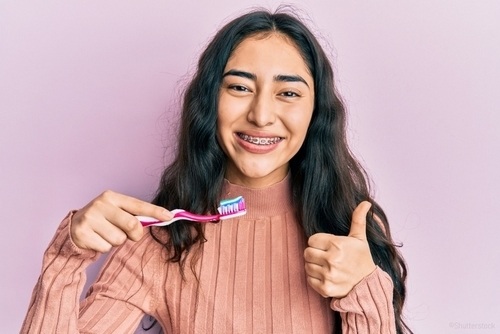
Caring for your teeth and gums is essential for a healthy, beautiful smile. You want to get rid of the harmful plaque daily that will otherwise damage your teeth and gums. This sticky, colorless film made of bacteria, food, and saliva builds up around the teeth and gum line and quickly hardens. When you are wearing braces, this trapped buildup can lead to swollen gums, cavities, bad breath, and even permanent tooth stains. To prevent this, you will need to brush and floss every day to get rid of plaque before it gets a chance to harden.
Cleaning Teeth in Braces
Cleaning around your braces can be a challenge as their extra parts mean additional areas for food to become trapped, but with the help of the right tools, you can do a great job of preventing this! You will especially want to remove plaque buildup around braces brackets to keep tooth decay and gum inflammation away.
Pay special attention to any cracks and crevices, both between your teeth and around your braces’ brackets and wires. Use a soft-bristled toothbrush and replace it as soon as the bristles lose their shape, preferably with fluoride toothpaste to protect tooth enamel. Avoid tooth whitening toothpaste because it can’t whiten behind your braces brackets, so it won’t look uniform when your braces come off.
Brush thoroughly and gently in circular motions so as not to damage your wires or brackets, and clean all surfaces at least twice a day so they are spotless:
- All the parts of your braces
- All tooth surfaces (tops, sides, front and back)
- All around the gums, tongue and roof of your mouth
Next, you will want to floss, preferably before you go to bed so you can take your time. A floss threader is a reusable tool that helps you clean below the archwire, along the gum line and below it. You can also rinse well with mouthwash to help clear away any residual oral debris.
Orthodontic Hygiene Tools
- To better help you keep your teeth in braces healthy, consider trying these excellent oral hygiene tools:
- Get a toothbrush and toothpaste you will love using. It might be a manual toothbrush or a powered toothbrush with an ortho brush head to clean the cracks and crevices around your braces. The oscillating movement is gentle on your gums, cleans wires and brackets effectively, and even massages the gums.
- Pack a travel-sized toothbrush, toothpaste, and mouthwash you can carry in your backpack, pocket, or purse to clean after meals when you are away from home.
- Stock up on waxed floss threaders, super floss or dental picks as they can get underneath the wires to clean well.
- Consider getting a proxabrush. This interproximal brush has bristles in a short cone shape that easily handles those hard-to-reach spots in your braces.
- Invest in a Waterpik or similar water flossing tool. This effective addition works by aiming a stream of water to clean easily between your teeth and may come with orthodontic tips!
- Use a good mouthwash (preferably with fluoride) to remove bacteria hiding in crevices and to support your tooth’s enamel.
- Wear a mouthguard when you are engaging in contact sports or recreational activities to protect your face, mouth, and braces’ hardware.
- Use orthodontic dental wax for your braces as needed to protect sensitive oral tissues.
- Let us know if you have any issues with your braces’ wires and brackets so we can take care of any problems quickly.
Don’t forget to keep all your scheduled dental cleanings and checkups. These are important for supporting your daily oral hygiene care, so when your braces come off, your teeth will look their best! As always, we are happy to recommend great products that can help you in your orthodontic journey, so please don’t hesitate to call and learn more! You deserve a healthy, beautiful smile!
Tips To Help Your Child Experience an Amazing School Year While Wearing New Braces!

It’s that time of year again! As summer winds down, getting your child ready for back-to-school days can be both exciting and stressful, especially if they are new to wearing braces. Fortunately, it just takes a little bit of preparation, and your child will be back in the swing of things in no time, feeling confident instead of self-conscious!
Wearing braces can make your child feel shy as they wonder what their peers will think about them, but soon enough, they will see that they are not alone and are in good company surrounded by others in braces, so they will actually blend right in. To best prepare them, they’ll need some oral hygiene supplies in their backpack as their new routine falls into place.
Back-to-School Braces Kit
The best way to prepare your child is by giving them a braces care kit to stow in their backpack along with their pens and notebooks. It will make their braces as easy as possible to care for and help them be ready for anything. All it takes is a small bag with the toothy tools they’ll need while wearing braces to keep braces clean and their mouth comfortable throughout their school day. Supply your child with the following tools in their braces care kit:
- Toothbrush, toothpaste and floss (to clear away food particles after lunch or snacks)
- Dental wax and extra rubber bands (to cover brackets or wires irritating their cheeks, gums, or lips)
- Lip balm (to keep their lips moist and comfortable)
- Small mirror (to spot any stray bits of food stuck in teeth)
Watching What They Drink
Did you know that water helps your child’s brain work faster, boosts concentration, balances mood and emotions while improving memory? Staying hydrated not only boosts brain productivity but helps your child keep their braces clean and free from stray bits of food particles. Packing a refillable water bottle will also help clean their mouth while stimulating healthy saliva levels. It will also help them avoid sugary drinks and sodas that can stain their teeth, potentially leaving white spots when their braces finally come off!
Watching What They Eat
Be sure your child knows to avoid certain foods while in braces. It means leaving crunchy things like raw carrots, whole apples, nuts, and sticky foods like candy and gum behind as they can break wires and brackets that your child won’t enjoy dealing with during their school day. Make sure your child packs foods they can easily consume (like yogurt or applesauce) that can take the sweet-craving edge off in a way that’s good for their teeth. Packing a lunch can take the guesswork out of lunch lines in a crowded cafeteria while being friendly to their smiles. Providing meals from home (cut into easily chewed, bite-sized pieces) can make lunch simple and easy, even with sandwiches.
Watching What Gets Trapped in Their Teeth
A handy tool for ensuring your child’s teeth don’t harbor stuck food particles in their braces all day is to have a small mirror in their backpack. It can help them feel less self-conscious and catch bits of food early, so they don’t need to feel embarrassed while talking with old and new friends! Especially since no one may tell them, hey, you have some spinach in your teeth.
Protective Mouth Guard
And finally, wearing a mouthguard when engaging in gym classes or contact sports can increase the odds of keeping your child’s teeth, gums, and cheeks damage-free. Whether your child has a volleyball, football, or basketball streaking towards their face, a protective mouthguard can give their smile the safety they need. You can even get them a mouthguard designed to fit over their braces to save your child from pain and injury.
There’s no better time than now to give your child the right tools to succeed in the new school year! Helping them be prepared for their first week while wearing braces can help them relax, feel more confident, and be ready to smile for school photos, classes, and activities. It can be their best school year yet!
Check Out These Tips To Help You Prevent and Handle Orthodontic Emergencies and Accidents

Whether you are wearing braces or clear aligners to straighten your teeth, accidents can happen, potentially leaving you dealing with an orthodontic emergency. With proper planning, however, you can be prepared for just about anything! And you will definitely want to take care of anything that comes up with your orthodontic device.
Top Three Causes of Orthodontic Emergencies
1. Biting or chewing foods that are on the “do not eat” list.
It can be hard to stop eating your favorite foods that are bad for braces. Just remember that staying away from braces-damaging foods doesn’t just protect wires and brackets but also your teeth in braces! Before you know it, your teeth will be straightened, and you can go back to mindfully eating the following foods:
- Caramel or other hard or sticky candy
- Crunch chips
- Ice
- Popcorn with kernels
2. Participating in high-impact or contact sports without a protective mouthguard.
Wearing mouthguards is a simple, easy and effective way to keep your teeth, lips, gums, soft tissues, and jaw safe as you participate in sports. You can find sports guards online and in stores, but your best bet is to get one from your dentist or orthodontist. Orthodontic mouthguards are a little bigger than their standard counterparts, so they fit comfortably over your braces.
3. Trauma or injury to the mouth.
If you take a hit to the mouth, your braces can often keep your teeth from falling out. But you can also have chipped or broken teeth from a blow, so the best thing you can do is let our office know right away so we can recommend optimal treatment as needed. Sometimes it can wait until your next scheduled appointment, and other times, we might need to see you sooner.
Common Orthodontic Fixes
- If you have broken or loose brackets, putting some orthodontic wax on it can help. If your bracket falls off, our orthodontist will want to replace it with a new one the next time you come in.
- Protruding wires poking the back of your mouth can often be put back into place with clean tweezers, a cotton swab or an eraser tip. You can also cover it with a piece of orthodontic wax and call us so we can advise you further (or see you sooner).
- If you have lost rubber bands, you can try using a clean tweezer to put it back where it belongs.
- If you have mouth sores from your braces hardware, putting some wax over the brackets can help. You can rinse with saltwater (one teaspoon of salt in 8 ounces of warm water) to relieve pain and prevent infection and put some topical anesthetic on the painful ulcer on your lips, gums, cheeks, or tongue.
- As your teeth gradually shift into their new positions, you can sometimes find yourself with painful teeth or even loosening. If this leaves your teeth aching, you can treat the soreness by rinsing with saltwater. If your jaw feels tender, you can apply a heating pad or warm washcloth (on the outside of your jaw) for relief.
- If you are wearing a plastic aligner (instead of braces) and it cracks before you switch to the new set, you can often continue wearing it. However, if the tray breaks all the way, wear your previous tray so that your teeth movement stays on track and let us know so we can advise you further.
Protect Your Orthodontic Appliance
Whether you are wearing clear aligners or traditional braces, taking good care of your appliance while your teeth are being straightened is essential to prevent orthodontic accidents. Keep it clean and properly maintained (not skipping scheduled visits!), and brushing and flossing your teeth every day as recommended. That also goes for retainers, and if you have a break in a bonded retainer, you’ll need to come in to have that fixed or replaced.
We hope these tips help you feel more comfortable handling potential orthodontic accidents or injuries. When in doubt, always give us a call, and we can give you further instructions based on your situation. We look forward to making your time straightening your smile as comfortable and pleasant as possible!
What You Need To Know About Malocclusions

When people think of orthodontics, they tend to visualize teeth straightening using metal braces or clear plastic aligners. But orthodontics is about more than just beautifully straightened teeth. It also corrects a misaligned bite! Malocclusions are what we orthodontists call “mismatched teeth” or jaw problems because of a misaligned bite. It is also more common than you might think! Around 2/3 of adults experience some malocclusion that can interfere with their oral health.
Orthodontists refer to occlusion as where your teeth meet when you close your mouth. So essentially, where your upper and lower jaws contact those teeth. Ideally, we want your teeth to sit comfortably inside your mouth with a slight overlap as the upper jaw meets your lower jaw when closing your mouth. The molars need to be able to fit into the grooves of the molars opposite them. What we don’t want to see is crowded teeth, diastema (tooth gaps), or teeth that are rotated or twisted. When your teeth deviate from what they should be, you will be dealing with malocclusion.
Classes of Malocclusion
Class I:
- As the most common type of malocclusion, you’ll see that the molars align as well as minor crowding in the back teeth with a slight overlap.
Class II: Called an overbite, the upper teeth greatly overlap the lower jaw and teeth.
Class III: Called an underbite, in these cases, the lower jaw protrudes, so the lower teeth overlap the upper jaw and teeth.
There are several different kinds of malocclusions that can cause trouble with your smile. Don’t ignore the following:
Crossbite:
- When some bottom teeth meet outside the upper teeth when you close your mouth.
Open bite: Your upper and lower teeth tip outwards, unable to come together when you close your mouth.
Overbite: Your upper teeth and jaw overlap severely over the lower teeth and jaw.
Overcrowding: Your permanent teeth don’t have enough space to grow straight so that you have teeth that overlap or end up crooked, rotated, or twisted.
Overjet: Your upper front teeth extend past your bottom lower teeth.
Spacing: You see spaces between two or more teeth where there should be none.
Underbite: Where your lower teeth protrude past your upper teeth when your mouth is closed.
How You Know if You Have a Malocclusion
- You notice abnormal wear and tear on your teeth
- You have misaligned teeth
- You have trouble biting and chewing food
- You see changes in your facial profile
- You keep biting your tongue or the inside of your cheeks
- You keep getting headaches
- Your constantly grind your teeth (bruxism)
- You have pain in the neck, shoulder and upper back
- Your speech is affected
- You have teeth, jaw and mouth pain
- You are a mouth breather
Diagnosing malocclusions usually involves having dental X-rays and an examination. Then our orthodontist can determine the cause and recommend proper corrective treatment. Treatment might involve wearing an orthodontic appliance like braces, aligners or retainers. Other solutions might include extracting teeth, reshaping teeth, stabilizing the jaw with plates and wires, or using a palatal expander.
Call for an Orthodontic Evaluation
Malocclusions typically get worse if they are not addressed, even to the point where brushing and flossing become difficult, leaving you vulnerable to cavities, gum disease and, over time, tooth loss. If you suspect you might have malocclusion, we invite you to come in for a consultation and evaluation. Our orthodontist can help you get the aligned smile you deserve!
Clean Your Teeth in Braces With the Help of a Water Flosser!
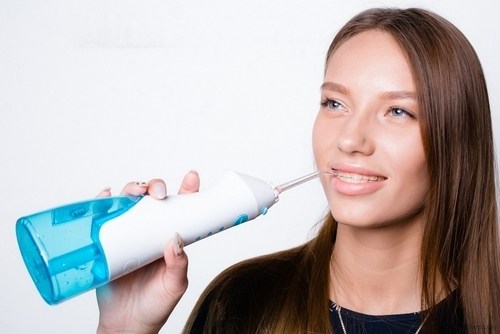
When you or your child wear braces, you want to make sure you take good care of your teeth while they are in braces so that when they come off, your smile can be healthy and beautiful! You already know about needing to brush thoroughly daily to get rid of food particles and bacterial plaque, but now more than ever, you also need to floss! Flossing, however, must be done carefully so as not to damage the components of the brace. We have an easy solution to help keep your teeth clean and your braces safe!
Avoid Gum Disease and Decalcification
Your smile in braces is vulnerable to oral health issues. It can include gingivitis (gum disease) and decalcification (white spots on your teeth), which can cause other serious problems if you aren’t careful. That’s why we stress daily oral hygiene care, particularly if you are wearing braces! You don’t want to end up with gingivitis where your gums look red, swollen, and shiny from bleeding easily. Getting rid of plaque prevents your gums from being irritated and infected. But it’s not just your gums that can have problems with poor oral hygiene in braces. Your tooth enamel can become decalcified, leaving white spots when your braces come off. That’s because plaque creates harmful oral acids when you eat or drink something, damaging tooth enamel.
Water Flossing to the Rescue
Water flossers operate by way of a water stream, which you manually direct from a handheld device to clean in between the tooth crevices and braces parts. Water flossers are also called powered interdental cleaners, dental water jets and an oral irrigator. No matter what you call them, they have many advantages!
Ease of use:
- You don’t have to manually work the water flosser to clean around your teeth and gum line. Point the sprayer tip at the parts of your braces while the water flosser emits the stream in steady pulses as you direct it around your teeth, gum line and braces hardware.
Safe to use: It can be daunting to floss around braces without worrying about breaking something, but, unlike regular flossing tools, water flossers are gentle enough to be safe around braces hardware without damaging or loosening braces brackets or wires.
Easy on the gums: If you have used flossing tape, strings, or picks, you might have noticed bleeding or inflammation around your gums from the pressure. Water flossers eliminate that threat, so both your teeth, gums, and braces are thoroughly cleaned. While traditional flossing tools can damage gums (and even braces), a water flosser is gentle around your oral tissues and hardware.
User-friendly for adults and kids: Whether you are an adult who has arthritis in the hand or carpal tunnel in your wrist or find maneuvering most flossing tools difficult, water flossers are an easy fix coming to your rescue! They can be used by anyone who has manual dexterity issues as long as you can hold the handle and point the tip at the area you are trying to clean.
They are a high-end flossing tool: Traditional flossers can still miss getting rid of oral debris, including harmful bacteria and stray bits of food, especially in the areas above and below your gum line. Flossing can easily clean your braces to prevent cavities and gum disease.
Traditional flossing tools can damage oral appliances: Like braces, other flossing tools can get stuck and cause problems around crowns, fillings, bridges, and dental implants. Water flossers are safer to use around them all!
Faster than other flossing methods: Without careful maneuvering around braces parts, water flossers can get into the tiniest areas and handily get rid of dental plaque and food gunk.
Call Today!
We are excited to straighten your teeth and encourage you to maintain their health and beauty by consistently brushing and flossing every day! A good toothbrush, as well as a water flosser, are two indispensable tools in your oral health toolbox! Call us to learn more about cleaning your braces and answer your orthodontic questions!
Early Orthodontic Intervention Can Help Your Teen Get the Smile They Want

Teens who are happy with their smiles have more success socially with their peers as well as in their school work and other activities, thanks to their increased self-confidence. Conversely, teens who are self-conscious or embarrassed by their smiles tend to struggle as adolescence can be a challenging time.
Orthodontic Evaluation
We recommend having your child’s teeth evaluated to see if there are any developing orthodontic problems. In fact, you can have your pre-teen’s smile checked out as early as seven years of age! The American Association of Orthodontists® recommends that a child has their first orthodontic examination when they are seven years old, so problems can be detected and fixed later when they are between 12 to 16 years old. If they have crooked teeth, tooth gaps, or bad bites, their smile is already in trouble.
Adolescents are often more open to wearing braces because that’s also when their friends may be wearing them, so they don’t feel alone. Instead, they feel like they fit in. Pre-teens and teens also have growth spurts, which is a great opportunity to align their teeth and have a proper bite (often with a shorter treatment time as their metabolism is so high). Another benefit of straight teeth and an aligned bite is that your child’s oral and physical health can improve.
It is easier to shift your child’s teeth and jaw alignment into place versus when they are grown because their facial growth isn’t yet complete. Once the teeth and jaw stop growing, orthodontia can be harder for them and tends to cost more.
Better Oral Health
Correctly aligned teeth help your teen speak more clearly, chew their food, breathe, and sleep better, and help them feel confident. Straight teeth are easier to clean, so they can prevent cavities and gum disease as well as headaches if their jaws are misaligned.
Your child might need early treatment if they have malocclusion from:
- Accidental injury or trauma
- Extended thumb sucking or pacifier use
- Dental disease
- Premature tooth loss
These can all affect tooth alignment, facial growth and appearance. Braces are ideal if your child has an overbite, overcrowded teeth, protrusions or gaps between teeth. But, in the age of social media and selfies, many teens are shy about wearing metal braces. Fortunately, ceramic braces are a great alternative as they are more discreet. If your child is younger, having colorful rubber bands can be a desirable aesthetic if their peers are also wearing braces, while older teens do better with clear aligners because they are hardly noticeable.
How do you know if your teen needs braces?
- They feel self-conscious about their teeth and lack self-confidence
- They have trouble chewing and biting their food
- They have teeth with too much space between them
- There is overcrowding in the mouth
- Their bite is off (malocclusion)
- Their jaws make clicking or popping sounds and are prone to shifting
Putting off an orthodontic evaluation can mean bigger problems for your child later on. We are happy to evaluate your child’s teeth and bite with an initial consultation. If they are younger, our orthodontist can assess their oral health and development. If problems are spotted early, they are usually less invasive and least costly to correct.
Call Today!
If your child has never had an orthodontic exam or they are exhibiting any of the issues we talked about, we strongly recommend scheduling a consultation to ensure healthy tooth and jaw growth. They deserve to have a healthy, confident smile, especially if they see their smile daily when sharing selfies and interacting with their friends!
What Are the Risks of “Do-It-Yourself” Braces and Is It Safe for Your Smile?

For people who are wanting to straighten their teeth, braces are a modern marvel that can make that happen for just about anyone under proper supervision. And while the cost of orthodontics makes some people hesitate, you wouldn’t try a do-it-yourself gallbladder surgery or BOTOX injection, would you?
Everything comes with risks, and the harmful option of doing braces yourself deserves serious scrutiny. It is because DIY braces gone wrong can leave you with a long, painful recovery, not to mention the cost of fixing the damage in the future. It’s no wonder that selling and distributing non-professional do-it-yourself braces is illegal!
DIY braces often involve paper clips, fishing line, floss, and rubber bands. While saving money seems to be the key motivator behind doing your own, the cost of fixing the damage is not worth the risks, which are plenty! Some of the objects used are bad for your health as well as your teeth.
Orthodontic Problems
- Cavities
- Damage to the gums
- Gum disease and infection
- Issues with the jaw or bite inconsistencies
- Root shortening or resorption
- Loss of otherwise healthy teeth
You have to remember that one size doesn’t fit all. So even getting online aligners can cause dentition problems because they need bite pattern customization. It is why you have your bite analyzed by our orthodontist, so a personalized treatment plan is created for your smile.
When it comes to your health, saving money by cutting corners can have serious consequences. You are probably safe to go ahead and paint your walls yourself or lay down flooring because neither of those should harm your health if they are not properly done. However, it is not the same case with your mouth! Our orthodontist is specially trained, and the products and technology used to align your smile are proven to be effective and safe!
Rely on the Experts
Both the American Dental Association (ADA) and the American Association of Orthodontists (AAO) promote orthodontist treatments under the expertise and protection of an experienced, trained, certified professional. You want to make sure someone is monitoring your outcome, and you have resources if there is an emergency or problem along the way. When it comes to your oral health, safety is crucial; otherwise, you risk permanent damage to teeth and gums, including tooth loss!
Some DIYs involve rubber bands to lessen spaces between teeth, which can cause the tooth to rotate or tip. Metal objects like twist ties and paper clips easily injure your soft oral tissues, including your gums, cheeks, or tongue. If left untreated, they can lead to an oral infection. Traditional orthodontics controls the pressure placed on your mouth as teeth gradually shift into their new position. An at-home version can be too loose and ineffective or too tight, loosening your teeth. In some cases, you might end up causing damage that leads you to require emergency dental care with problems to your jaw or gums.
Our orthodontic treatments ensure that your progress and shifting are supervised and controlled, and your smile is healthy when the braces or aligners come off. You don’t want to end up with a smile made worse from mistakes or improper usage. It is why we have you come into the office regularly to adjust your braces or safely switch to your next set of clear aligners.
Questions To Ask Yourself
The American Association of Orthodontists (AAO) suggests asking yourself the following if you are considering at-home braces:
- Will this DIY braces’ treatment be based on information from having my X-rays taken, including assessing my skeletal structure with full scans of my teeth and my upper and lower jaws?
- Will there be a licensed dentist or orthodontist supervising the creation and customizing of my aligners?
- Are my teeth and gums healthy enough to undergo orthodontic treatment?
- If there is an emergency, can I see a dentist or orthodontist in person?
Saying no to any of these questions means risking your dental health, and you could end up with decaying or abscessed teeth or worsening gum infections from the DIY orthodontic treatment. So while you can easily save money by painting your home yourself or installing a new deck on your own, it is dangerous to turn to DIY orthodontic treatment.
If you want straight teeth and an aligned bite, we invite you to call our team to schedule an appointment with our orthodontist. If financing is a concern, we offer payment options to help you get the beautiful smile you deserve! Your oral health and your smile are important to us!
Braces in the New Year Can Give You a Straighter Smile You Have Always Wanted!

January is a great time to start the new year with good intentions and healthy choices. It is also a great time to look at your mouth to make the changes you need to have a more aligned, beautiful smile. Crooked teeth and misaligned bite patterns can wreak havoc on your teeth, gums, and self-esteem. In fact, aligned teeth are so much easier to clean that you can keep cavities and gum inflammation away!
Thanks to continued advances in orthodontics, your smile can often get the treatment it needs to look and feel your best at a price you can afford. Depending on your needs, we offer traditional braces as well as clear aligners. We offer orthodontic treatment for patients of all ages who are looking to improve their smile’s appearance and function, and starting your orthodontic journey is easier than you might think!
Initial Complimentary Consultation
It’s easy to get the answers you are looking for when it comes to straightening your teeth. Beginning the journey with an initial consultation allows you to tell our orthodontist what you are looking for, and a careful examination of your smile can help us give you the answers you need and how we can help you. Assessing your oral health and bite pattern allows us to provide you with a tailored treatment plan so you know what to expect and a timeline that will take you to your desired goal. From there, we can help you set up affordable payment options for your orthodontic treatment.
Paying for your Smile
Orthodontics might seem costly, but we are happy to offer you affordable payment options that can help you realize your smile goals, whether you choose braces or clear aligners to fit your budget. We are happy to work with your dental insurance as well as offer financing options with a down payment and monthly payments. We are here to help you get the straightened teeth you need and deserve at a price you can afford that will work for your lifestyle.
Not Just Straighter Teeth
Orthodontic treatment has health benefits that help alleviate a variety of dental health issues, including bruxism (where you constantly clench and grind your teeth together), enamel erosion that can leave you with cavities, receding gums, and teeth you can’t clean between even though food particles get stuck there, leading to bad breath and gum disease. Crooked teeth harboring harmful oral bacteria contribute to diseases like strokes and heart disease!
Whether you are looking for subtle orthodontic treatment options like clear aligners, or braces that blend in with your teeth, or simply want conventional braces, we can help. Even brackets are smaller than they used to be.
Excited to Smile
If you are tired of having crooked teeth that make you feel embarrassed to smile, it’s not too late to get the image in the mirror that you’ve always wanted. You don’t need to hide your smile because of crooked, misaligned teeth or be reluctant to speak up, which can limit your professional and personal life. People might even mistake your lack of smiling as being unapproachable, even though you are simply reluctant to show your teeth. Wearing braces at any age can give you the good oral health you deserve and a smile you can be proud to show off.
Call Our Orthodontic Team Today!
We are excited to help you reach all of your smile goals by straightening your teeth. 2021 can be the year you get started on creating the aligned, beautiful smile you have always wanted to have. With proper orthodontic treatment, you can look into the mirror with pleasure and confidence while bettering your oral health with straight teeth that are easier to keep clean and cavity-free. Call today to schedule your consultation and start achieving your smile goals!
Why You Need To Wear a Retainer After Orthodontic Treatment
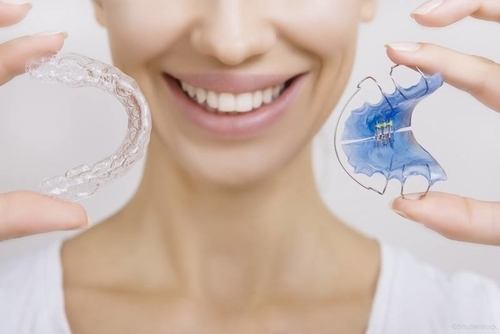
Orthodontics straighten your teeth to correct a bad bite, teeth that are crooked or protruding, misaligned jaws, and other malocclusions. Over time, untreated misaligned teeth can cause problems with talking, chewing food, becoming cavity-prone, inviting gum disease, and end up creating poor oral health overall.
It is why orthodontic treatment is so important. Straightening teeth has many benefits, like making it easier to keep tooth and gum surfaces free from bacterial plaque, whether or not you use metal or ceramic braces or clear plastic aligners to get the job done. Once this treatment is finished, the next goal is to keep your teeth in their newly aligned position to maintain your dream smile. Then begins phase two of your orthodontic treatment.
Orthodontic Phase II – Wearing a Retainer
Whether you use traditional orthodontics or one of the popular clear aligner options on the market today, you will want to make sure your teeth stay aligned after the treatment ends. Retainers are created specifically for this task of maintaining your smile’s new alignment.
Why Wear a Retainer?
The job of your retainer is to keep your teeth in place after the orthodontic work is completed. One of the reasons is that newly aligned teeth still need to settle into your soft tissues and jawbone that supports them. It is what your retainer does, keeping your teeth from naturally shifting in the months and years to come. In this way, you allow your teeth to adjust to their new positions over time instead of migrating back to their original places. Your retainers are your support system to keep your smile aligned after all your hard work in braces.
When you first finish your orthodontic treatment, that first month can put you at the most risk for your teeth to relapse. Your teeth will try returning to their old position before your orthodontic intervention. This early in the game means you’ll need to wear your retainer around the clock for your first month (except when you’re eating and cleaning your teeth).
After a month, your teeth will be more at home in their new position. However, your teeth will still be vulnerable to moving during the first year after you wear braces or aligners. It means wearing the retainer some of the time so that your teeth don’t forget where they’re supposed to align. Your retainer will be customized to perfectly fit your smile.
Types of Retainers
- Fixed Retainers: Also called permanent retainers, this is a wire cemented to the back of your teeth (often the lower front) to keep them in their proper position. For some patients, they’ll need to be kept there permanently, while for others, it may only need to stay there for a few years.
- Hawley Retainers: This version is perhaps the most common of them all, made from acrylic and metal that conforms to your mouth’s shape while being held in place using a wire that goes around your teeth.
- Invisible Retainers: These clear plastic retainers look like you are not wearing them, and you will take them out when you eat or brush and floss your teeth.
How Long Do You Need To Wear Your Retainer?
For your child or teen, your orthodontist will determine how many hours a day they will need to wear their retainer for them to be effective. Some of this will be determined by the type of retainer they will wear and how much their teeth had to shift from their original positions. They might need to wear it full time during the first month, up to six months, followed by a couple of years at night only. However, if you wore your braces as an adult, the retainer will likely need to be worn more frequently. That’s because aging can change your mouth’s shape (and face), so you may need to wear your retainer at night or have a permanent retainer.
Without a retainer, your teeth will eventually shift back to their original position. You can proactively protect your original investment of time, energy, and money spent in orthodontic treatment by wearing and maintaining your retainer. Give us a call if you have any questions about straightening your smile!
Orthodontic Headgear Can Help Your Child’s Developing Smile and Facial Profile

Wearing an orthodontic headgear (or extraoral orthodontic appliance) allows our orthodontist to correct your child’s growing bite and support proper jaw alignment and growth. This appliance is usually recommended for children whose jawbones are still developing. A headgear can ensure symmetrical facial aesthetics by guiding their profile to grow in alignment. Headgears can also close tooth gaps between teeth, correct an uneven jaw bite from an overbite or underbite, and even correct teeth crowding.
Orthodontic headgear helps align smiles by using gear worn outside of the mouth that is attached to braces inside the mouth. Wearing braces with a headgear creates needed tension on them with the help of its various parts:
Headgear Parts
- Head cap
- Fitting straps
- Facebow
- Elastic bands
- Tubes
- Hooks
- Chin cup
- Tubes
- Hooks
- Forehead pad
- Mouth yoke
Your child’s age is what makes the headgear so effective because while they are in their child or teen years, we can move their growing jaws so they properly align and sometimes even help move their teeth (especially their molars).
Your child may need to wear their headgear for one or two years. While they may not be as enthusiastic about wearing the headgear as we are, let them know that wearing it now can help them avoid jaw surgery when they get older. It can help keep sleep apnea and temporomandibular joint disorders (TMJ) away.
Three Headgear Types
When your child’s bite is misaligned, it is called malocclusion. There are three kinds of malocclusions correctable by wearing orthodontic headgear. There are also three main types of headgears your child could wear, depending on the problem being fixed.
- Cervical: This headgear fixes an overbite and anchors around the back of your child’s neck.
- High-pull: This headgear also anchors at the back of the head but corrects both an overbite and an open bite.
- Reverse-pull facemask: This headgear corrects your child’s underbite by moving the jaw forward, but it anchors onto both forehead and chin.
To ensure an effective outcome, your child needs to wear their headgear anywhere from 12 to 14 hours a day (or longer). Usually, we start your child off by wearing the headgear for an hour and then increasing each day until they work up to the recommended time that will ensure success. It typically means wearing the headgear after school and through the night. Encourage your child to stick to their assigned schedule so the headgear can make the changes more quickly.
If your child experiences pain or the headgear isn’t fitting right, you should contact our orthodontist because it may need adjusting.
Other basic headgear guidelines include the following:
- Take it off while eating (drinking through a straw is okay while wearing the headgear).
- Take the headgear off while they clean their teeth to make the task easier.
- If your child wears braces that are attached to the headgear, they need to stay away from chewing gum, hard candies, and hard-to-chew foods. Soft foods help after an adjustment.
- Avoid contact sports and rough activities while they wear their headgear.
- Take mild, over-the-counter pain medication for initial discomfort after an adjustment.
- Eating cold foods can soothe aching gums.
- Applying cold packs to the painful parts of your child’s face or jaw can also offer relief.
As you can see, while your child needs to commit to wearing their headgear consistently for optimal results. When they are finished, their aligned smile and straight teeth will be worth it!
Set Halloween Rules For Safe Trick-or-Treat Eating With Braces!

Halloween starts off the busy holiday season where the nights get longer, the days grow cooler, and festivities begin. If you are wearing braces, Halloween may be a little tricky for you this year. Resist temptation by only keeping treats that are safe for you to eat and letting yourself enjoy them, guilt-free!
Sugary Treachery
Holidays aside, it is important to remember that sugar is bad for your teeth in general. Oral bacteria feed on sugars and starches and then release enamel-eroding acids. With braces, grazing on sugar can lead to cavities and decalcification, harming tooth enamel and affecting the state of your teeth (or your child is in braces) when the hardware finally does come off.
Oral Health Tip: Whenever you or your child eat sugary treats, rinse and brush those teeth thoroughly around the brackets and gum line, cleaning every single tooth. Clearing away plaque and acids help avoid cavities!
If you or your children are currently undergoing orthodontics, we recommend the following braces-friendly treats to keep smiles safe this Halloween season:
Satisfyingly Safe Treats
- Ice cream without hard to chew chunks or nuts
- Chocolate milkshakes and pumpkin-flavored smoothies
- Soft chocolate like peanut butter cups, Kit Kats, Reese’s Pieces, 3 Musketeers, Oreos, Hershey Bars or Kisses, plain M&M’s, and peppermint patties
- Gelatin without nuts or hard fruit chunks
- Blondies and brownies
- Soft, chewy cookies without nuts
- Sliced apples with a thin, diluted caramel sauce (it can’t be super sticky or it will pull on your braces hardware)
- Soft candies or candies that you know you will suck on (never bite!) until they dissolve
Avoid These Tricky Treats Like the Plague
Snacking on these bracket and wire-damaging sweets can mess with your braces hardware before you know it:
- Candy apples, because biting into a regular apple can harm your braces, so any apple should be sliced or cut into small chunks. If the caramel coating is thick, it will double your risk of braces damage!
- Hard or sticky candies like Skittles, jelly beans, gummy candies, licorice, taffy, caramel, nutty M&M’s, and gumballs or bubble gum.
- Hard candies like Tootsie rolls or pops, Starburst fruit chews, or Jolly Ranchers. These can also damage teeth yank off your cement out of your braces bands.
- Sour candies like Warheads and Sour Patch Kids have acidic levels that can wear down tooth enamel, increasing the potential for cavity development.
- Any kind of brittle; they are hard by nature and sticky to boot!
- Regular or sweet popcorn as the popcorn shells get stuck in the gums and can lead to pain or infection.
Horrifyingly Hard on Braces
The reason hard and sticky candies are so bad for your braces is because people typically bite down on them. That is when the scary stuff happens, like breaking off a bracket or bending a wire and having it poke your soft oral tissues. Do not let your treats damage your braces, at least if you want to avoid having to come in and see us more than usual. Remember, every time a bracket or band needs replacing or repairing, it sets the orthodontic process back a step.
What happens when you do have a problem with your braces hardware? Be sure to call our orthodontic office right away, so we can take care of it as soon as possible and get you back on track. We hope you safely enjoy the upcoming holiday season, starting with Halloween!
Prepare for the School Year Equipped With a Handy Braces Toolkit!
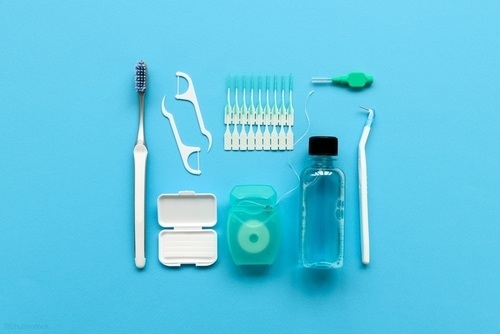
Did your child receive braces this summer? If so, they will need to prepare themselves for the new school year by learning how to keep their teeth healthy while getting them straightened. The goal is to have a healthy, beautiful smile when their oral hardware comes off. Since they will be spending a good chunk of their time away from home during the week, they should have the tools they need to keep their smiles safe at school. Even if your child isn’t spending their time in a school this year, a toolkit is essential to have on hand.
At-School Braces Toolkit
The first thing we recommend is making sure they have a basic braces care kit that they can keep with them or in their locker. Consider equipping them with the following tools to help them be prepared to maintain their oral health while away from home:
- A brand new, soft-bristled toothbrush to clean their teeth after eating and some fluoride toothpaste.
- A dental flossing tool they like to help remove food particles after a snack or lunch.
- Some orthodontic wax to keep braces from irritating soft tissue in the mouth.
- A tube of lip balm to keep lips moisturized and fend off irritation from the braces hardware.
- A pencil that hasn’t been sharpened to push a poking braces wire back into place.
- A compact mirror to spot food particles stuck on braces after eating.
- Rubber bands in case one breaks while they’re away from home.
- A container to hold their clear aligners (instead of straightening their teeth with braces) or their retainer while they eat.
- Water bottle or reusable beverage container.
- An orthodontic mouth guard to protect them if they participate in P.E. or gym class. These fit over their braces during games and practices no matter what sport they are playing.
Know What to Eat for Lunch and Snack Breaks
School lunches (or even just grabbing a quick snack between classes) can leave oral debris around the braces hardware as brackets and wires tend to trap food particles easily. Along with carrying their braces toolkit in their backpack, they should also be aware of food restrictions while at school. Teach them which items are on the braces-friendly list as well as ones that are not – specifically hard, crunchy or chewy foods. One thing you can do to help them is to keep track of their weekly school lunch menu or simply provide them with homemade lunches in their backpacks. If your child likes to raid the in-school vending machines, let them know which foods are off-limits (such as hard or sticky candy, pretzels and chips).
Braces-Friendly Food List
- Soup
- Lean meats
- Mashed potatoes
- Pasta like spaghetti & macaroni and cheese
- Steamed vegetables
- Soft fruits like applesauce
- Soft-bread sandwiches cut into bite-sized pieces
- Egg dishes
- French fries
- Yogurt and smoothies
Drink Water!
Another essential is having them take a water bottle to school every morning. Water helps them keep their saliva levels at optimal levels, preventing dry mouth and neutralizing acids from foods. Water can also help rinse away oral debris between brushing and flossing at school.
Avoid Sweetened Drinks
Make sure your child knows to avoid sugary drinks like soda, fruit juice, chocolate milk and even Gatorade! These sweetened drinks can trap and feed oral bacteria around brackets and wires, setting the stage for cavities and stains on tooth enamel. If you think your child will sometimes indulge in sweetened beverages while at school, tell them to use a straw (or tuck some in their backpack) to keep the liquid sugar from pooling on their teeth.
Smile With Confidence
As your child adjusts to wearing their new braces, they will feel more confident and willing to smile, knowing one day their smile flaws will be corrected as the braces come off. There are also plenty of other students wearing braces, so they will see that they are not alone. With school pictures coming up around the corner, your child can smile with pride!
Are You Ready to Straighten Your Teeth? What You Can Expect at Your First Orthodontic Visit
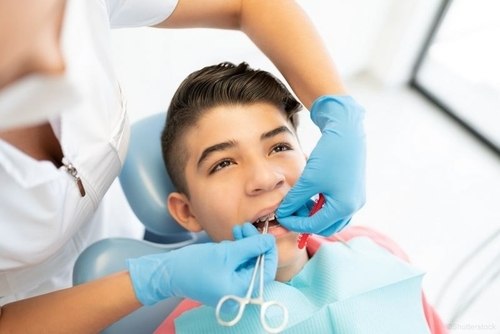
If you have been wanting to straighten your teeth for a healthier, more beautiful smile, you have come to the right place! We love straightening smiles and aligning bites to give our patients the smiles they have always wanted. It is a big investment in your oral health, time, energy, and finances, and we are pleased to take you on this life-changing journey.
But First, Paperwork!
This first visit is all about evaluating your smile and determining what you need to align it. Once that is done, we can explain your treatment options so you can choose the one that fits your goals. It’s important to come in about 20 minutes early so you can fill out the initial forms required for your consultation (our orthodontic new patient forms). Remember to bring your ID and insurance cards with you so we can copy them and keep them on file for your records and insurance provider.
Next Up, Your Initial Examination
Once your paperwork is done, we will take you back and perform a clinical exam to evaluate your smile. We may take dental X-rays and diagnostic photos. We will be happy to answer all your questions and concerns as we walk you through all the necessary steps. After thoroughly checking your face, lips, teeth, and gums, we will also perform a bite test.
These steps will allow our orthodontist to see what will be necessary to straighten your teeth so you can discuss any potential problems and determine the right course of treatment. We will provide you with an estimate of the treatment costs and go over your insurance benefits as well as your financing options and payment plans. Our goal is to help you get the smile you want.
Our orthodontist will talk about your appliances, such as braces, expanders, and retainers. We will also discuss a potential timetable for how long it should take to straighten your teeth and how often you will need to come in and see our orthodontist to monitor and evaluate your progress and make routine adjustments. Your consultation can take anywhere from one to two hours.
Are You Ready? Determining Treatment
If our team determines that we can help you create the smile you want, you may need to see your dentist before having braces installed. They will need to take care of some items before having your braces installed, like having cavities filled, a dental cleaning, etc. (in extreme cases, teeth extracted) before you have your braces placed.
When you come in to get your new braces, we will explain how to take good care of your teeth while wearing your braces. Oral hygiene is always vital to not only a beautiful smile but a healthy one, and especially so in braces. This is no time to skip your routine dental cleanings! We will explain how best to clean around your appliance and the proper dental hygiene practices you should follow daily so that your teeth and gums stay healthy during your orthodontic treatment.
You could say that creating a healthy smile is a team effort, combining your daily at-home care, routine orthodontic visits, and biannual dental cleanings and exams. Together, you can finally have the smile you have always wanted! Give our team a call today to learn more or to schedule your first orthodontic visit!
The Benefits of Wearing Braces as a Child Versus an Adult

Braces worn at any age takes up to two years to straighten on average. Designed to fit your mouth, they are customized to your mouth to place your teeth correctly. During your time in braces, many appointments and adjustments will need to take place. It’s not always comfortable, but it can prevent many issues down the road! Many people feel braces are easier to deal with when you are younger versus as an adult when you are busy working or raising a family.
Different ages react differently to wearing braces, especially when it comes to the psychological and social reactions to being in braces. Kids are often excited about their braces, seeing it as a rite of passage, transitioning from being a child to finally being a teenager. Teens and adults, however, often feel self-conscious wearing braces.
Summertime Is a Great Time for Braces
When it comes to children, getting braces is often best done in the summer because it gives them the leeway to learn how to treat their braces and care for them and adjust to how they feel in the mouth. When first getting braces, the gums and teeth can feel tender, and your child will need to learn how to eat with them and also clean them correctly. Placing your child in braces during the summer is often ideal because of the free time they have to adjust.
Receiving early orthodontic treatment allows our orthodontist to work on their growing smile, preventing more invasive treatments later on and possibly shortening treatment time in braces. Our orthodontist can spot growth or eruption issues to make sure your child has room for their adult teeth to come in properly.
Why Kids Wear Braces
Using orthodontic techniques, we can control where your child’s adult teeth erupt by training the bones to grow into the correct position, fixing issues in the jaw structure, and the facial structures for facial harmony. That’s why it’s important to evaluate their growing smile early so proper treatment can be implemented and timed for the most progress.
Some signs that might indicate that your child could need orthodontic intervention include late or early tooth loss, having misplaced or crowded teeth, or having issues when biting and chewing.
Benefits of Wearing Braces Early
- Better assess how their adult teeth will develop.
- Fix bad habits like thumbsucking or tongue thrusting that can lead to developmental problems.
- Fix bite problems.
- Guide jaw growth for the teeth that will erupt.
- Lower the potential risk of damage to teeth that are protruding.
- Improve how your child’s teeth, lips and face look (potentially increasing their self-esteem).
- Help prevent future invasive dental treatments down the road.
Does Your Child’s Growing Smile Require Orthodontics?
Our orthodontist can assess your child’s growth pattern to see if early treatment is recommended. Early treatment can help with the following tooth and bite conditions:
- Crowding
- Spacing
- Open bites
- Deep bites
- Crossbites
- Missing teeth
- Teeth that don’t erupt in the right order
- Overjets (where excessive protrusion of the upper jaw causes a horizontal overlap of the front teeth)
- Ankylosed teeth (where a tooth’s roots fuse to the underlying bone, so it doesn’t erupt properly)
Our Orthodontic Team Is Here for Your Child’s Smile
Early orthodontic treatment can help prevent bad habits like poor oral hygiene as you have to clean your teeth more often and more carefully in braces. Establishing good brushing and flossing habits in childhood help avoid dental problems later in life. Braces can also help improve breathing and jaw movement, prevent jaw pain, teeth grinding, and prevent breathing problems. Because the jawbone is not fully developed yet, wearing braces at a young age helps make treatment easier, quicker, and more effective while offering more treatment options.
As you can see, placing your child in braces does more than just boost their self-confidence! There’s no better time than summer to get your child used to braces. It allows them to be more comfortable when school starts up again, so they can focus on the new school year rather than on their new braces! Please give our team a call if you have questions about your child wearing braces.
Celebrate Oral Health Month in June by Keeping Your Braces Cleaner Than Ever Before
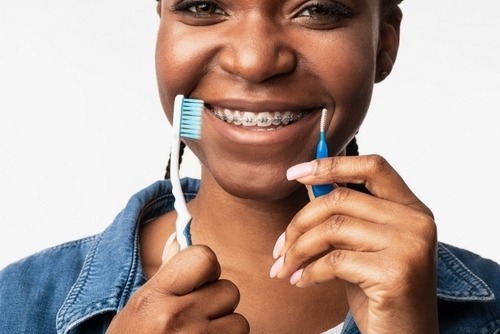
Children, teens and adults alike need to take extra care with their daily oral hygiene when wearing braces to straighten their teeth. In honor of Oral Health Month in June, we have some tips to share for keeping braces clean and your teeth healthy. Whether you are a parent of a child or teen in braces or are an adult undergoing orthodontics to straighten your teeth, healthy habits like brushing and cleaning between teeth are more important than ever to achieve a healthy smile after the braces come off!
Why You Should Clean Your Braces
It often helps to understand why you need to focus extra hard on cleaning your teeth while wearing braces. Oral bacteria don’t take a break when you start orthodontic treatment; in fact, it’s just the opposite! Instead of only hiding between teeth and around the gum line, oral bacteria can now accumulate around orthodontic hardware and grow into thriving colonies of sticky plaque. This biofilm is consumed and processed by oral bacteria and releasing acid. These germs then collect around brackets and bands and harden into tartar that needs to be removed by your dentist.
It is why you need to pay extra close attention to your teeth in braces, so they are healthy when your braces come off. You don’t want to have your braces removed only to find that tooth decay and gum disease are busy damaging your smile. Stepping up your daily at-home oral hygiene will help ensure your smile stays healthy and your teeth stay bright when the braces are removed. Consider protecting your orthodontic investment by investing in oral tools you can use to best clean your braces: a high-quality toothbrush, floss, interdental cleaner and an at-home oral irrigation system.
When to Brush
Brush your teeth after every meal or at least four times a day when wearing braces (after breakfast, lunch, dinner, and before you go to sleep for the night). Granted, brushing your teeth can be tricky when you are away from home. If you can’t brush after a meal, the next best thing is thoroughly rinsing your mouth out with water to get rid of food particles and the sugary or starchy remnants of your meal. Leftover remains can collect around your teeth and leave you with plaque.
Brushing With Braces
No matter how you brush your teeth, using a manual or electric toothbrush, aim for a compact head to reach all the tooth surfaces while you are wearing braces. Many orthodontists recommend using a soft-bristled toothbrush or powered toothbrush to do the job. Be sure to hold your toothbrush at a 45-degree angle on the gum line, gently brushing back and forth and toward the biting surfaces where bacteria and oral debris collect.
Remember to brush for two minutes every time you clean. Now would be a good time to break out your favorite tunes to brush long enough to be thorough! Brush around all the components of the braces hardware as well as every side of each tooth. Pay extra attention around the gum line, and don’t forget the tongue and roof of your mouth.
Since brushing your teeth four times a day around metal or ceramic hardware can make your toothbrush wear out sooner, replace your toothbrush more often (every three to four months). A good rule of thumb is to replace your toothbrush (or toothbrush head) when the bristles begin to fray.
Flossing With Braces
Flossing can be tricky to do when dealing with braces hardware, but it’s more important than ever. Floss at least once a day to get rid of oral debris stuck between teeth. To make this job easier, many people have found that using a water flosser (or oral irrigator) can make this task pleasant and effective. Just be sure to be thorough and floss at least once a day.
Did You Know?
Avoid or limit sugary and starchy foods to keep your teeth healthy while wearing braces, but snacking on cheese is one tooth-friendly food you can enjoy without worry. It protects the pH balance in your mouth by lowering the oral acids that cause tooth decay.
Practice daily oral hygiene habits that will last while wearing braces and after you take them off!
Fix Your Child’s Bad Bite and Relieve Their TMJ With the Help of Orthodontics
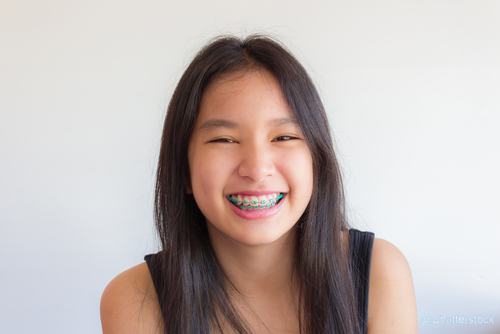
With school out early for the year, now may be a good time for your child to be evaluated for braces. Braces are often recommended to improve one’s smile (or orofacial appearance) by correcting crooked or crowded teeth. Braces can also fix problems with the bite, including overbites, underbites, incorrect jaw position and disorders of the jaw joints.
When Your Child Might Need Orthodontic Treatment
Your child may have straight front teeth and still have malocclusion like a “deep bite” or overbite, causing problems when they chew, speak or sleep. While orthodontic treatment is typically done between the ages of 9 and 14 years, an earlier diagnosis of future malocclusion can also be determined from age 7 to 8. Early treatment can prevent the removal of permanent teeth down the road and guide your child’s skeletal growth to prevent additional problems.
Deep Bite
Orthodontics can be done to open your child’s bite and level the lower arch. When the mouth is closed and the top front teeth greatly overlap the bottom front teeth, your child has what we call a deep bite. This is often seen when the lower jaw is small, or short. This is problematic if the bottom teeth keep growing and eventually touch the back of the upper teeth on the roof of the mouth. A deep bite can also arise if a lower tooth is missing and when the biting muscles are too powerful.
Deep bites should be fixed not only to improve your child’s appearance but to avoid erosion of the lower front teeth and potential loss of the tooth’s structure from thinning and chipping of the enamel surfaces. Your child might also experience painful mouth sores if they are biting into the roof of their mouth, causing them pain when they try to eat. A growing child needs proper nourishment provided by eating a healthy diet, and that can be thwarted if it hurts to eat.
If excessive loss of the tooth structure occurs, your child’s bite will need to be opened by moving apart the top and bottom teeth through orthodontics. This creates room for the crowded teeth to align. Your orthodontist may move the upper or lower front teeth into the bone supporting the teeth. The teeth to the back and the side of the mouth can also be extended to open the bite.
TMJ Disorder and Orthodontics
TMJ/TMD arises when the temporomandibular joint joining the lower jaw (mandible) to the upper jaw near the temporal bone is misaligned. This causes the upper and lower teeth where the teeth meet to exert undue pressure on the temporomandibular joint. Orthodontic treatment can be used to realign the joint to lessen or relieve symptoms. TMJ is often the result of bite problems, stress and habitual teeth grinding and clenching. Wearing braces can correct TMJ disorder if your child’s TMJ results from misalignment or bite problems. Braces apply constant pressure to gradually shift teeth into their desired positions using advanced technology with archwires, brackets and rubber bands that keep braces in place. As the teeth are moved back into their proper positions, the TMJ also moves back into the proper alignment to relieve the symptoms of TMJ and prevent abnormal wear and tear on the teeth.
An orthodontist can assess your child’s smile by evaluating the position of their teeth and the size of their jaw to devise effective treatment for optimal oral development. We invite you to give our team a call today if you have any questions or concerns about your child’s bite!
Exploring the Best Tools to Use at Home to Clean Your Teeth in Braces
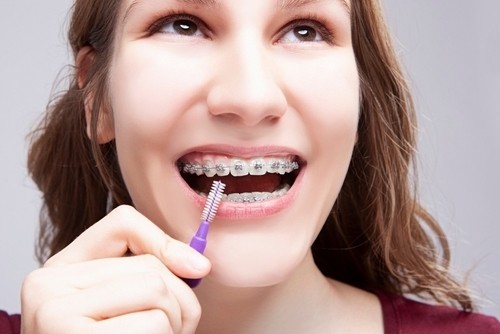
Straightening your teeth for a healthy, properly aligned and beautiful smile takes time and effort and is worth every second! So is taking good care of your teeth along the way so that when the braces come off, your teeth are as healthy as they were when you began!
This means stepping up your oral hygiene game as you brush at least twice a day and floss at least once daily. You want to remove bacterial plaque and trapped food particles from your teeth, brackets, ligatures, archwires and metal bands. These tasks take just a little time and aren’t hard to do, so it is really just a matter of making it happen. Like the Nike slogan says, “Just do it!”
To help you take the best care of your smile while wearing braces, we have some tips to help make your job easy and fun.
Cleaning Tools for Braces
On the Run
If you eat while you’re away from home, it’s important to clean your teeth afterward as you still want to brush after each meal. Keep a travel-sized soft toothbrush and toothpaste in a handy plastic zip bag tucked into your backpack, pocket, or purse. If for some reason you just can’t brush your pearly whites away from home, keep a small bottle of mouthwash on hand or some kind of flossing tool and do the best you can. Every little bit helps!
Flossing
People sometimes take flossing less seriously than brushing but remember, flossing cleans those areas your toothbrush can’t. To achieve sparkling clean teeth means supplementing your tooth brushing efforts with a good flossing tool that can reach those areas like the molars in the back of your mouth. Find a flossing tool you like using, and then use it daily to discourage plaque. The toothy areas under the archwires won’t clean themselves, so floss daily, and your teeth will thank you!
You have a variety of flossing options to choose from:
– Floss Threaders:
- These are easy to use with a loop, strand of floss and a stiff point you can stick between teeth around the gumline. They are handy for reaching beneath the archwire of the braces to remove food particles.
– Dental Picks:
- These look a lot like toothpicks and do an excellent job of loosening oral debris under and around your braces.
– Superfloss:
- A pre-cut strand of floss with a plastic threader and a spongy part to clean wider spaces along with regular floss for more narrow areas.
– Soft-Picks:
- Interproximal flossers with a tapered section to reach adjoining spaces between teeth and your orthodontic appliance parts.
– Water flossers:
- These hi-tech flossing methods stream a pressurized jet of water between your teeth to flush out oral debris with the added benefit of massaging your gums.
Brushing
– Powered Toothbrush With an Ortho Brush Head:
- You want your toothbrush to clean the cracks and crevices around your braces. Nothing does this better than a powered toothbrush with an ortho brush head. Thanks to their oscillating movement they are gentle on the gum line while cleaning wires and brackets and also massaging your gums.
– Proxy or Interproximal Brush:
- These resemble tiny pipe cleaners that slide between the braces and teeth to get rid of any trapped food bits and sticky plaque.
Braces Wax
While braces wax isn’t a cleaning tool, it is something you will likely want in your oral care arsenal to protect your teeth and gums from being damaged by brackets or loose wires. This virtually invisible wax covers metal parts, so they don’t irritate your soft oral tissues or teeth.
Keeping your smile healthy while wearing braces doesn’t have to be hard, and with the right tools you can use at home, it can even be fun! Let us know if you have any questions about your braces, we’re here to make your time in braces as enjoyable as possible.
Wearing Braces Can Help Relieve Jaw Pain From a Misaligned Bite

Braces provide orthodontists the tool to help fix teeth and jaw alignment. These can occur due to a bad bite (overbite, underbite, crossbite, or just crowding in the mouth). Abnormal bite patterns may become noticeable in children when they are anywhere from six to 12 years old, and for them, orthodontic treatment can be done from age eight to 14 years. While correcting tooth and bite alignment is most effective when a person is young, it can also take place at any age throughout adulthood with excellent results.
Orthodontics
Wearing traditional metal braces realigns crooked teeth through the use of pressure, which is applied using the braces hardware. Crooked teeth and malocclusion can be corrected using anchored metal brackets on the molars, and then those brackets are threaded with wires. The metal brackets, which are cemented to your teeth, are connected by the wire and are then tightened during routine appointments. It gradually shifts and straightens crooked or crowded teeth and aligns your jaw.
Misaligned Bite and Jaw Pain
Orthodontics can also be done if the teeth are straight, but the jaws aren’t coming together as they should, which can occur for a variety of reasons, including:
– Genetics
– Injury or trauma
– Thumbsucking
– Tooth loss occurring early or late
Jaw pain can sometimes result from the routine tightening of your braces when you go in for your orthodontic appointments as tension is created in the jaw, placing pressure on the mouth and facial areas. However, as the teeth shift, the body sees it as a kind of inflammation and sends blood cells over to help by releasing healing proteins.
To prevent damage to the braces hardware, you’ll want to avoid hard foods, including candy, ice cubes, nuts, or food you have to bite into, like corn that is still on the cob. You want to avoid breaking the wires of your braces to ensure that your scheduled progress stays on track.
In other cases, braces can help relieve pain if you already have jaw pain from temporomandibular joint disorder (TMD) arising because of bruxism (this is where you grind and clench your teeth together). Aligning the teeth can help your temporomandibular joint move back into the correct alignment, which in turn can lower or even get rid of chronic jaw pain. A properly aligned bite can also help you avoid teeth clenching and grinding while you are sleeping.
Better Oral Health
While most people want to straighten their teeth with braces to achieve a more attractive smile, it’s more important than just improving your appearance alone. With the help of orthodontics to correct alignment and straighten teeth, your mouth will also be healthier! That’s because straight teeth are more accessible to brush and floss, helping you avoid tooth decay, gum disease, and tooth loss. It also prevents enamel erosion from wearing down your teeth because of a misaligned bite. You can also speak and chew again without restriction or jaw pain.
If you want to learn more about wearing braces to straighten teeth or correct a misaligned bite, we invite you to reach out to our experienced orthodontic team for a consultation. We are here to help you create a healthy smile that leaves you feeling confident and pain-free!
Wearing Braces? What You Can Look Forward to During Your Routine Adjustments

Congratulations on deciding to wear braces this year! You can expect to wear your braces anywhere from 1-3 years depending on your growth, how complex the problem is, and of course, how well you care for your braces with your daily oral hygiene routine.
Your Specific Treatment Plan
Modern methods of straightening the teeth make wearing braces easier than ever. Once you get your braces installed, your mouth will adapt to the braces hardware and the little rubber bands that attach the archwires onto your brackets.
In between adjustments, your teeth need time to settle into their new position. Staying on schedule is necessary because if you delay your routine adjustments or skip any of them, you could end up taking longer to accomplish your treatment plan.
Wires, Brackets and Ligatures
Today’s wires are flexible, and they go back to their original shape, so when you wear them, they apply constant, gentle pressure on your teeth. Over time, this pressure lessens as the elastic ties stretch. That’s why you need to have your routine adjustments to replace these ligatures (the stretched out rubber bands and elastic ties). This visit then reapplies the necessary pressure to allow your teeth to continue moving steadily into their desired position as determined by your treatment plan.
Every appointment you attend for adjustments will allow our orthodontist to evaluate your progress and your teeth. According to the biological movement of teeth (the way they move), it takes at least three weeks for the teeth to shift into position, so your appointments are usually scheduled within a range of 3-8 weeks. You can count on spending around 20 minutes or so in the chair having this done.
What to Expect During Routine Adjustments
– Taking off the ligatures that hold the wires onto your brackets (which are attached directly onto your teeth)
– Removing the archwires
– Letting you brush and floss while the wires are off to make sure that you are properly caring for your teeth
– Evaluating your teeth and their movement. We need to make sure that your teeth are moving in the necessary direction at the proper rate and angle so you can accomplish your goals in a timely way
– Adding any new wires, elastic bands or chains
Treating Tenderness
You can expect to feel some tightness of your teeth during and after your appointment. Taking over-the-counter (OTC) pain relievers and applying an oral anesthetic or ice pack can help with any tenderness. Sticking to soft foods also minimizes discomfort. Soft foods that are gentle on your teeth include yogurt, smoothies, oatmeal, soup, mashed potatoes, macaroni and cheese, cooked vegetables, fish, and scrambled eggs.
If you have areas in the mouth where the wires or brackets are irritating the insides of your cheeks, a bit of orthodontic wax covering those spots should do the trick. Rinsing with a saltwater solution can also help with sore areas.
We are excited to help you create the straightened smile you have been waiting for forever. Be sure to keep all routine adjustment appointments and in-between visits, take good care of your pearly whites. Before you know it, your braces will come off, and you will have reached your smile goals!
Dental Emergencies: How to Care for Your Teeth When Wearing Braces and Participating in Winter Sports

Whether you live in an area that gets snow and ice, or you travel to vacation spots to engage in winter sports, you need to be mindful of oral injuries, particularly when you are wearing braces! It’s always important to wear a mouth guard when engaging in potentially hazardous sports like basketball, lacrosse or football as they often lead to oral injuries. It’s just as important when you are skiing, snowboarding or playing hockey as orthodontic emergencies tend to crop up more frequently during these activities.
Oral injuries can be serious and perhaps more so when you are wearing braces. With extra hardware in your mouth, they can damage oral tissues during sudden contact. Of course, there are times when your braces can also protect your teeth from being knocked out during an oral injury as the braces and wires fortify your teeth, providing extra stability.
The good news is, there are typically few true orthodontic emergencies! That said, you’re going to want to seek care should you sustain an injury.
When to Seek Care for Dental Emergencies
– Sudden injury or trauma to the face, mouth or teeth
– Experiencing swelling or infection on the face, mouth or gums
– Severe, unmanageable pain in the mouth, teeth or face
An emergency room visit may be your best bet if you’re looking for immediate treatment for severe pain and injury. To treat tooth damage and oral injury, a trip to the dentist may be required. When it comes to your braces, you can give our team a call to see when we can get you in to make adjustments and fixes. You want to address the immediate cause of your pain, swelling or injury, and then see our orthodontist.
Emergency Orthodontic Treatment
If your braces are hurting you can do the following:
Fix a Loose Wire, Bracket or Band: Press the loose wire gently backward using a spoon, tweezer or cotton swab. You can carefully cut the wire with clean scissors or clippers if you can’t push it back beneath the archwire. You can also place a small ball of wax over the wire until you can be seen by our orthodontist. Wax pressed against a loose bracket can also keep it from wiggling around.
Fix a Loose Expander Appliance: If you are wearing a rapid maxillary expander to widen your upper jaw and teeth, you will need to call our orthodontist if it comes loose or falls out, and follow our recommendations.
For a Lost or Broken Retainer: Unless you have been out of braces for a long while and your teeth are in a relatively stable position, you’ll want to see our orthodontist for a replacement retainer.
Swallowing Braces and Appliances: Although this doesn’t happen a lot, if your braces or appliance come loose from a tooth, contact our office right away. While braces and rubber bands are small enough that they shouldn’t harm you if you do swallow them, you’ll still want to get them replaced as soon as possible.
Orthodontic emergencies are fairly rare, but our team wants to make your treatment as smooth and comfortable as possible! Wear a protective mouth guard whenever you are engaging in sports, whether you are on the slopes, hitting a hockey puck, or playing basketball. If you have any questions or concerns, feel free to contact our office for help and whenever you come in for adjustments and routine appointments. This winter, keep your smile safe while aligning your teeth for a healthy, beautiful smile!
Today’s Modern Orthodontic Marvels Give You More Options For a Better Smile

With the new year around the corner, why not consider taking the next step to create a more beautiful smile? Orthodontics was initially a treatment that folks considered to be limited to children and teens, but today it is increasingly popular with adults. No matter what your age, orthodontic treatments can transform your smile by straightening your teeth and aligning your bite!
According to The American Association of Orthodontists, braces weren’t always the modern marvels they are today. In fact, they originally used crude devices to straighten crooked teeth, close gaps and correct bite problems.
Then: A Blast From the Past
– When the ancient Greeks used braces, they used gold wires. And it wasn’t just the Greeks; ancient Romans also laid to rest their dead with crude dental appliances.
– Egyptian mummies reveal that back in the day they straightened crooked teeth with bands made of catgut (you guessed it, animal intestines!).
– In the 18th Century, thanks to a resourceful Frenchman, Pierre Fauchard, a “bandeau” was created to straighten teeth, made of metal attached to gold wires and shaped like a horseshoe.
– The early 1900s found dentists using a variety of materials to straighten their pearly whites; platinum, gold, silver, copper, steel, brass, rubber, ivory and wood. You also saw the development of bands, wires, loops, clasps, spurs, ligatures and hooks to fix the teeth.
– In the 1970s, you started seeing modern braces taking hold of the orthodontic industry. No more bulky wires and headgear! Instead, a dental adhesive was used to directly bond or glue brackets made of stainless steel to the teeth. This period in history also saw the usage of lingual braces where the hardware was attached to the back of the teeth instead of prominently in front as had been the custom. Also, tooth-colored brackets were being used now.
Today: Modern Advances in Orthodontics and Bite Correction
– The 1990s in the U.S. found dentists focusing on bite corrections and developing malocclusion classification systems.
– The early 2000s, dentists used a discrete form of orthodontics called clear aligners. Not only were these “braces” virtually invisible, but they were removable, too. This meant you could eat and drink all your favorite foods, and you could brush and floss your teeth without maneuvering around orthodontic hardware. No more wires or food particles getting stuck in brackets!
Today’s Invisible Braces
– When it comes to orthodontics for today’s patients, orthodontic systems that use clear plastic aligners to straighten teeth have become a treatment of choice, and with good reason.
– Other discreet options include ceramic braces, which use tooth-colored brackets that blend in more naturally into your smile.
– Archwires have also evolved from using stainless steel to nickel- or copper-titanium versions. These are temperature-sensitive, so they shift the teeth using your natural body heat.
– Lingual braces work their teeth straightening magic while worn on the back instead of the front of your teeth.
We don’t know about you but seeing how orthodontic treatment has evolved over the centuries has helped us appreciate the modern options available today! If you are ready to tackle your teeth and bite issues, we welcome you to reach out to our skilled and experienced team to schedule a complimentary consultation.
With the various orthodontic treatment options available to you, you no longer have to be embarrassed about your smile. Let us help you start out the New Year by creating a straighter, more beautiful smile!
Taking Care of Your Retainer and Your Aligned Smile

Once the hard work of straightening your teeth is completed, the next phase of your orthodontic treatment begins: keeping your teeth aligned with a retainer! You don’t want any setbacks after taking the time to get them straightened. This means wearing your retainer as prescribed by our orthodontist. It will allow bone tissue to rebuild around the teeth and keep the teeth from shifting when you bite, chew, swallow and speak.
Whether your removable retainer is made of acrylic or clear plastic, it will need care and protection. That is if you want to keep your teeth in the aligned position your orthodontic journey left them. If you have a fixed retainer, this is typically a metal wire bonded to the back of your front teeth that never comes off. A Hawley retainer is molded to fit in the roof of the mouth with a wire that holds the retainer in place on the front of the teeth. You will be wearing your retainer at night while you sleep and need to keep it clean when it’s not in your mouth.
Retainer Care
Wear It
This simple step can’t be overemphasized. Wearing your retainer is the only thing that will keep your teeth from shifting back into their pre-treatment, unaligned position. Whether you need to wear it all day or just at night, be sure you follow our orthodontist’s instructions.
Keep It Clean
It’s not just your pearly whites that need cleaning; your retainer needs to be germ- and bacteria-free! You can brush it with your soft-bristled toothbrush when you brush and floss your teeth. Cleaning solutions to rinse or soak the retainer can be done using a denture-cleaning tablet. If you have any questions, check with our team for specifics.
Take It Out Before Eating
You will need to wear your removable retainer as prescribed, except when you eat. Retainers are not made for chewing (unless they are permanent). This allows you to eat your favorite foods without harming the appliance and keep oral debris from hiding behind your retainer and getting stuck there.
Protect It
Keep your removable retainer in its container when it’s not in your mouth. You don’t want to lose it (that’s expensive), nor do you want to accidentally throw it away after eating out, or putting it someplace where it will pick up germs and bacteria, like letting your dog chew it.
Avoid Heat
Because of the material, an acrylic or plastic retainer can be warped or damaged by high heat. That means cleaning it with warm – not hot – water. Do not clean it in boiling water, the dishwasher, microwave, washing machine, dryer, or leave it in the car on a hot day.
Wear a Sports Guard
Don’t wear your retainer when you’re playing contact or high impact sports. Wear a sports guard to protect your teeth and oral tissues. Just be sure to put your retainer back on after playing.
Bottom line: always wear your retainer and take good care of it, and it will take good care of you! If you have any problems with your retainer, let our orthodontic team know right away. It shouldn’t be loose or tight but should fit just right. Whenever you come in for follow-up visits, bring it with you to be checked. Enjoy your beautifully aligned smile!
Orthodontics Awareness Month: How Orthodontic Treatment Can Help You

October brings visions of ghosts, ghouls and goblins for children, but for adults, it is also National Orthodontic Health Month. Orthodontists around the country (including us) like to celebrate this time by spreading awareness about the benefits of straight teeth and an aligned bite.
Orthodontic Fun Facts
– There are about four million people wearing an orthodontic appliance in the U.S. and 25% of which are adults, often in their 50s, 60s and 70s.
– NASA created the wires used for braces (using nickel titanium for the space program) which are thin, elastic and flexible which use body heat to maintain their shape on the teeth.
– Braces have been around for almost 300 years since they were designed by Pierre Fauchard (the Father of Dentistry) in 1728 using flat metal material connected by a thread to the teeth. Later, the dentist Edward Angle developed more advanced and modern orthodontic hardware including brackets to straighten teeth and correct misaligned bites.
– According to archaeologists who studied mummies, ancient Egyptians tried to straighten their teeth using cords from animal intestines to simulate wires (gross, right?).
– Orthodontic appliances like braces straighten teeth, but retainers keep them aligned after the appliance comes off. Not wearing the retainer post treatment often means having to have orthodontic treatment again.
Today’s Treatment Options
Crooked teeth that don’t fit together like they should are harder to clean, making them more vulnerable to tooth decay and gum disease. People straighten their teeth for a variety of reasons, mainly for aesthetics (who doesn’t appreciate an aligned smile?) but also for correcting a misaligned bite like an overbite. This is important, because an aligned bite makes it easier to bite, chew and speak. For decades this meant wearing traditional braces but today’s orthodontic patients have more choices!
– Traditional metal braces: These use wires, brackets and rubber bands on the front of teeth to correct misalignment.
– Clear braces: These are like traditional braces only using clear ceramic brackets to straighten teeth.
– Lingual braces: These braces have the hardware (brackets and wires) attached onto the back of teeth instead of the front.
– Clear aligners: Typically plastic trays such as Invisalign® or ClearCorrect™ worn over teeth to shift gradually them into the desired position.
Not Just a Pretty Smile
Straight teeth have benefits beyond your oral health. When you have an attractive smile you will feel good about it, boosting your self-esteem which is good for your psychological health!
Aligned teeth also allow you to bite and chew food properly which helps prevent digestive issues. Other health benefits from aligned teeth include pain relief from headaches, bruxism (habitual teeth grinding) and jaw problems like TMJ.
Chronic teeth grinding and jaw clenching also interrupt a good night’s sleep and can worsen sleep apnea symptoms. Even sinus problems can be alleviated using orthodontics to help open up constricted airways. As you can see, orthodontics goes way beyond just a pretty smile!
Creating awareness for National Orthodontic Health Month is important because orthodontic treatment can give you a healthier mouth and body while preventing health problems from developing. To learn more about how orthodontic treatment can help you we invite you to give our team a call today!
Keep Your Teeth and Braces Safe With the Foods You Eat

When you are wearing braces, nothing feels quite as important as what kinds of food you can eat. The wrong food can damage your braces or stain your teeth, particularly berries, curry sauce or grape juice. Protecting your new bands, archwires and brackets along with your teeth and gums quickly rise to the top of your priority list!
Your teeth are vulnerable when you eat a lot of sugary and starchy foods because they produce plaque acid that leads to tooth decay and gum disease. Your braces make it easier to trap food particles between them and your teeth, so it goes without saying (but we’re going to say it anyway) that brushing and flossing are more important than ever in braces! Cavities are bad enough, but plaque and tartar can also leave your teeth with unsightly stains on areas that were not covered by braces.
Foods to Avoid
Sticky foods easily collect onto your braces and are nearly impossible to get out. Caramel, jelly beans, licorice, taffy, toffee and other sticky, hard candies can break off brackets. Gummy candy can bend your archwires and become trapped under the braces attachments. Chewing gum can get trapped in between all of your wires and is almost impossible to get off.
There are other foods so hard they can break your brackets and wires; toffee bits can break brackets and bands, and fibrous meat from the bone like chicken wings and ribs can even pop off a bracket. Beef jerky, pizza crust, chunky nuts and seeds, and raw vegetables (carrots, broccoli and cauliflower) require a strong biting force, which can ultimately harm braces. Steam or cook your veggies, and if you’re eating hard crusty bread like bagels, soften it with a soup or sauce and cut into bite-sized pieces.
There is also a small list of inedibles that can damage braces, so keep them away from your teeth! Ice is the most common reason braces components sustain damage, so don’t chew it. Even chewing absentmindedly on pens and pencils, paper clips (yikes!), and biting your fingernails can cause damage to braces. The main goal is to keep your braces and smile safe, align your teeth and not prolong your time wearing them.
Foods to Eat
Eat a balanced diet so that your teeth are healthy and strong when your braces come off and get your daily requirements of protein, calcium, vitamins, iron and fiber. Soft textured foods are always good for your braces, particularly right after your braces are tightened.
– Soft fruit: ripe pears, nectarines, tangerines, kiwis, blueberries, blackberries, raspberries, applesauce, and fruit that is diced and chewed with the molars
– Vegetables: steamed or cooked vegetables keep your smile healthy
– Dairy: low-fat milk, yogurt, smoothies, and soft cheeses feel good in your mouth
– Eggs: scrambled, hard-boiled, sunny-side up or made into omelets are “eggs-cellent” choices
– Meat: tender choices like meatloaf, fish, chicken, and turkey or tofu are healthy and safe
– Grains: soft-textured grains like pasta, rice or quinoa are good for you
– Soft bread: muffins, pancakes, tortillas, and biscuits are gentle on your chompers
If your braces-friendly foods seem bland or boring, mix things up a bit and find recipes that will help keep your taste buds and your teeth happy. Be mindful with the holidays coming up as many traditional favorites (candied apples, peanut brittle and candy canes) are bad for your teeth and braces! Give our orthodontic team a call if you have any questions.
Head Back to School With the Right Tools!

It is that time of year again where your children are headed back to school with their new backpacks, notepads and pencils! If they have braces, they will need some extra items in their backpack and locker. Our team wants to make sure your children are equipped with the tools they need to have a healthy and strong smile, so it’s important they have them available when they’re away from home.
Orthodontic Tools
Here is a list of cleaning and protection tools your child with braces will want to keep on hand:
– Individual case: This is for orthodontic tools and keeps them clean from other objects in their backpack or locker.
– Toothbrush: Purchase an extra one so there is no need to worry about losing the one from home.
– Toothpaste: Pick a travel-sized tube in case their backpack gets squished.
– Floss: This is an important tool for removing debris between the teeth and gums.
– Flossing threads: With a full set of metal braces, it is sometimes difficult to get between metal wires and teeth. This tool helps floss underneath braces and between the teeth to clean the gums.
– Interdental cleaning brush: Metal braces can get food stuck underneath the wires and corners of brackets, so this tool brushes between nooks and crannies to remove debris.
– Extra elastic or rubber bands: If needed, these help align the bite. Keep extra at the ready when it’s time to replace dirty or broken elastics.
– Rubber band hook: This assists in hooking rubber bands to braces.
– Wax: If your child’s gums and oral tissues need protection from sharp edges, broken wires or brackets, then wax can cover those spots on their braces. They can even help prevent extensive mouth sores.
– Mouthwash: As an added defense against bacteria, this is a quick way to kill bacteria while your child is busy in school. We recommend a travel-sized bottle.
– Chapstick: Sometimes newly applied braces or new elastics can cause chapped or irritated lips.
– Pain relievers: In case your child’s teeth and gums get sore, a pain reliever can help alleviate the pain or discomfort.
– Orthodontist information: For emergency care, have our information on hand in case of an emergency.
– Pocket mirror: Sometimes a mirror is needed to clean out food debris and put in rubber bands, so a small compact mirror can be handy.
– Mouthguard: If your child is active in sports or other physical activities, we strongly recommend purchasing a mouthguard to protect their teeth and gums. This is a safeguard against impact and deep cuts in their mouth.
By having these items on hand, you can help your child have a great orthodontic experience as school begins. A few other tips we have for your child wearing braces include eating soft foods, avoiding sticky and hard foods with high amounts of sugar, brushing and flossing each day, and seeing our team regularly.
Give us a call today if you have questions on what to store in your child’s backpack and how they can take extra preventative steps in their orthodontic care today. We are always happy to help!
Problems That Can Arise From a Misaligned Bite

Did you know there is a lesser-known cause for headaches that can be attributed to malocclusion? Malocclusion occurs when the jaws and teeth are misaligned due to abnormal positioning of the teeth when the jaws close. This can cause an overbite, underbite, crossbite or teeth crowding. While people often try to get their malocclusion treated for cosmetic reasons, it’s important to correct the issue for medical reasons as well if you want the teeth to function and last for years to come.
Why Fix Malocclusion
Unless the malocclusion is severe, orthodontics can readily correct these issues. If a child has a malocclusion, a combination of orthodontics and orthognathic surgery may be needed. If a child’s malocclusion has more to do with the jaws being off and they are still young, an orthopedic headgear can often correct the problem.
Straightened teeth help prevent tooth decay and gum disease since they are easier to clean, making brushing and flossing a breeze. An aligned bite also deters speech issues so you can speak and chew normally. It is vital so your body can break down and absorb the necessary nutrients from your diet.
Correct teeth alignment also keeps the wear and tear on the teeth and TMJ discomfort to a minimum. Conversely, untreated malocclusion strains the jaw and jaw muscles, resulting in tenderness, jaw and neck pain, and of course, headaches.
– Overcrowding happens when teeth are overcrowded, creating crooked or overlapping teeth.
– Gapped teeth or diastema occurs when teeth don’t fill up the available space between teeth or teeth that are lost.
– Overjet arises when the top teeth extend too far over the bottom teeth, interfering with normal speaking and eating.
– Overbite is when the increased pressure allows the front teeth to go more forward and bite down on the gums.
– Crossbite happens when the upper teeth bite inside the lower teeth and damage front or back teeth.
– Underbite arises when the lower teeth extend outward farther than the upper front teeth.
– Open bite occurs when the upper and lower front teeth don’t come together when the mouth is closed, leaving a gap or opening between the rows of teeth when the mouth is closed.
How Braces Help
Retainers and braces worn over teeth can help realign them into their proper position and keep the teeth and jaw in their ideal place. A retainer may be worn for years or even for life to maintain this aligned position.
Clear aligner treatment can effectively treat class 1 malocclusion and some underbites and overbites, while braces can fix big gaps and crooked teeth as well as underbites and overbites. Braces are especially helpful for children and teenagers since malocclusion most often impacts these ages. Baby teeth may need to be removed to make room for the eruption of the permanent teeth. Then braces can correct the jaw problems and misaligned teeth through gentle pressure applied on the teeth and followed up with a retainer to keep teeth in position.
If you have problems with your bite and find yourself with a persistent headache, we welcome you to call us today to schedule a consultation with our orthodontist for an evaluation. We look forward to helping you achieve the healthy bite and aligned teeth you deserve!
Traditional Braces for Your Teeth
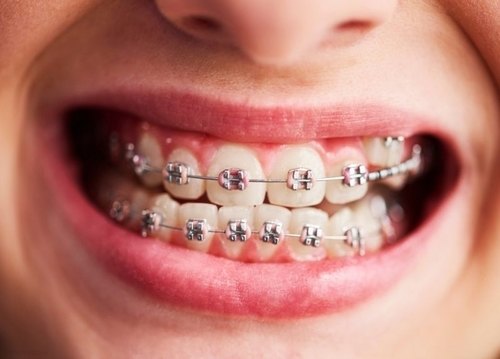
Traditional braces have come a long way when it comes to straightening crooked teeth. In fact, they are ideal for a variety of tooth issues, not just crooked teeth. They can effectively close gaps for crowded or overlapping teeth, fix misaligned or protruding teeth, align a bad bite, and match up dental midlines to overcome jaw problems.
For those struggling with any of these issues, traditional braces can help you eat, speak and even clean your teeth better while giving you a straighter smile. And if the idea of wearing traditional braces for straighter teeth doesn’t appeal to you, you might be pleasantly surprised because you could actually love wearing them!
How Have Traditional Braces Evolved?
Like everything else under the sun, modern traditional braces have evolved, thanks to modernized dental technology. Metal bands no longer wind around each tooth. Today, they are only placed on the back of specific teeth and slid into a tube on a band for support.
Today’s braces aren’t just sleeker, smaller and less obtrusive but more comfortable and cost-effective as well. How long these braces are worn depends on your unique needs, but it typically ranges from one to three years after which a retainer is worn to keep them in position.
What Do Braces Look Like Today?
– Modern braces come in durable stainless steel and high-grade titanium. They work with brackets, an archwire and ligature elastic.
– Depending on who manufactures them, the silver-colored brackets come in different shapes and sizes and are bonded to the front of each tooth’s surface.
– The teeth are then connected to each other with a metal archwire that puts pressure on the teeth being aligned to guide them slowly into their corrected position.
– A ligature elastic or metal band can be used to hold the orthodontic wire and braces together, and the wire is what moves the teeth while the bracket is an anchor on each tooth. The wires are changed out or tightened during routine orthodontic checkups to keep up the necessary pressure that aligns the teeth (and even the jaw).
Who Needs Them?
Traditional braces are a great option for all ages: kids, teens and adults. Particularly popular with kids, they are both durable and cost-effective. Kids also adjust to wearing them fairly quickly as the oral tissues toughen up, so they barely notice them. This is all thanks to today’s metal wires and brackets which aren’t as irritating to soft tissues.
Plus, the elastic that fits around the brackets come in fun colors that can be changed out at each appointment. This can give children something to look forward to as they show off their personality, celebrate holidays or display team spirit. For teens and adults who prefer a more subtle appearance, the bands are available in neutral silver, gray and white.
How Do You Maintain Your Braces?
You’ll want to follow the guidelines our orthodontist provides to keep teeth healthy while wearing braces. This means eating approved foods and brushing and flossing faithfully after meals. You want to protect your teeth against damaging plaque buildup around brackets and prevent permanently stained teeth from lack of oral care.
When it comes to orthodontic therapy, today’s traditional braces are an excellent and common choice when seeking to straighten smile issues. Give us a call today if you would like to know more or want to schedule a visit with our skilled orthodontist.
Boost Your Teen’s Confidence This Summer With Braces

Summer is almost here and with it the start of fun recreational activities coupled with a slower pace. For teens today, braces are pretty much a rite of passage. The end result? A straightened smile they can flash proudly! Especially since a smile is one of the first things people notice. Of all the ways we can impress people, a healthy smile says we care about our appearance while exuding confidence. This summer, why not take advantage of the extra recreational time to get your teen’s smile on track?
While wearing braces might seem overwhelming at first, summer is a good time to let our orthodontic team help your teen make this process simple and easy to navigate. The first step is having our orthodontist examine their teeth and bite to determine the extent of work that will be needed for correction. Treatment time varies, and in some cases, extra steps may be taken to ensure proper spacing with orthodontics. We have the tools, tips and experience necessary to make their treatment time as comfortable as possible for beautiful results.
-Breaking in braces: It takes time to break in the orthodontic gear so that your teen can eat and speak with ease again. Summer allows them to do that without keeping up with schoolwork, peer pressure and the extracurricular activities they may normally be engaged in. Summertime gives them leeway to ease into their new oral care habits so that by the time school starts up again they will be comfortable with their orthodontic routine.
-Ease of appointments: Your teen can start wearing braces without having to worry about missing classes or other school year obligations. By the time school starts up again, their orthodontic appointments are slowing down as they adjust to the appliance. In fact, the school year is a busier time for orthodontists, so getting their braces applied in the summer months is the best for both parties timewise.
-Cleaning made easy: Wearing braces involves adjusting their oral hygiene routine. Your teen will learn how to care for their teeth, gums and braces to repel tooth decay and gum disease. Summer’s relaxed schedule allows them to create these new habits and ease into their routine before they get busy with the school year again.
Our skilled team is ready to make your teen’s orthodontic experience a positive one from start to finish. Call us today to schedule a consultation and get ready to boost their confidence for a successful school year!
Benefits of a Better Aligned Smile

Spotting and treating tooth alignment issues early on is very beneficial for your teeth. This allows time to make repairs and align the teeth into their correct position. Your teeth are something you use to eat, smile and communicate with others, so it’s important to take care of them as soon as possible, no matter your age. Whether making them more aesthetically pleasing or for the betterment of your health, we all need to take advantage of orthodontic benefits.
A straighter smile can improve you or your child’s self-confidence as it makes a more attractive smile (helping one feel more self-assured, especially for those navigating through insecure teen years). Along with the aesthetic improvements braces can provide you, studies have shown that a smile with aligned teeth can boost your career in addition to your social status. This is due to people feeling more confident with their smile knowing they have straight teeth.
When it comes to oral hygiene, one of the main benefits of straighter teeth is that they are easier to clean thoroughly. When your teeth are misaligned, this can create crevices where it’s difficult for your toothbrush and floss to clean. It ultimately prevents cavities and gingivitis, which alone is a big deal if you want to keep your natural teeth. Other problems may arise if gingivitis is not taken care of; periodontal disease may occur and even lead to heart disease, stroke or diabetes.
Another issue that may come up is bone and gum erosion. Without proper support, pressure is put on the jawbone and gum tissues. Braces help correct this and move your teeth into a proper place to support themselves, which in turn can help avoid periodontal issues as well as prevent tooth loss.
Another benefit of wearing braces is correcting your speech. As you age, teeth can shift out of their normal alignment due to a condition known as tongue thrust or if you have experienced oral trauma. A few more commonly known reasons are thumbsucking, gaps in the teeth (can cause whistling), an underbite or an overbite. By repositioning the teeth, speech impediments can be corrected, and the pronunciation of words sounds better.
Other advantages to having straight teeth include a lower risk of lip and gum injury as well as better digestion. Better alignment allows you to chew foods correctly. You can also prevent fewer headaches, teeth grinding and TMJ by correcting a bad bite.
Are you interested in benefiting from orthodontic care? Give us a call today to set up a consultation. We’ll be happy to help you get the full benefits of straighter teeth today!
What Are the Risks of DIY Braces?

Ever since YouTube began helping people learn and execute do-it-yourself (DIY) projects with accuracy and success, it’s become tempting to take on more challenging projects to save money. While this strategy works for learning how to crochet or paint your home, straightening your teeth should not be on that list any more than performing surgery or juggling fire.
Whether you are reading articles or watching videos on the Internet all about the DIY braces trend, at-home orthodontics using “equipment” like hair or rubber bands, elastic strings, earring backs, paper clips, glue or 3D printer technology is a dangerous practice. The American Association of Orthodontists (AAO) reports that 39% of their orthodontists who saw patients using DIY braces needed corrective and restorative treatment afterward!
Potential Damage
Whether you want to align your teeth or close a gap between them, DIY braces raise your risk of gum infection as well as damage to the teeth and bone. Moving teeth is a biological process, and if it’s not done properly, a healthy tooth’s root can absorb back into the body and dissolving, causing you to lose the tooth or even multiple teeth.
Without the guidance of a trained orthodontist who understands your oral anatomy, wearing DIY braces allows no control over the pressure levels to shift teeth into position. Your teeth are connected not only to the gums but to the blood supply that makes you vulnerable to infection, particularly if you tear gum tissue that doesn’t heal correctly. This can damage the attachment between them while support is lost. If you’re using a rubber band that slides up and accidentally cuts the attachment, you lose the needed support.
DIY braces can not only cause gum infection and tooth loss but also jaw and bite problems as well as lifelong dental issues. Some folks who have experimented with DIY braces have found themselves experiencing bruxism (grinding and clenching their teeth), shooting pain, and issues with their jaw joints and muscle spasms.
Orthodontic Treatment
Using household items don’t work the same as braces designed for the task. Certified orthodontists use equipment that has passed rigorous testing standards to ensure their safety and effectiveness. Orthodontists complete education, training and hands-on experience, so they can accurately diagnose, supervise and implement the orthodontic process. By understanding how the jaw, mouth and tooth movement works together, they can avoid harm and ensure the teeth remain in place after straightening to prevent relapse.
Evaluation
An orthodontist will evaluate your teeth and gums to determine the alignment process needed to straighten your teeth without harming the gums or bone structure. This typically includes an oral and facial analysis, review of your dental records, taking images (intraoral and facial) and X-rays (panoramic and cephalometric), and taking impressions to create models of your teeth and bite.
Developing a formal treatment plan ensures that the straightening process leaves your mouth in better, not worse, shape when you are done. Replacing damaged/lost teeth is costly and not worth the risk to save some money now. Protecting and investing your healthy smile is as crucial as a healthy heart to your well being.
Visit Us
The good news is you don’t have to risk your health or your smile by doing it yourself. Working with our orthodontist is more cost-effective to fix crooked, crowded teeth and align your bite. This ultimately leaves you with a winning smile and increased self-esteem. With a variety of braces options available from the traditional to the nearly invisible, our skilled orthodontist can safely straighten your teeth and correct your bite for a brilliant smile. Call our office today to learn more!
Consider Water Flossing for Your Dental Flossing Needs

When it comes to caring for your teeth in or out of braces, you already know how important it is to brush twice a day. Cleaning your teeth daily helps get rid of harmful bacteria or plaque in the mouth that can cause gum disease and tooth decay. But brushing alone won’t do the job, because you still need to clean sticky bacterial film and any stray food particles off your teeth and along the gum line that your toothbrush can’t reach. That’s where flossing comes in and not the dancing kind.
Struggling With Dental Floss?
Most people know how to use traditional dental floss but some struggle with it. This can include people who have problems with their hands, such as arthritis, carpal tunnel syndrome or Parkinson’s disease. To clean with dental floss, you need to be able to insert the string between the teeth to get at oral debris, plaque and food particles. It takes some skill to maneuver the floss around the teeth, and you need to have some manual dexterity. The last thing you want to do is avoid flossing because it’s too difficult. If you struggle with flossing, an alternative such as a water flosser might be the right tool to help you floss daily!
ADA-Approved Flossing Alternative
This handheld interdental cleaning device works by emitting a thin jet of water to remove plaque and food particles between your teeth and along the gumline. Waterpik is one of the most well-known brands, and since it carries the American Dental Association (ADA) Seal of Acceptance, it has been proven to be both safe and effective at getting rid of plaque and keeping gingivitis at bay.
To use a water flosser, you simply fill it with water and place it in your mouth, aiming the stream of water between each tooth and around braceware. These are great to use for anyone struggling with gum disease, xerostomia or dry mouth, have difficulty with manual dexterity or are wearing braces.
Backed by Research
If you need more reasons to consider using a water flosser, in a study published in the Journal of Clinical Dentistry, water flossing was determined to be 29 percent more effective than traditional flossing. A different study also published in this journal affirmed that using a manual toothbrush along with a water flosser was better at removing detrimental plaque than using a manual toothbrush and an interdental flossing brush.
Water Flossing for the Win
Waterpik’s own research found that its flosser is 51 percent more effective at lessening gum disease and three times more effective than dental floss when cleaning around braces. This means using a water flosser in addition to your daily tooth brushing is an excellent way to keep your teeth and gums healthy! Your water flosser can effectively clean behind your wires and wash away food fragments that are caught behind the braces.
If you need help flossing while wearing braces, feel free to give our experienced team a call and we can help you find the best tool for your needs. We are here to support your oral care efforts as you straighten your teeth and look forward to helping you achieve the healthy, beautiful smile you deserve!
Early Orthodontic Treatment Benefits Your Child’s Growing Smile

When your child comes in for early orthodontic treatment, it’s usually not just because their teeth are not aligned. Because of this misalignment, this can lead to poor facial development or other health problems. If your child’s developing jaws and face don’t grow correctly, there may be health issues that affect their sleep quality and consequently impact healthy brain and body development.
Tooth eruption is yet another issue, but our orthodontist can monitor and guide your child’s teeth to fix problems early on. This is also why the American Association of Orthodontists® advises that your child has their first orthodontic screening by the age of seven to assess their need for orthodontic treatment. The goal is to begin treatment early to fix issues before they grow into more costly and time-intensive concerns.
Treating your child’s dental issues earlier can help create the room needed for erupting teeth that are crowded, allow space for the teeth which are yet to erupt, lessen the need for tooth extractions and guide their jaw growth for facial symmetry. If your child snores or breathes through the mouth, wakes up frequently, grinds their teeth, wets the bed or has trouble falling asleep, orthodontic treatment can even help with these problems. Other issues that can be resolved with orthodontics are speech impediments, chronic headaches, colds, sore throats or ear infections.
If baby teeth are lost too soon or too late, this may lead to crowding of the permanent teeth. Your child’s smile or bite can also be affected by thumb-sucking. A crossbite can also influence your child’s teeth and lead to gum disease, chronic pain in the jaw, neck and shoulder areas. This can even affect your child’s self-confidence leading to behavioral issues.
Early orthodontic treatment is done in two stages, Phase I and II. This allows your child’s permanent teeth to come in correctly and help prevent extractions down the road. Phase I is generally done around the age of eight or nine, while Phase II is done around age 11 to 15.
Phase I focuses on helping your child learn good oral hygiene habits, resolving dental issues, correcting their bite and jaw development while shifting their permanent teeth into the proper place. The goal of this phase is to start improving your child’s alignment and lessen the risk of dental issues in the future.
In Phase II, braces are employed to guide your child’s permanent teeth into position and stabilize them. Having orthodontic treatment done at this age can prevent the need for braces as an adult (which often involves tooth extraction or oral surgery), so wearing braces as a child prevents this and reduces the length of time they need to wear braces.
If you would like to have your child’s oral development checked, our orthodontist is happy to determine whether treatment is needed and designing a personalized treatment plan for the best results. If you would like to find out more or want to schedule your child’s orthodontic consultation with us, please call or visit us today!
Tips for Caring for Your Teeth and Gums While Wearing Braces

The number one goal for your oral health is maintaining healthy teeth and gums. This means practicing diligent daily oral hygiene habits; specifically, brushing and flossing to remove plaque along with routine dental visits to remove tartar (hardened plaque), polish your teeth and have your gums checked.
When you opt for orthodontics to straighten your teeth, your oral care becomes even more important. In the case of braces, food and bacteria can become trapped easily in the brackets and hardware. To lower the bacteria in the mouth, you can also rinse with mouthwash when you brush and floss every day.
Removing plaque helps prevent cavities, swollen gums, halitosis and permanent stains on your teeth from wearing braces. Ideally, you should brush your teeth after every meal or snack. If you can’t brush, at the very least you can do is rinse with water to wash away particles and bacteria. Also, be sure to floss at least once a day.
What happens if you neglect your hygiene in braces? You can find yourself with gingivitis, the early stage of gum disease. As this is caused by plaque along the gum line, you’ll want to brush those areas and massage your gums gently whenever you brush. If gingivitis isn’t properly treated, the gums can become infected around the bone and ligaments holding your teeth. This can cause gum pockets to form, which harbor even more bacteria and plaque.
But the gums aren’t the only part of your mouth that can be harmed if you don’t take care of your teeth and gums when wearing your braces. You can also end up with white spots around the braces. These are permanent stains from decalcification, and they can’t be removed when the braces are taken off. To avoid these dental issues, take care of your teeth and braces by practicing the following:
- Brush with fluoride toothpaste, and be sure to replace your toothbrush every two months. This is especially important while wearing braces. Usually, it’s every 3-4 months, but the wear from the metal brackets affects the bristles. Be sure to brush after every meal and before bed.
- Floss once a day. There are a variety of flossing tools available for you depending on your needs. The most commonly used flossing tool is waxed floss with a floss threader. Another popular flossing method is an oral irrigator. Water flossers flush out bacteria and food particles around the gums and in the small spaces of the teeth and braces. Find something that works best for you and then use it!
- See your dentist every six months to check for issues and provide you with a professional dental cleaning. Along with keeping all of your scheduled orthodontic appointments, you will be optimizing your oral health while straightening your teeth with braces.
- Rinsing daily with an oral rinse can help prevent decalcification on the teeth (these are white spots on enamel) and also demineralization (this arises from acids left on the teeth that break down enamel). We can also prescribe an oral rinse tailored to your oral condition.
If you would like more information, we invite you to give us a call to find how to take care of your teeth while wearing braces. We want to help you achieve the healthy, straightened smile you deserve!
What Type of Orthodontic Retainer Will You Be Wearing?
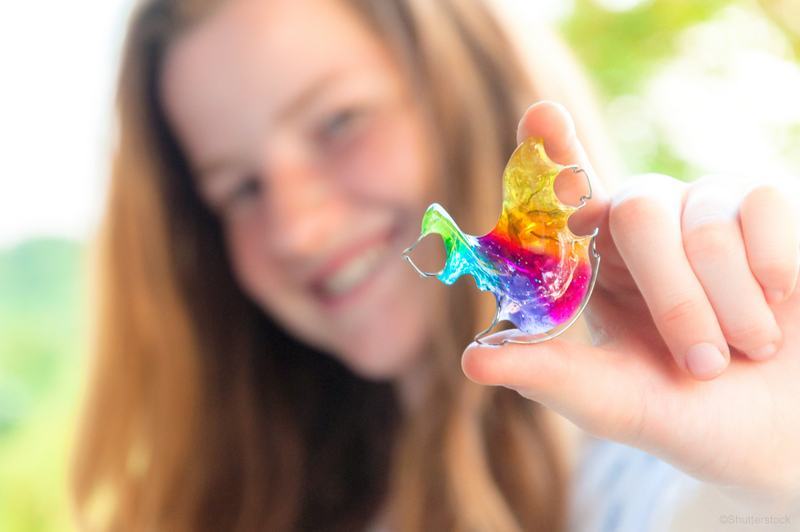
Now that you have undergone orthodontic treatment and your teeth are finally aligned, you will want to make sure they don’t slip back into their previous positions. To prevent this from happening, retainers are used to anchor your teeth into place. Retainers are fashioned to fit your mouth with the correct alignment by taking a mold, or impression of your aligned teeth and gums. The retainer is created in a lab using wire and or/acrylic material (depending on the type of retainer) from your impression.
Fixed Retainers
These are simply a thin wire that is cemented onto the back of the upper or lower front teeth. This permanent bonding replaces the brackets if you wore braces. This permanently placed wire effectively keeps your aligned teeth in place around the clock so you don’t have to worry about keeping your teeth straight.
Removable Retainers
Unlike the fixed wire retainer, these are removable devices that are made of a combination of wire and an acrylic base with hooks or clasps that hold onto your upper teeth to keep them in position. They hold onto the front of the lower or upper teeth in the front of the mouth around the back teeth. Initially, you may wear this retainer every day for at least three months. Once you get the go-ahead, you will eventually need to wear it at night. Removable retainers do have some disadvantages; they can be accidentally tossed in the trash if you are taking them out to eat and you are away from home. If you drink or eat hot items it can warp the acrylic base. This means when you are not wearing your removable retainer you should keep it in an appropriate case and in a safe place.
Retainer Care
Now let’s take a look at how you should care for your retainer to make sure it continues to serve you as it should. When it comes to cleaning your retainer, you’ll want to disinfect it daily to remove oral debris (plaque and food particles).
Cleaning a fixed retainer requires pulling floss that can be inserted into the interproximal spaces between the teeth and rub it up and down and sideways to remove oral debris – similar to how you flossed while in braces.
Cleaning your removable retainer can be done in various ways:
- Brush gently with a soft-bristled toothbrush and a mildly abrasive toothpaste
- Soak in denture cleaning tablets containing antibacterial ingredients
- Rinse with a disinfecting oral rinse
- Soak in vinegar and water to remove bacteria
In addition to taking good care of your teeth and gums by brushing daily and also cleaning your retainer every day, you will want to see your dentist regularly for checkups and cleanings. You want to make sure that cavities are taken care of and your newly aligned teeth cleaned (removing hardened plaque and tartar) and polished. We will also check out your teeth and gums as well as your retainer to make sure everything is working correctly and is in healthy condition.
As you can see, keeping your teeth in their aligned position after your braces come off is just as important as when you straightened them with orthodontics. If you would like to know more, please reach out to our team and we will help you with your orthodontic needs!
Brace Yourself, the Holidays are Coming!

Straightening your teeth with orthodontics can help you achieve a more healthy, aligned and attractive smile. With the upcoming holidays, Halloween, Thanksgiving, the month of December and New Year’s (to name a few), around the corner, your orthodontics treatment won’t take a holiday, so it’s up to you to remember why you are wearing braces. With proper care, you can enjoy all the festivities by following a few helpful tips that can keep your teeth and braces safe to ensure that your treatment time stays on track. Along with seeing our orthodontist for routine appointments, keeping rubber bands, toothpaste, wax and retainer cases on hand is a great way to start the season.
Halloween
This holiday is all about the scary costumes and the candies but you can still keep your braces safe while you celebrate. It’s not just the frightening amounts of sugar that come at you during this time, but the texture and hardness of the treats that can damage braces parts and make them difficult to clean. Avoiding hard, chewy candy, gum and bubble gum, and nuts can help. This means holding off on candied apples, popcorn balls, caramels, taffy and blow pops. Safer sweets include chocolate, soft cookies, muffins, cupcakes, and soft, sliced fruit. Don’t forget to rinse well with water after eating and brush and floss if you can.
Thanksgiving
This warmth-filled holiday is all about comfort food and get-togethers with the people you love and care about. Thankfully, this occasion in braces can still be celebrated much easier than Halloween with its tasty traps. Snacking on soft cheeses, deviled eggs, bite-sized turkey pieces off the bone, creamy mashed potatoes with gravy, sweet potato casserole, your grandmother’s green bean casserole, corn casserole, stuffing, rolls, cranberry sauce and pumpkin pie won’t pose a problem for braces brackets and wires. Forgo the crunchy, nutty toppings and avoid pecan pie or anything with caramel and follow up your scrumptious feast with careful brushing and flossing. Remember, you won’t always be in braces so the day will come when you can indulge in your seasonal favorites again.
Winter Holidays & New Year
Decorating your home, giving and receiving gifts, attending parties and downing eggnog, hot chocolate and champagne with friends, family, and co-workers, can all still be done with mindful care to protect teeth and braces. You want to make sure you don’t damage parts or invite cavities and tooth discoloration around the brackets. You are wise to skip the candy canes, peanut brittle, fudge and chewy candies. Festive alternatives include fresh seasonal fruits – kiwis, oranges, clementines, grapefruit and tangerines, which are rich in vitamin C that can help you fight gum disease and seasonal colds. Soft-cooked vegetable offerings are safe, as are soft cheeses like brie and cheese balls (without nuts), soft cookies, bread puddings, cakes, muffins, and soft fruits like jarred fruits, fresh berries and seedless grapes.
Caring for your Braces During the Holidays
No matter what the holiday, be sure to remain diligent when it comes to your daily oral hygiene because neglecting it can set your treatment time back. Brush after each meal, using a toothbrush (or interdental toothbrush) and fluoride toothpaste. Floss at least twice a day, or after meals whenever possible. Floss threaders can make cleaning between teeth, brackets, and wires easier, and many patients find using an oral irrigator easy and effective. Don’t forget to bring your oral hygiene necessities if you are traveling over the holidays, including extra elastics, or other materials as needed.
Being mindful and taking good care of your teeth in braces during this hectic, busy time can help you avoid dental problems and orthodontic emergencies. This holiday season, whether you are dressing up in a spooky costume, basting a tasty turkey, kissing loved ones under the mistletoe or making good on your resolutions for the new year, be sure to put forth your best smile by taking good care of your braces!
How Orthodontics Can Correct Your Bite Pattern

By now you are likely aware that keeping your teeth and gums free from tooth decay and gum disease should top your list of oral health priorities when it comes to maintaining your healthy smile. But did you know that a malocclusion is another common dental issue that often needs to be addressed? Your original occlusion is how your upper and lower teeth fit together when you bite down or chew.
A normal bite means the teeth meet evenly, but if your teeth and jaw alignment is off and you have a bad bite or malocclusion, your mismatched bite can create severe dental problems. Fortunately, orthodontics can solve your bite pattern issues. Our team is happy to assist you with your bite pattern problems. We start by examining your bite pattern to determine which treatment is the best solution for you and your smile.
Here is a list of common bite patterns:
Overbite: Overbites happen when the upper teeth stick out farther than your lower teeth.
Open bite: Open bites occur when the top and bottom teeth do not connect when you bite down.
Underbite: Underbites are when the lower front teeth stick out past the upper teeth in your jaw.
Crossbite: Crossbites happen when your lower jaw is longer than the size and length of your upper jaw.
Overcrowded teeth: This arises when there is not enough space for your teeth, which can cause them to crowd together.
Misplaced midline bite: Misplaced midline bites happen when the center of your upper front teeth doesn’t match with the center of your lower teeth.
If you have any of the above bite patterns, remember, the sooner you have it treated, the greater your chances of avoiding oral problems later in life. Timely orthodontic treatment for a malocclusion can effectively restore a proper bite pattern to help you avoid the following problems:
- Tooth sensitivity
- Chipped or cracked teeth
- Crowded or shifting teeth
- Uneven wear and tear on your teeth
- Headaches, jaw pain, clicking, popping and jaw deterioration
- Periodontal disease including gum recession and bone loss around teeth
- Problems with your speech, eating or chewing abilities
- Reduced self-confidence from the appearance of your smile
So how can your occlusal problems be fixed? There are a variety of treatments, including replacing missing teeth with dental implants or bridges, or fixing bad teeth with dental fillings or crowns. The jaw and jaw muscles can be stabilized with the help of bite splint therapy, and you can protect your teeth with the help of a dental mouth guard.
Orthodontics can correctly adjust and align the teeth, and that’s where we come in. We specialize in fixing malocclusions with the help of braces or other alignment methods. To fix overcrowding, you may need to have one or more teeth extracted first. We might use a space maintainer to keep your teeth from shifting if one is missing or hasn’t yet come in. These problems can even be prevented from the start with an evaluation. After you complete your time in braces, you will simply wear a retainer (removable, permanent, or combination) until your teeth stabilize in their new position.
Do you have a unique bite pattern you need to correct? Do you have teeth that are too crowded, overlapped, or suffer from frequent headaches? If so, our orthodontic team is ready to help! We can help treat your misaligned bite pattern through the use of specialized orthodontic appliances. If you have questions about your teeth and alignment issues, please call us today to schedule your appointment or receive a consultation. We are ready to help you create your healthiest, aligned smile!
Orthodontic Care for Adults

Your smile is the first thing people notice when they see you. Crooked, crowded teeth or a misaligned bite can make you feel self-conscious no matter what your age. The good news is, with today’s advances in orthodontics, straighter teeth aren’t just for kids and teens anymore.
Now more than ever adults are successfully straightening their teeth for a healthier, aligned smile. Whether you’re looking for a cosmetic fix or wanting to improve your dental health, orthodontics can be used to overcome multiple issues that you may have had for years or have developed over time. This is because teeth can shift over the years even if they are healthy otherwise and affect your bite.
Changes in alignment can evolve over the years and leave you with inadequate blood supply between tooth roots because of diminishing supportive bone material or gum infections. By the time you are in your twenties, many of your bones have hardened and no longer grow. This also causes your tissue to take longer to adjust to new positions.
For those who have overbites or underbites, orthodontic treatment can be an effective treatment. This is important because misalignment makes it harder to clean teeth and sets the stage for oral bacteria and plaque to build up.
Of course, as an adult, you may not want to have metal braces visible in your smile. But there are other options available to you, including lingual braces (these are placed onto the back teeth if the teeth are long enough), ceramic braces (instead of using metal, a transparent ceramic material is used), and clear plastic aligners.
Clear aligners are one of the more popular options many adults and teens use to straighten their teeth and they are highly effective when fixing minor issues. Aligners work by wearing clear plastic aligner trays which gradually shift the teeth as you switch out the aligners every two weeks until the teeth are aligned according to the treatment plan.
Today, orthodontics is more affordable than ever, and having a healthy smile is vital for your health and it doesn’t hurt to have a great looking smile. So if you have been wanting straighter teeth and are ready for a change, we are here to help! To find out what your orthodontic options are, please give us a call today and schedule a consultation with our orthodontist. Join our team of satisfied patients by creating the straighter smile you have always wanted!
How to Care For your Retainer

After you’ve undergone orthodontic treatment, you’ll want to do all you can to make sure that you keep your smile straight and perfect afterward. That’s when you’ll receive a retainer, and instructions on how to wear it and clean it.
But wearing a retainer comes with its own requirements. If you don’t take care of it the way you’re supposed to, you’ll end up with quite a few potential problems.
Why you need a retainer
The reason that an orthodontist will tell you to wear a retainer is to prevent your teeth from shifting after braces, or other orthodontic treatment, are completed. A retainer simply keeps your teeth in place after they’re no longer being forced into place with braces.
Retainer care
Here at South Hills Dental Specialists in Riverton, UT, we see quite a few cases where improper retainer care results directly in oral health issues. These oral health issues can be minor, or they can result in severe tooth decay.
This happens when a retainer isn’t cleaned properly, causing a buildup of bacteria and other debris. Dr. Skanchy sees a majority of retainer-related issues stemming from dirty retainers.
To rectify that, make sure to clean your retainer every day. You’ll likely be wearing it just at night, so washing it once in the morning, and once before bed, will do wonders to help keep your teeth straight and healthy.
Don’t let your retainer end up harming your teeth. Practice proper retainer care today. If you have other questions, call us today at 385.210.111 to see how we can help.
Orthodontic Treatment Includes a Tooth-Friendly Diet

It’s very important to the progress of your orthodontic treatment that you follow any instructions provided by Dr. Tony Skanchy and our team when you are using braces to realign your teeth. We are here to help you enjoy successful treatment so that you can have your braces removed as soon as possible. One important component of caring for braces is to eat a diet recommended by your orthodontist to protect your appliance.
We encourage a careful and healthy diet that is intended to help you maintain your orthodontic appliance and keep it fully functional so that you can have a beautiful smile. If you eat foods that can damage your appliance, you may experience broken or loose brackets, bent wires and other damage that delays your treatment. Braces that have been worn down or broken cannot effectively improve your smile. So, we encourage you to eat a healthy diet that is safe for your braces to align your teeth faster and reduce the time of your braces journey.
Another reason to eat healthy and non-harming food is because it promotes a strong and healthy smile. The same foods that can damage your teeth and appliance may also increase your risk of cavities, gum disease and loss of tooth enamel, causing a lot of complications and delays for your orthodontic progress.
Call South Hills Dental Specialists at 385.210.1111 today if you have any questions for our orthodontist about how to eat a diet that is good for braces in Riverton, UT. We look forward to hearing from you!
Oral Hygiene Rules When You Have Aligners

If you are aligning your teeth with orthodontic aligners, then our orthodontist, Dr. Skanchy, strongly encourages you to properly care for your teeth, gums and appliance. This is important if you want a successful and convenient orthodontic treatment. To help you care for those things, our orthodontist encourages you to follow the oral hygiene rules set for the treatment. Those rules are:
- Brush often: It’s important to brush after every time you eat. This is because if food particles and bacteria remain in your mouth when you put the aligner back over your teeth, then they can be trapped in the aligner and promote cavities.
- Floss regularly: It’s best to floss at least once a day. If you can floss more, do it. Flossing helps you remove plaque and bacteria from your teeth, which can help you prevent dental issues.
- Rinse daily: Rinsing with mouthwash can clean your mouth, strengthen your teeth and more. This can keep the smile and aligners in tip-top shape.
- Clean your aligners: It’s important to rinse your aligner every time you take it out of the mouth. It’s also important to brush your aligners gently and use the cleaning tools included in the treatment kit every night.
If you have any questions or if you would like to know more about oral hygiene rules when you have orthodontic aligners in Riverton, UT, please reach out to our orthodontic team. We will be more than happy to help you, so please don’t hesitate to reach out to South Hills Dental Specialists at 385.210.1111.
Provide Your Smile Extra Support With Braces

The process of building a straighter smile can be achieved through the use of orthodontic appliances. One of the most effective forms of orthodontics is braces. Braces are designed to help straighten teeth and improve oral health. If for any reason your teeth are out of alignment, it is important to visit your orthodontist to discuss the possibility of braces. Here are some of the benefits:
- If you have braces, they will help improve your oral health via a straighter set of teeth. This is because teeth that are straight are at a lower risk for tooth decay and gum disease, as they are easier to clean and less likely to harbor plaque and bacteria.
- By having your teeth in their proper alignment, they will be able to function much more effectively. This includes improving your ability to eat and speak.
- Your self-esteem and self-image can receive a dramatic boost if your teeth are in their proper alignment.
- Straight teeth lower your risk of jaw misalignments, bruxism, and TMJ disorders. This is because teeth that are straightened are less likely to rub and wear against each other.
- Teeth straightened through the use of orthodontic braces bring about lower risk factors for splits, fractures, cracks, or any other wear that is caused by teeth grinding together.
If you would like to set up an appointment with Dr. Skanchy at our orthodontic office in Riverton, Utah, for orthodontic care via braces, please call us at 385-210-0000 today. Our team at South Hills Dental Specialists looks forward to straightening your smile!
How to Have a Healthy Smile When You Have Braces

When you’re aligning your smile with braces, it’s very important to take good care of your teeth and gums. This is because cleaning the smile can be a bit difficult when working around the hardware. If you don’t properly clean the teeth and gums, you can be subject to dental issues. So, our orthodontist, Dr. Tony Skanchy, encourages you to maintain a healthy smile when you have braces by doing the following things:
-Keep up on oral hygiene: It’s recommended to brush your teeth at least twice a day. However, if possible, it’s even better to brush after each meal and snack. It’s also recommended to floss frequently throughout the day, like after you brush. If this isn’t possible, make sure to floss at least once a day. Lastly, it’s recommended to rinse your mouth daily with antibacterial or fluoride mouthwash.
-Visit your dentist regularly: Your routine dental cleaning and exam appointments are very important. The treatments provided remove plaque and tartar from your smile and braces (which helps you prevent gum disease), strengthen your teeth (which helps you prevent cavities), and treats any dental issues if necessary.
Do you have any questions about how to maintain a healthy smile when you have braces in Riverton, Utah? If so, please contact South Hills Dental Specialists at 385-210-0000 when you have the chance. Our orthodontic team will be more than happy to help you, and we look forward to your phone call!
I’ve Had Braces for a Week. How to I Relieve the Soreness?

If you have just installed braces on your smile, you’re most likely feeling a bit of discomfort. This is normal and to be expected. Your teeth, mouth, and jaws are sore because they aren’t used to having metal brackets cemented to the smile. They also aren’t used to the pressure applied by the braces. The good news is that the soreness will gradually subside. Until then, our dentist, Dr. Tony Skanchy, is happy to give you tips on how to relieve the soreness.
-Numb the mouth with an oral anesthetic you can apply directly to the teeth and gums, like Orajel®. This can provide instant relief.
-Take pain-killing medication if necessary.
-Use an ice pack to ice your mouth and jaw.
-Only eat foods that are soft. Eating hard and tough foods will only make the pain more substantial.
-Chew often. Even though this hurts, it can help you get over the soreness faster.
-When it comes to eating and drinking, choose to consume cold foods and drinks.
-Be patient. Even though your teeth and mouth hurt now, they won’t hurt in a few days. So, do everything you can to relieve the pain now because it won’t bother you soon.
To learn more about how to relieve soreness with braces in Riverton, Utah, please reach out to South Hills Dental Specialists at 385-210-0000 and talk to a member of our dental team. We also welcome patients from Herriman and Bluffdale. We are here to help you in any way we can, even if it’s just by answering your questions, so please feel free to contact us!
An Athlete With Braces Might Need a Custom Mouth Guard

The new set of orthodontic braces installed in your child’s mouth incorporate a series of metal brackets, wires, and other hardware components. If some element of their braces is loosened, damaged, or bent it will need to be repaired as soon as possible to keep from harming their mouth. It could also release the progressive tension required to correct the alignment of their teeth fully.
Youth athletes with braces might be at heightened risk of suffering these adverse complications from a blow to the face. This is especially true if you participate in a contact sport.
In many of these cases wearing a mouth guard can help protect their mouth and braces.
Unfortunately, many of the stock mouth guards and some of the thermoplastic mouthpieces sold in sporting goods stores rarely account for braces hardware.
If your child participates in a contact sport or other vigorous athletics Dr. Tony Skanchy can help fit them into a custom mouth guard. It is a soft, durable plastic mouthpiece designed to match the contours of their teeth and braces. This will provide their mouth with maximum protection and ease of breathing.
If you have a youth athlete with braces in the Riverton, Utah, area and you need help protecting their mouth, you should call 385-210-0000 to explore the braces options available at South Hills Dental Specialists.
Brushing Tips for Those Who Have Braces

If you have braces, you most likely know how important it is to properly care for and clean your smile and braces. You probably know that you should brush after every meal and floss at least once a day. To help you have a better brushing routine, our orthodontist, Dr. Tony Skanchy, has some tips for you.
First, try to spend about 10 seconds cleaning each tooth. Make sure to clean the front, back, and chewing surfaces as well as around the brackets. Also, use the same cleaning technique for each tooth so every tooth has the same amount of cleaning.
Second, use fluoride toothpaste and a soft-bristled toothbrush as you scrub. These oral hygiene products will clean and strengthen your teeth. They will also care for your tooth enamel and gums.
Third, gently brush the braces. Press the toothbrush against the appliance so the bristles spread into the gap between the wire and the tooth as well as around the brackets. Brush in and around every piece of hardware. An electric toothbrush might make this task a bit easier.
If you have any questions or if you would like to know more about how to brush when you have braces in Riverton, Utah, please contact South Hills Dental Specialists at 385-210-0000 when you have the chance. Our orthodontic team is happy to help you, and we look forward to hearing from you.
You Will Need to Use a Retainer After Your Braces Have Been Removed
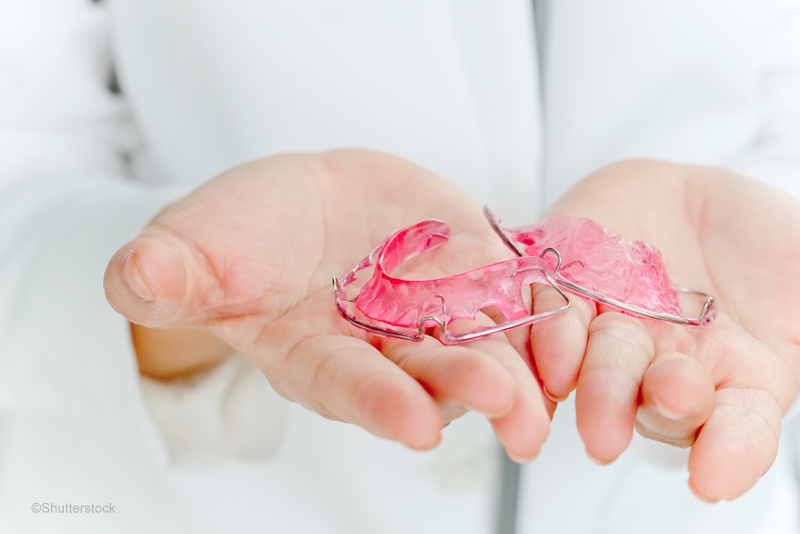
Your routine adjustment sessions were very important for the process of realigning your teeth with braces. Each of these appointments apply successive tension to the periodontal ligaments that anchor your teeth into your periodontal tissues. Now that your teeth have attained their ideal position, Dr. Tony Skanchy can uninstall them from your mouth.
It’s important to understand that there will still be a moderate amount of residual tension in the periodontal ligaments that hold each of your teeth in its socket. If it’s not adequately addressed the lingering tension could cause your teeth to relapse out of alignment.
To prevent a problem of this magnitude, Dr. Tony Skanchy will fit you for a removable retainer immediately after your braces have been removed. The most common type is known as a Hawley retainer.
This is a fully removable mouth piece made from a special dental acrylic. It includes wires that lock the retainer in place with specific teeth. You will need to use your removable retainer for a specific amount of time each day.
If a specific area needs significant realignment, Dr. Tony Skanchy might recommend cementing a metal fixed retainer behind the teeth. This sturdy metal band cannot be removed and will need extra focus in your daily oral hygiene routine.
If you are due to have your braces removed and you have a question about the retention process, you can always call 385-210-0000 to speak to one of the staff members at South Hills Dental Specialists’s orthodontic clinic in Riverton, Utah.
YOUR PERSONAL PREFERENCE AND THE TYPES OF BRACES

When alignment issues with your teeth go uncorrected it can do more than leave you with an unappealing smile. As time goes on the unhealthy angle that your teeth meet at can cause you to suffer problems with dental fractures and dental attrition. Once these teeth have been compromised they will also be at increased risk of suffering severe cavities.
Fortunately, most orthodontic alignment issues can be corrected by having Dr. Tony Skanchy provide you with some form of braces. The type he recommends for you will be based on your personal preference as well as the severity of misalignment.
Traditional braces incorporate small metal brackets that are cemented onto the faces of your teeth. This style of braces also includes wires and other orthodontic hardware components.
If you aren’t comfortable with visible braces or hardware appearing on the teeth in your smile Dr. Tony Skanchy can apply a ceramic glaze to the components. This is a special dental porcelain material that can be shaded to match natural tooth enamel. Once it has been applied the braces hardware will have less visual impact.
If you only need a minor amount of realignment, Dr. Tony Skanchy might suggest a brand of clear plastic braces like Invisalign®. These clear plastic aligners will be designed to match the shape and orientation of your teeth. Every two weeks you will need to switch to another set of aligners. Each set is tuned one step closer to the ideal alignment of your teeth.
If you live in the Riverton, Utah, area and you are contemplating braces, you should call 385-210-0000 to set up a consultation at South Hills Dental Specialists.
ORAL HEALTH CARE FACTS BLOG: ORTHODONTICS

If you are in need of orthodontic care, contact our office for an appointment. Our highly trained team looks forward to straightening your smile and giving you a smile makeover you’ve always wanted. We have a multitude of orthodontic treatments to help correct and fix whatever misalignment may be plaguing your smile.
For a list of guidelines concerning orthodontics, consider these facts:
• In many cases, people often think braces and aligners are only for young people, but they are just as helpful for adults as well and can be used to straighten teeth at any age.
• By frequently wearing orthodontic aligners, retainers, and braces, achieving a set of straight teeth is possible.
• Orthodontists have an immense amount of knowledge given that their training extends well beyond regular dental school to allow them plenty of information to administer treatments that extend beyond the realm of traditional dentistry.
• Given society’s quest for straight teeth, along with its oral health benefits, Orthodontics focuses on doing just that, straightening teeth.
• A straight smile is the goal of orthodontics via modifying malocclusions and any bad bites or disorders that contribute to crooked teeth.
Whichever orthodontic services you feel would best suit your needs, Dr. Tony Skanchy and our team here at South Hills Dental Specialists in our orthodontic office in Riverton, Utah are committed to providing you the service you require. We can be reached at 385-210-0000. Your smile is our business!
DO YOU NEED MALOCCLUSION THERAPY
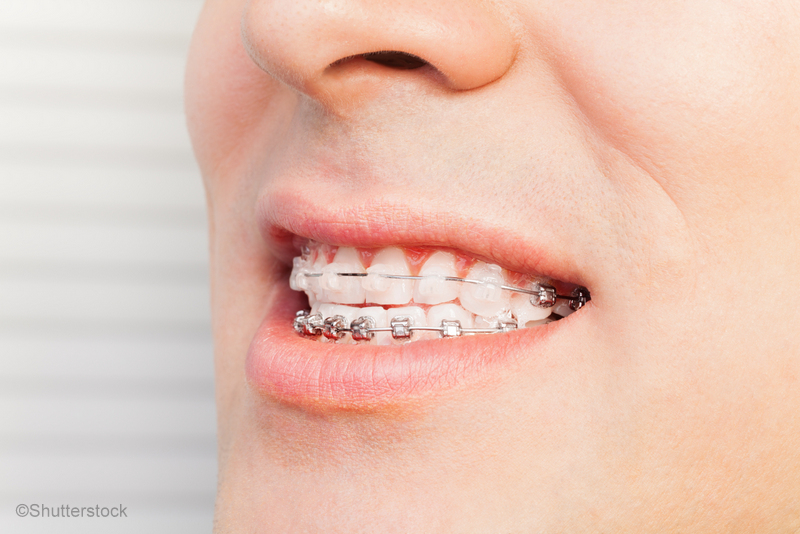
Orthodontics can be used to treat malocclusions. Malocclusions are bad bites that are the result of irregular teeth and jaw misalignments. Teeth that are out of alignment can grind against each other and wear down over time, as well put you at risk for other oral health problems. There are different types of malocclusions:
• If your upper incisors fail to align with your lower incisors, misplaced midlines occur.
• When your upper incisors stick out past your lower incisors, overbites, also called buck teeth, occur.
• In cases in which your lower jawbone sticks out past your upper jawbone, crossbites occur.
• When your lower incisors stick out past your upper incisors, underbites, also called bulldog teeth, occur.
• If teeth are not in their proper location and position, rotation malocclusions occur.
• Teeth that erupt above the gum line in the wrong space are known as transposition malocclusions.
• Overcrowded teeth, too many teeth, and irregular gaps between teeth are known as spacing malocclusion.
• When your upper and lower incisors failed to connect when biting down, open bites occur.
If you are suffering from malocclusions, Dr. Tony Skanchy and the team here at South Hills Dental Specialists in our office in Riverton, Utah are committed to providing you the service you need. We can be reached at 385-210-0000. Your smile is our business!
WHAT’S THE DIFFERENCE BETWEEN A DENTIST AND AN ORTHODONTIST?”

What’s the difference between a dentist and an orthodontist?
We get this question all of the time! When choosing a dental provider, it’s important to understand the difference between an orthodontist and a dentist to make sure you are receiving the highest quality care for your specific situation. Orthodontists and dentists both help their patients improve the quality of their oral health, but their focus is upon different aspects of oral health.
What is a dentist?
General dentists are doctors who receive four additional years of schooling after completing their undergraduate degree to earn either a DDS (Doctor of Dental Surgery) or a DMD (Doctor of Dental Medicine) degree. Some dental programs use DMD while others use DDS, but both use the same curriculum and they are basically interchangeable. Once in practice, dentists treat a wide variety of issues dealing with your general oral health. Some of the DENTIST’S RESPONSIBILITIES include:
• Preventitive treatment
• Fillings
• Crowns
• Gum care
• Veneers
• Bridges
• Teeth Whitening
It is recommended that you visit your general dentist twice a year (and in some situations more oftent) to make sure you maintain the best dental health possible.
What is an orthodontist?
All orthodontists are dentists who receive the same dental degree as their dentist peers, but only 4-5% of dentists go on to become orthodontists. An orthodontist is a licensed dentist who receives an additional 2-3 years of orthodontic-specific education and training, following dental school. Qualifying to be an applicant for an orthodontic program is very competitive. Some orthodontic programs offer a masters degree in dentistry often called a Master of Dental Science (MDS). Orthodontists are uniquely qualified specialists who diagnose, prevent, and treat dental and facial irregularities to correctly align the jaws and teeth. Some of the common problems that orthodontists treat are:
• Crooked teeth
• Overbite
• Underbite
• Open bite
• Spacing
• Crowding
• Jaw growth problems
• Dental habits
As dental health providers, dentists and orthodontists alike know that you hope to make the best possible decisions for yourself and for your family. We all agree that going to the dentist is an essential part of health and happiness. That being said, if you are hoping to treat issues surrounding jaw problems, crooked teeth, crowding, and so on, the American Association of Orthodontists recommends trusting your smile to a specialist who has been specially trained to help you gain your best smile and receive the highest quality care. Dr. Skanchy is a certified orthodontist as well as a board certified orthodontist through the American Board of Orthodontics. He is also an Elite Invisalign Provider. Visit our office today to let us help you start your journey to straighter and healthier teeth!
Thanks for taking the time to read our blog post! If you have any questions regarding treatment please don’t hesitate to ask. To schedule a free evaluation please call (385) 210-1111. Dr. Tony Skanchy is a board certified orthodontist, serving the Riverton, Bluffdale, and Herriman community.
“TEN THINGS YOU MUST KNOW BEFORE CHOOSING YOUR ORTHODONTIST”

Choosing the right provider for your orthodontic care is an important task. To help simplify things, we have compiled a list of items that you should consider when making your decision. Hope this helps!
1. Is the doctor a specialist? Orthodontists are dental specialists who complete an additional three years of training and education beyond dental school to learn the proper way to align teeth. When it comes to your smile you should choose the best! Choose a specialist recognized by the American Association of Orthodontists. Dr. Skanchy is a certified Orthodontist.
2. Is the orthodontist at the office full-time? At South Hills Orthodontics we have one convenient location. You can find comfort in knowing you will have access to the same Orthodontist at the same location throughout your orthodontic treatment.
3. Is the orthodontist a board certified orthodontist? A board certified orthodontist must demonstrate judgement, skills and knowledge that’s required for providing the highest level of patient care. Dr. Skanchy is a board certified orthodontist, a designation held by only 30% of orthodontists.
4. When should I have an evaluation? The American Association of Orthodontists recommends seeing an orthodontist for the first time at age seven. Although many children will not require treatment at this time, others may strongly benefit from simple procedures that minimize the need for tooth extractions and surgical interventions in the future.
5. Does the orthodontist treat adults? Approximately twenty percent of our patients are adults. For many adults, an attractive smile is important to their health and self-esteem. Dr. Skanchy offers a variety of cosmetic approaches to straightening teeth and is a Preferred Invisalign Provider and trained in Clarity clear braces.
6. How much does the first visit cost? At South Hills Orthodontics, your orthodontic evaluation will always be free of charge.
7. Are there family discounts? Yes! Ask about our family discounts when you come and visit.
8. What does the quoted fee include? Here at South Hills Orthodontics there are no hidden fees. Your quoted fee includes everything outlined in your individualized treatment plan, including retainers and follow-up retainer visits up to a year after treatment is completed. You will never be charged for missed appointments, broken brackets, or emergency appointments.
9. Does the practice offer flexible financing and handle insurance? We offer in-house financing, no down payment options, and extended payment plans. We also accept a wide variety of insurance plans, flex spending accounts, and health savings account payments.
10. Does the office have reward programs and contests? We value our patients and sponsor reward programs and contests to show them our appreciation and promote good oral hygiene.
Thanks for taking the time to read our blog post! If you have any questions regarding treatment please don’t hesitate to ask. To schedule a free evaluation please call (385) 210-1111. Dr. Tony Skanchy is a board certified orthodontist, serving the Riverton, Bluffdale, and Herriman community.






